Slovenia 1
Monday morning was a relatively early departure to get out of Venice and onto our bus. We had a water taxi between the 12 of us, eleven tourers and our guide, Ana. Once we got to the bus parking area at the edge of Venice, we met our driver, Sasha, and headed for Slovenia.
The landscape we drove through initially was flat, and crops growing included vines and hay, and stands of trees as there is a rule that 1% of arable land must be planted with trees. There were a few drainage canals and few fences, just along the freeway, but not between fields. I did not see any livestock.
After about an hour, hills appeared through the heat haze ahead of us. We crossed a blue/green river that looked like it had just left a glacier, and soon after crossed into Slovenia. The landscape changed almost immediately. The hills rose higher and were covered in trees, forests even. Ana noted that Slovenia is largely mountainous and forested, being part of the southern Alps, with borders with Austria and Hungary (as well as Italy and Croatia). The area was ruled by the Hapsburgs for quite some time, and formed the border against the Turks during the 16th/17th centuries (I think, I may have the dates wrong). Here hay was being cut, and I did see cows, goats and horses in various fields, as well as vegetable patches and other areas of crops.
We arrived at the Postojna Caves in early afternoon, with time for a quick snack before heading below ground- or rather, into the mountain. The Postojna Caves are very extensive. We travelled the first two and a half kilometres into the caverns by means of a little electric train. This as partly because the outer area of the cave had been used by the Germans to store aviation fuel, which was blown up by Slovenian partisans. The resulting fire burned for a week and destroyed the formations in the front part of the caves. We soon emerged into areas where spotlight illuminated limestone features. After alighting from the train, we walked through vast caverns thickly populated with all kinds of limestone formations. It was all quite remarkable and each cavern improved upon the last! I was amazed at the sheer number of stalagmites, stalactites and full columns, some very large diameter. We climbed Great Mountain, a steep slope within the cavern from where we could see all sorts of formations. We crossed the Russian Bridge, so called because it was built by Russian prisoners of war, in WWI. Shortly after we crossed the bridge, we could see below us a formation called the Leaning Tower of Pisa – it looked very like a leaning tower! Later we walked past it again on a lower level. Meanwhile, the lights went out, showing how completely dark it is in the natural caves. Possibly it was not meant as such a long black-out, there was a thunderstorm going on outside. Lighting restored, we went into the ‘Spaghetti Cave’ where thousands of fine white stalactites hung from the ceiling, looking just like strands of spaghetti.
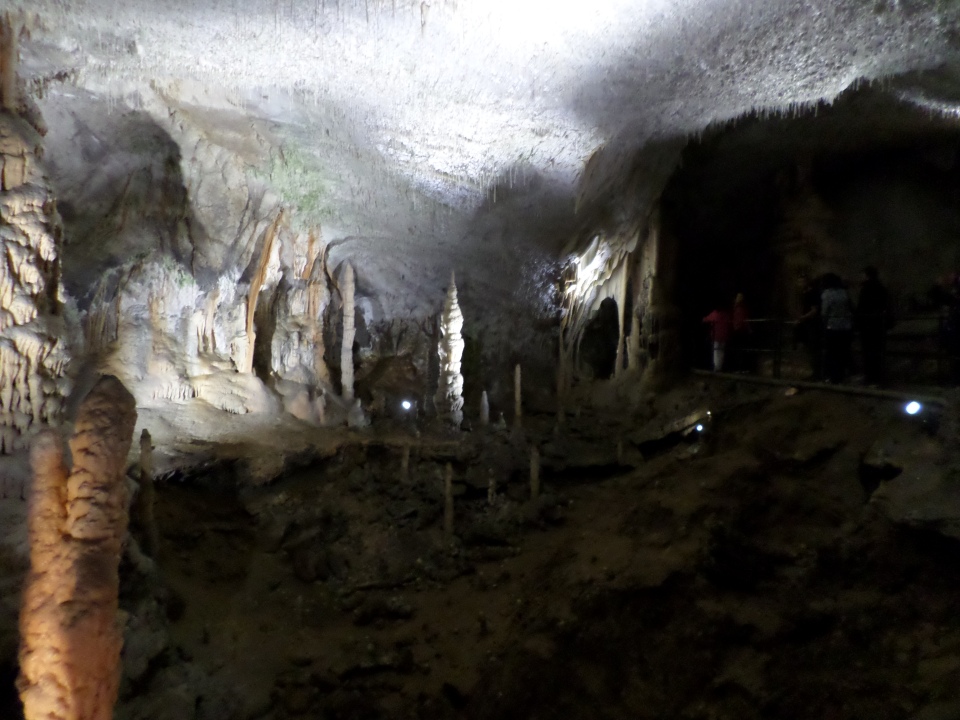
The show-piece of the caves are an immense pillar in reddish limestone, with drip features, standing next to a large stalagmite in brilliant white limestone that is more a pile of flow-stone, looking like two scoops of half melted vanilla ice-cream.

We had the chance to admire one of the animals that live in the cavern pools, proteus anguinus, otherwise known as a ‘human fish’ and is an aquatic salamander. It is amphibious, has only vestigial eyes and is sensitive to smell and noise. It has white smooth skin (when clean!) and tiny little limbs on its elongated body. It was found in the cave in the 19th century and had naturalists enthralled, as they had thought that nothing could live in the caves. Now, many more cave dwelling species have been found.
Back out in the world, the thunderstorms had moved on, and we had another short break before climbing back on the bus and heading for Ljublijana. Unfortunately we did not get to see the castle, Predjamski Grad, that is built into a large cave opening further round the mountain. We did get a view of the village, across the river that flows through the caves on a lower level.
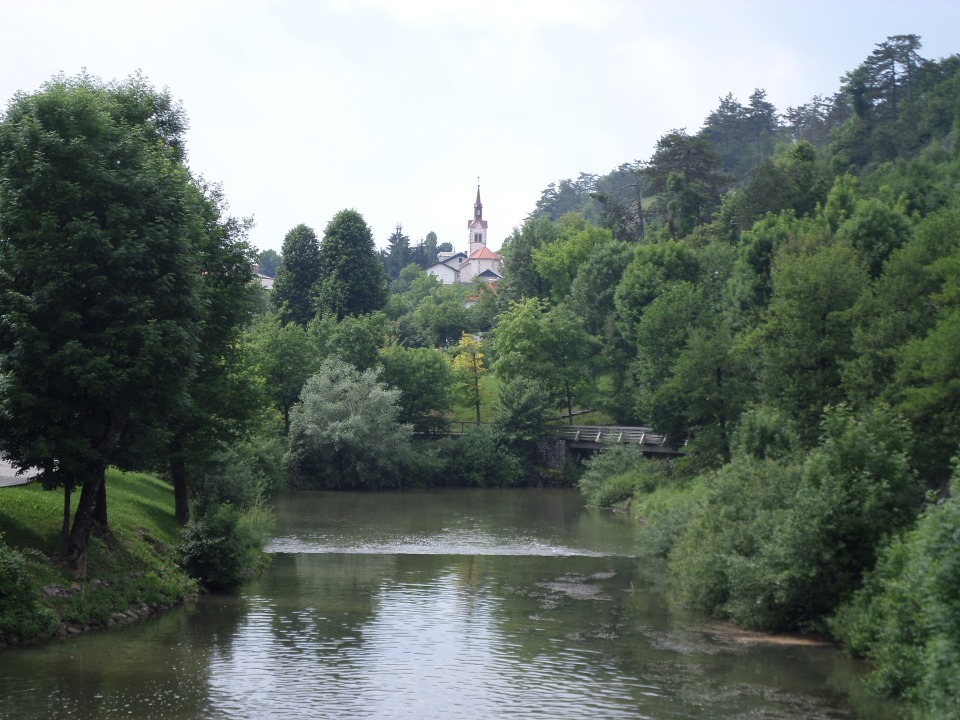
In Ljublijana we met up with a local guide who took us to the funicular railway up to the castle, looming over the town. Near the bottom of the railway, we saw an unusual water fountain.
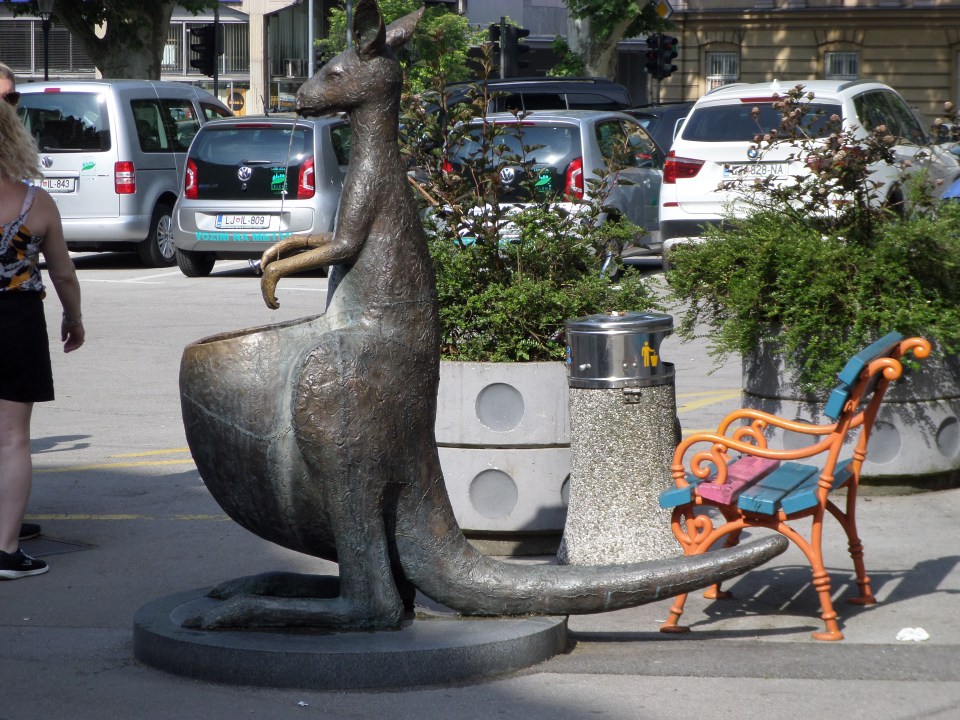
Ljublijana Castle was restored in the 1990’s, and has a modern looking restaurant and courtyard where weddings are often held. The walls and towers are a bit more in keeping with the age of the castle. It was used as a prison for some time in the 19th and early 20th centuries, mainly for political prisoners and prisoners of war.
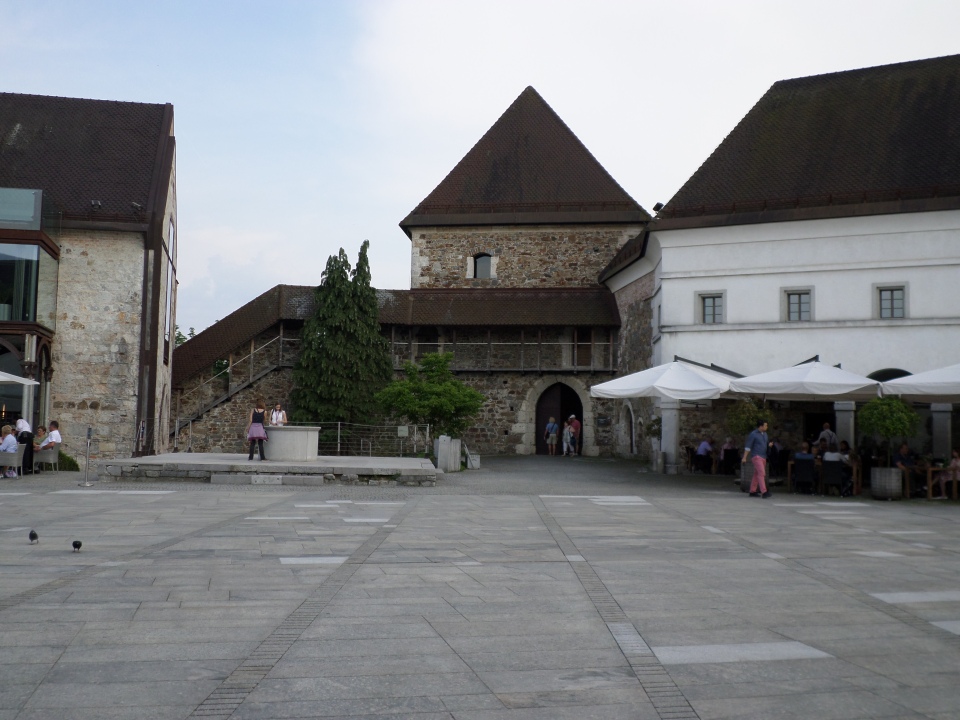
Next to the cells is a chapel, with many coats of arms painted up on the walls. One fellow tourer pointed out that at there was a Ulrich Graf von Schaumberg and a Rudolph von Lichtenstein, as featured in the Knight’s Tale, which was filmed in Slovenia.
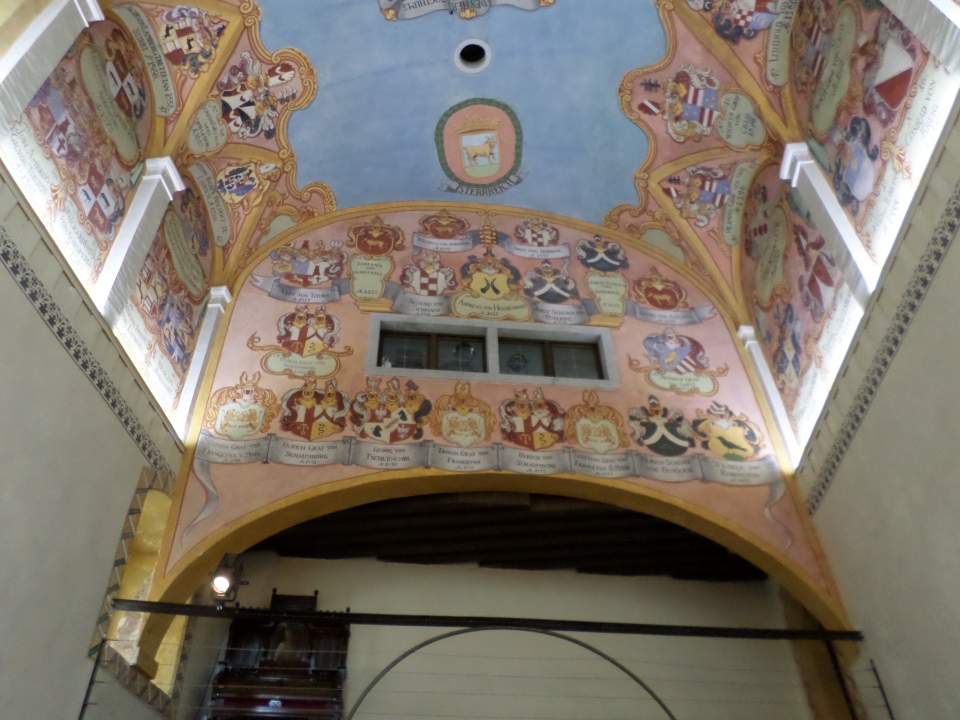
There was also an exhibition about dragons, in a general purpose sort of hall or cellar, further along the castle wall. In here there were displays about dragons, and above these a wire rendition of a dragon, that cast very dramatic shadows.

We went outside the castle to look at views of the city, although I was focused more back to the castle itself.
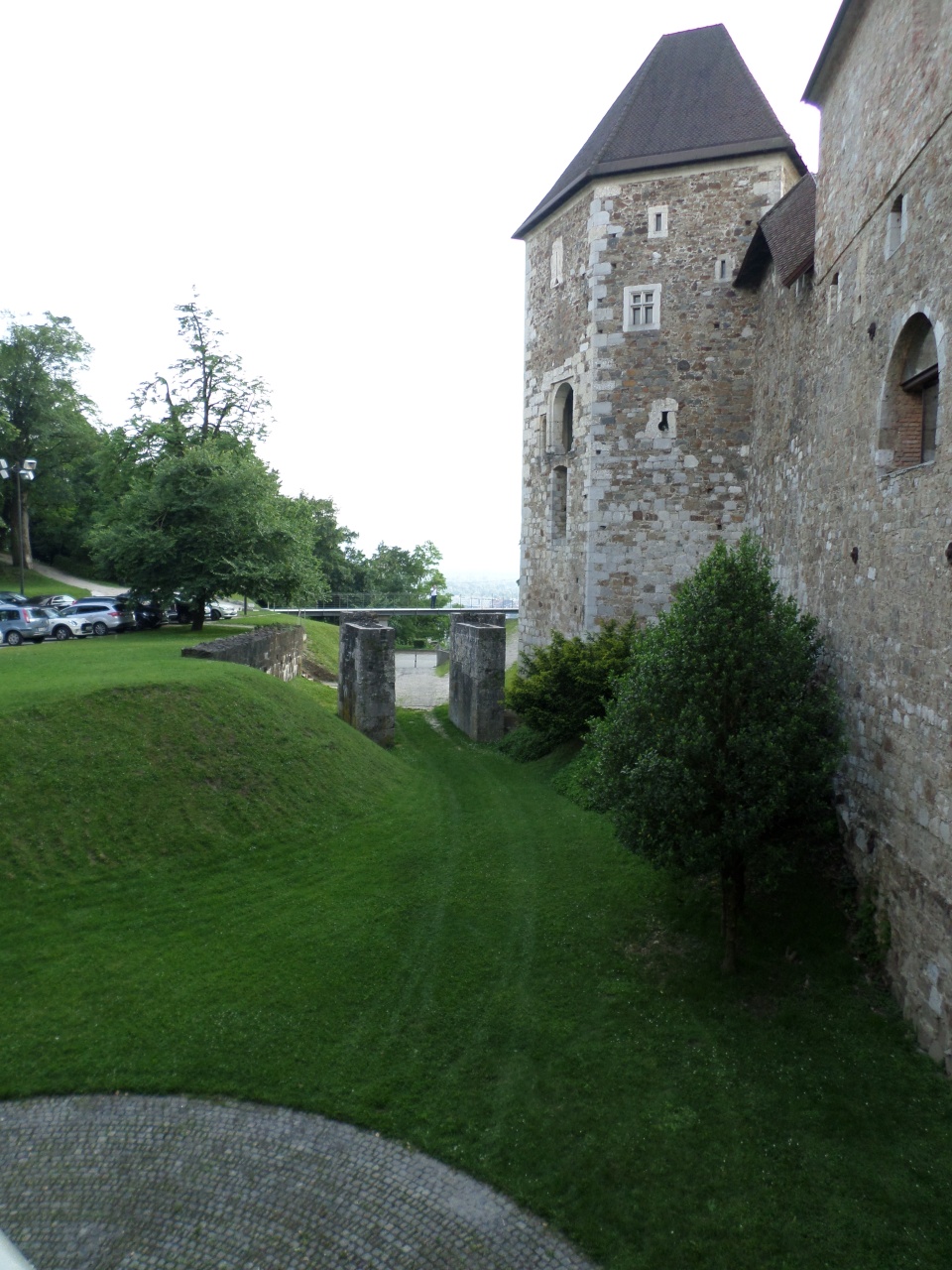
We were supposed to descend via the funicular, but the queue was so long that we decided to walk down. This was lovely as we walked through beech (?) woods and listened to many birds chattering in the trees.
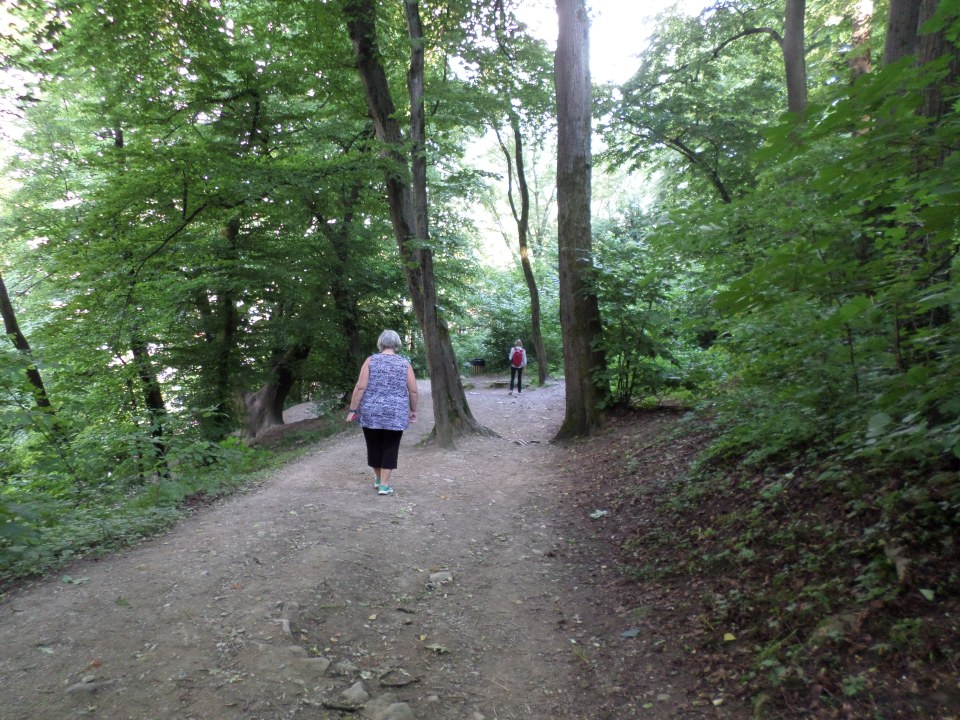
Down in the town, we walked to the main street which runs past the Cathedral. This laid claim to great history by including in its walls the grave markers of Romans, left by the Empire. It also had the reliefs of bishops’ heads on the south door. Across the little square was the Town Hall, with flags, and a fountain. We were ushered into a chocolate and souvenir shop to taste salty chocolate (yum) in the hope of purchases by us. I bought a small dragon.

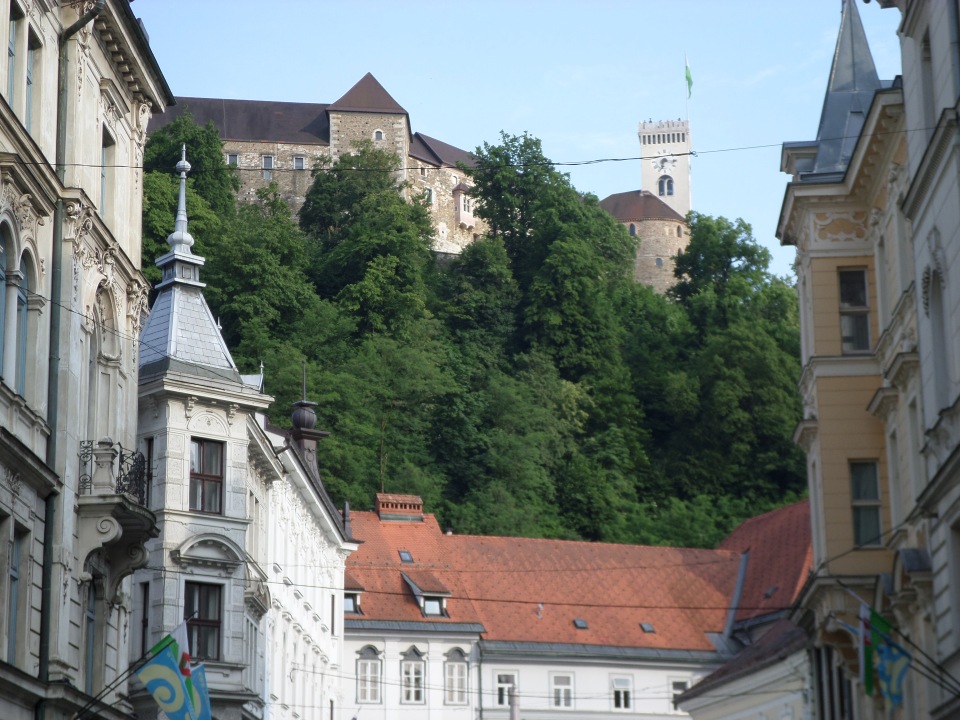
Crossing the river on a triple bridge, we came to another square (or open place) in front of a Catholic church, with a statue of a famous poet staring into the distance. Because his poems dealt with his unrequited love or a young lady (coincidentally called Juliet) a statuette of her gazing out of a window towards him was added later!

We proceeded down a river-side street and over a second bridge, adorned with many padlocks (for love…) then along the other side to the Dragon Bridge, guarded at each end by two dragons, on which the wire model in the Castle exhibition was modelled.
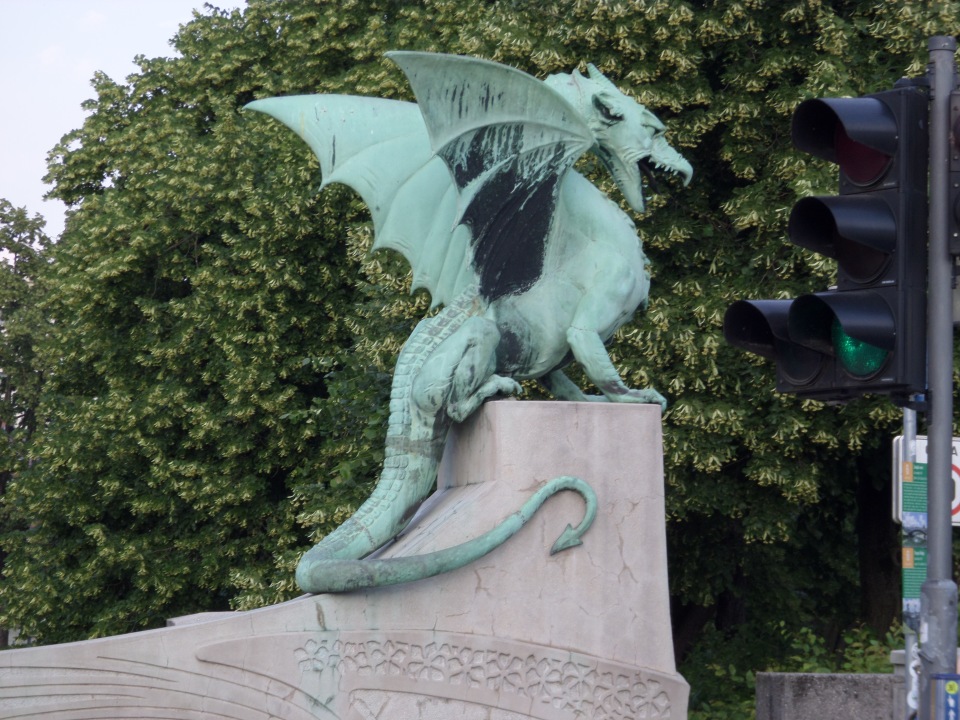
Back on the bus it was about 40 minutes to Bled, and our hotel for the next two nights, getting in about 7:30 pm. Some of us joined up for a meal a short time later, but had difficulty finding a restaurant that would take 8 people. Ultimately we ate at a grill, that charged by the 100 gms for steaks, but then did not allow one to determine the size of steak that one wanted. I ended up eating far more meat than I really wanted. However it was very tender and juicy and served with grilled zucchini and capsicum made a great (if expensive) meal.
Venice 5
Sunday: a fairly free day today, just the first meeting with the Peregrine Tour guide and other travellers at 6 pm. Thus we had a leisurely start. We decided to make our way over to the Rialto area, to an upmarket store that has built a terrace on its roof, overlooking the Rialto Bridge and Grand Canal. On the way, we went past the Venice Opera house, just behind our hotel.

Once we got to the store, we found it was once a post office with a very impressive central atrium! We found that access to the roof terrace had to be booked in advance, so we promptly booked for an hour in the future.

Thus we retired to a cafe that we had passed earlier for a cool drink and cake. It turned out that the cafe opened in 1750, and was the favourite haunt of a famous playwright of the time (or shortly after), Carlo Goldoni, and the cafe is mentioned in one of his plays.
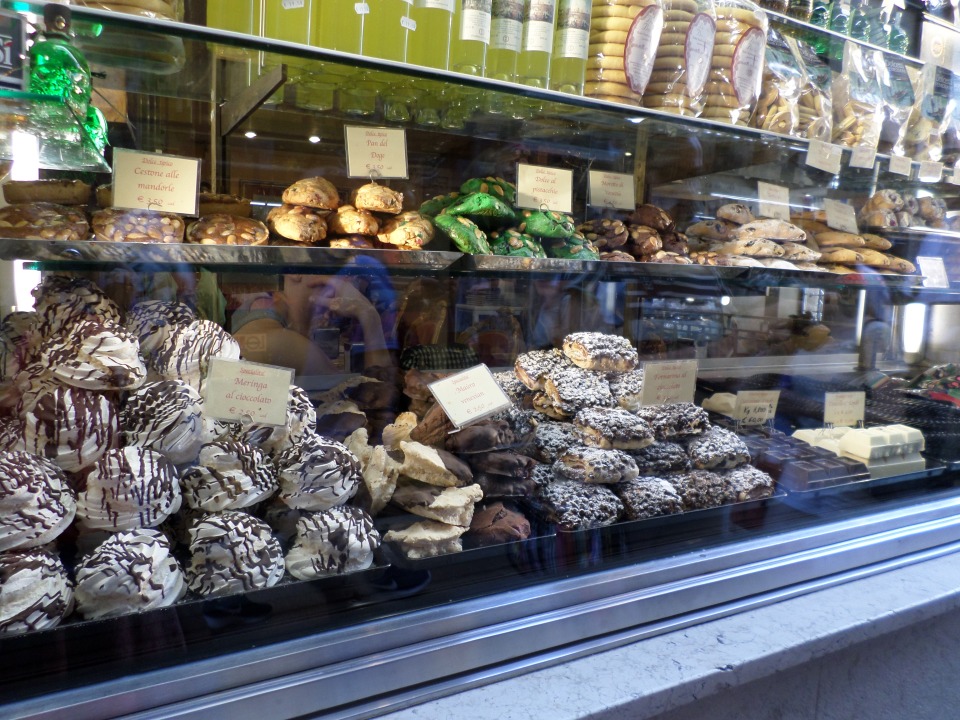
Back on top of the former post office, we waited for our booked time beside an art installation by Elisabetta Di Maggio, which took the form of a mosaic made with used postage stamps. It was rather effective.
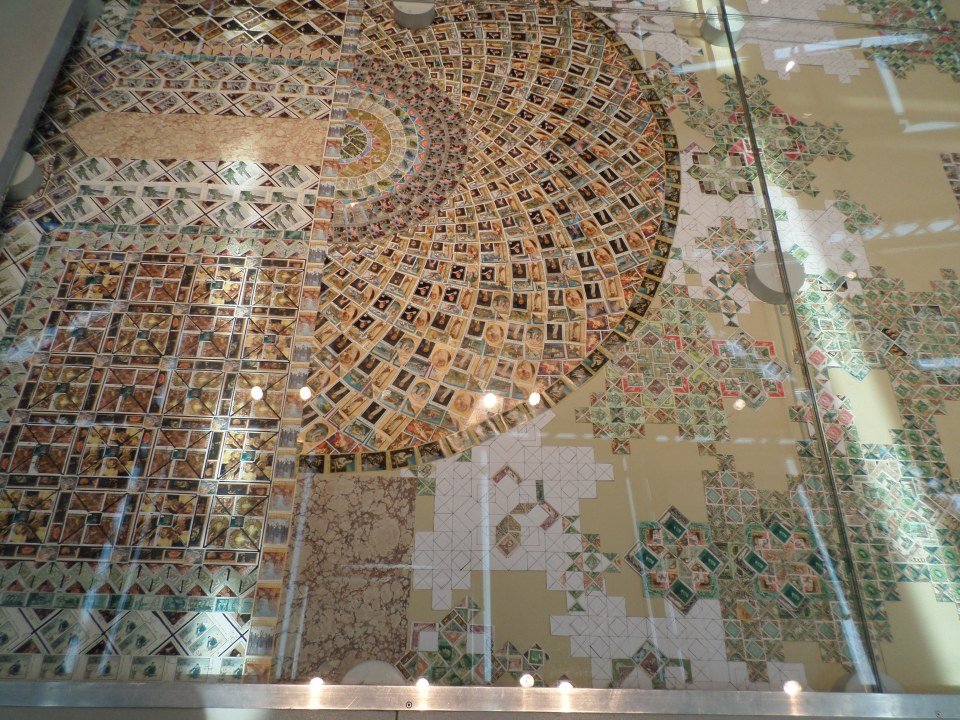
Our fifteen minutes on the terrace was well worth it, with sweeping views over the rooftops with various bell towers standing out above them. There was a great view up and down the Grand Canal. In one direction we could see four cruise ships at anchor, and in the other, the domes of the Basilica San Marco and the tall bell tower near to it.
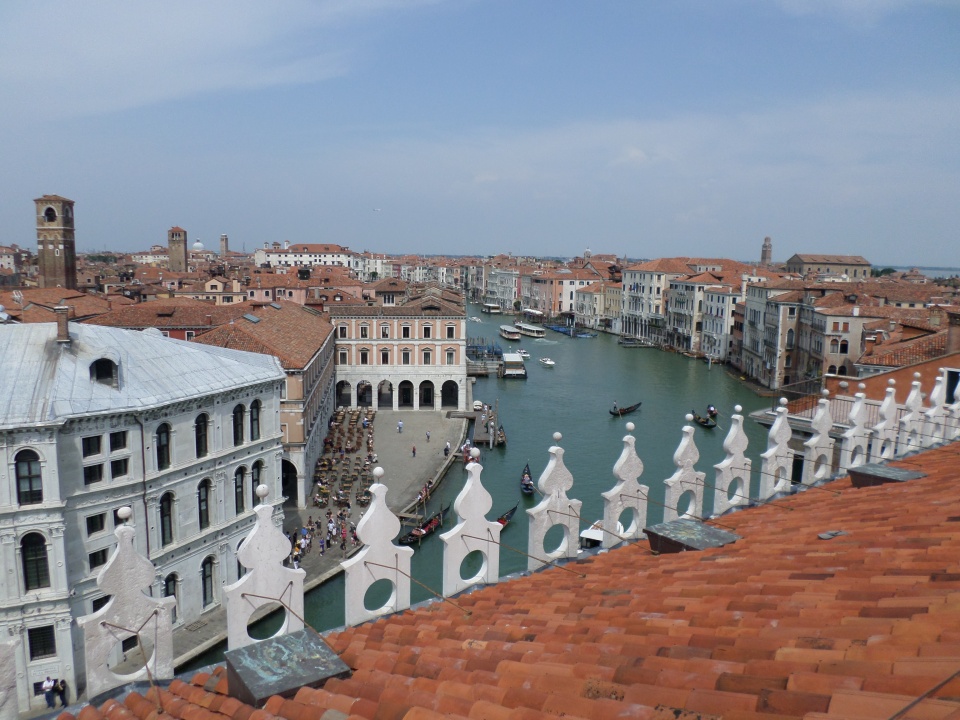
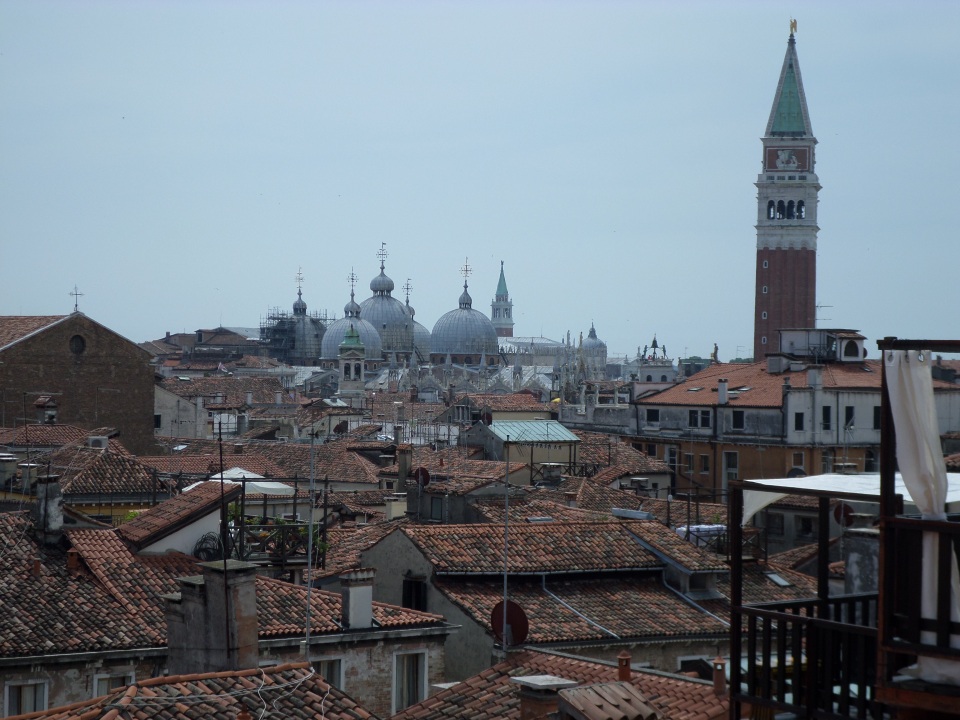
We returned to our hotel to relax and write, then headed out for a late lunch in one of the squares we had walked through earlier. A huge salad with chicken really hit the spot for me and felt very healthy. Back to the hotel to relax a bit more, as the next 8 days on our Peregrine Tour are likely to be busy.
Venice continually delights with interesting vistas down narrow canals and calles, with lovely old buildings and unexpected window boxes or geraniums.
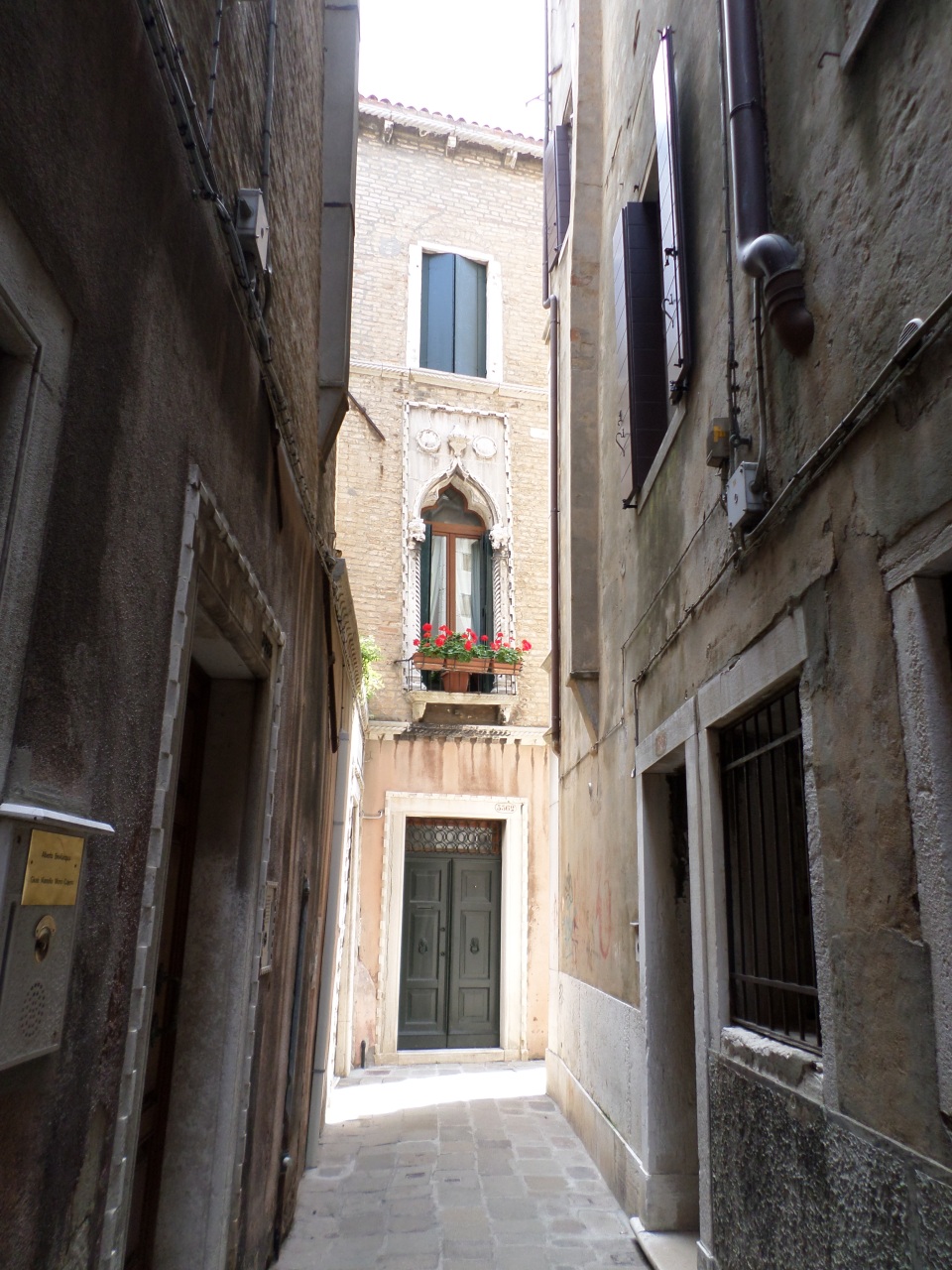
1467
Venice 4
Saturday – Murano and Burano by boat. The meeting point for the trip was further along the waterfront, beyond the Doges Palace. This gave us the chance to photograph the Bridge of Sighs, apparently so named by Byron. We had to dodge several waves of other tourists on guided tours, but managed to fit in between to get the shots we wanted.
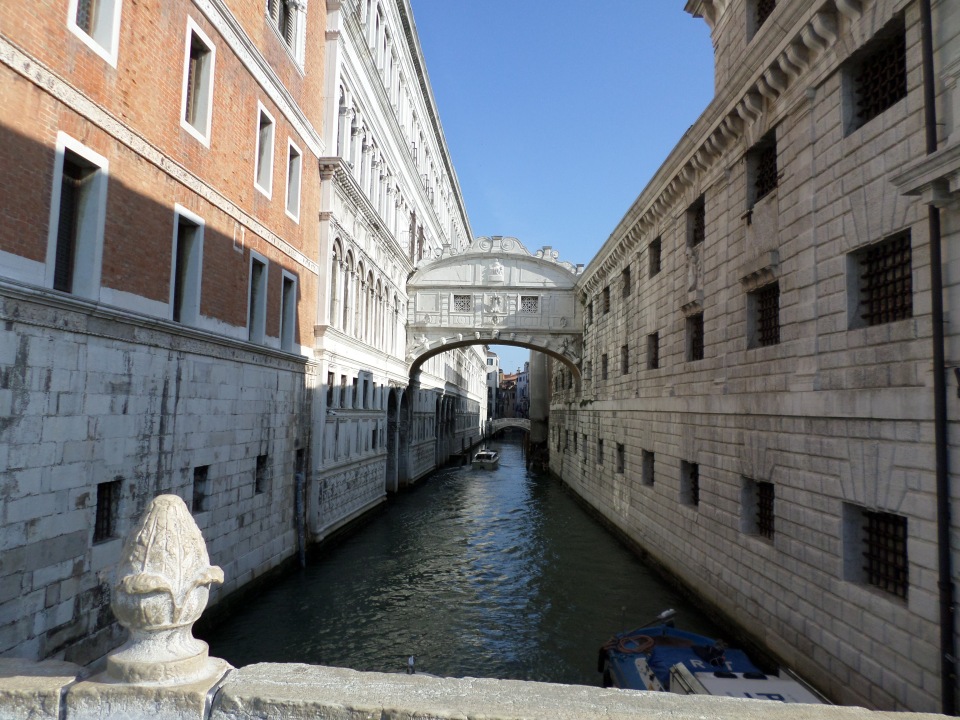
We got to the meeting point a bit early so wandered into the back streets and found a leaning tower as well as a practically deserted square to sit in, under a tree. To Shirley’s delight a Cavalier Spaniel arrived with its owner and a ball, so she was able to get in some doggy time.

Back at the meeting point our guide (looking rather undistinguished in a golf shirt) gathered up his twelve charges, and we moved aboard a launch to take us out to Murano, to a glass factory, Colleoni. There, a maestro showed us how to collect a gobbet of molten glass on a hollow pole and then turn it into a glass bowl. He also demonstrated making a little horse. He then blew some glass into a tissue thin bubble, which broke and we were given some shards, to see how light and flexible it was. At that thinness it cooled quickly, but both the bowl and horse were still so hot after making that they ignited paper!
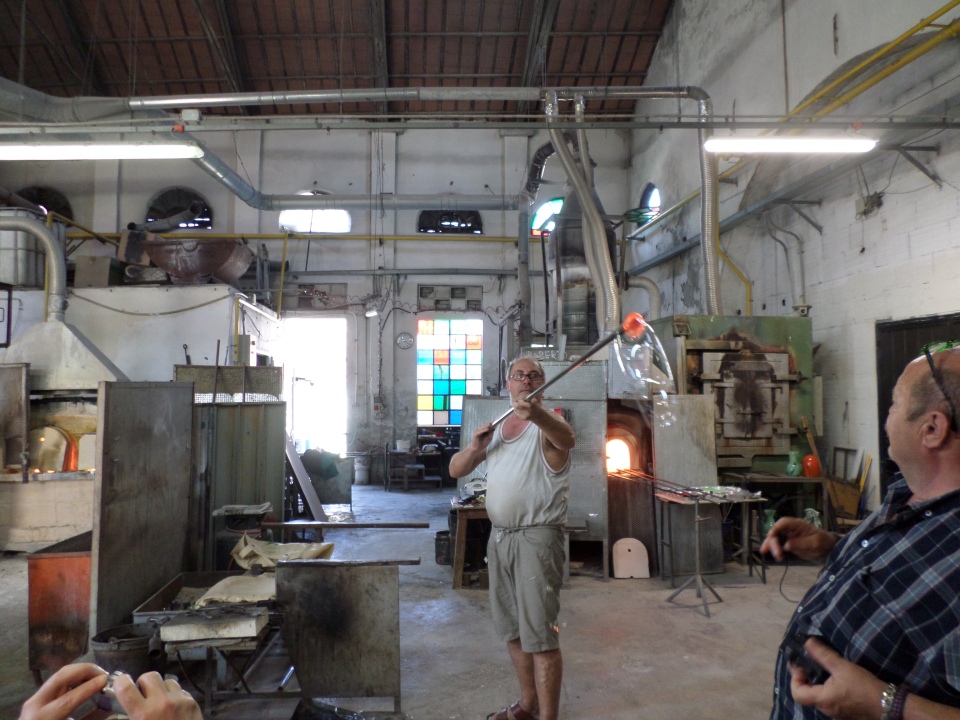
Then, of course, we had to walk through the showroom and were encouraged to buy with a ten percent discount. The horse figures were 30 Euros, but were not that good. I bought only a little bracelet with pale green glass beads (for 9 Euros). There was a lot of beautiful glassware, both table glasses and wine glasses, as well as numerous very ornamental objects and all kinds of jewellery.
We re-embarked on a different, smaller boat and were taken to Burano, via the main canal of Murano which was now getting quite busy. Each major glassworks appears to have its own jetty and tours coming in. We motored past an old church, one of the first built on the island (so 12th century?) which we were supposed to visit but it was closed.
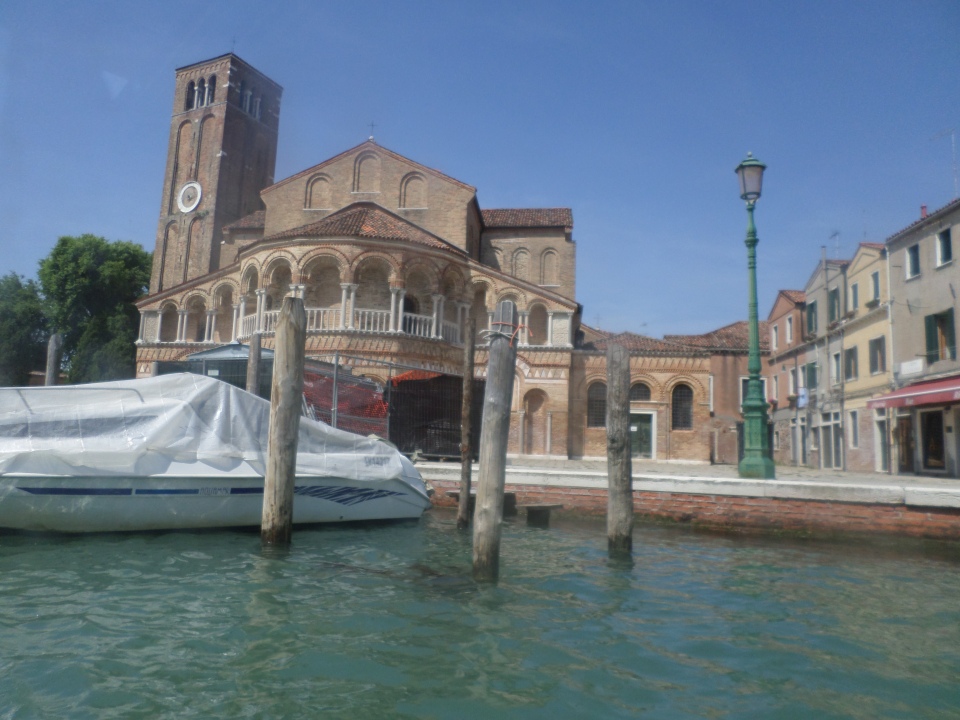
On the way to Burano, we were provided with a plastic cup of prosecco, and we chatted amongst ourselves. In the back of the boat we had two American couples and one British couple besides ourselves.
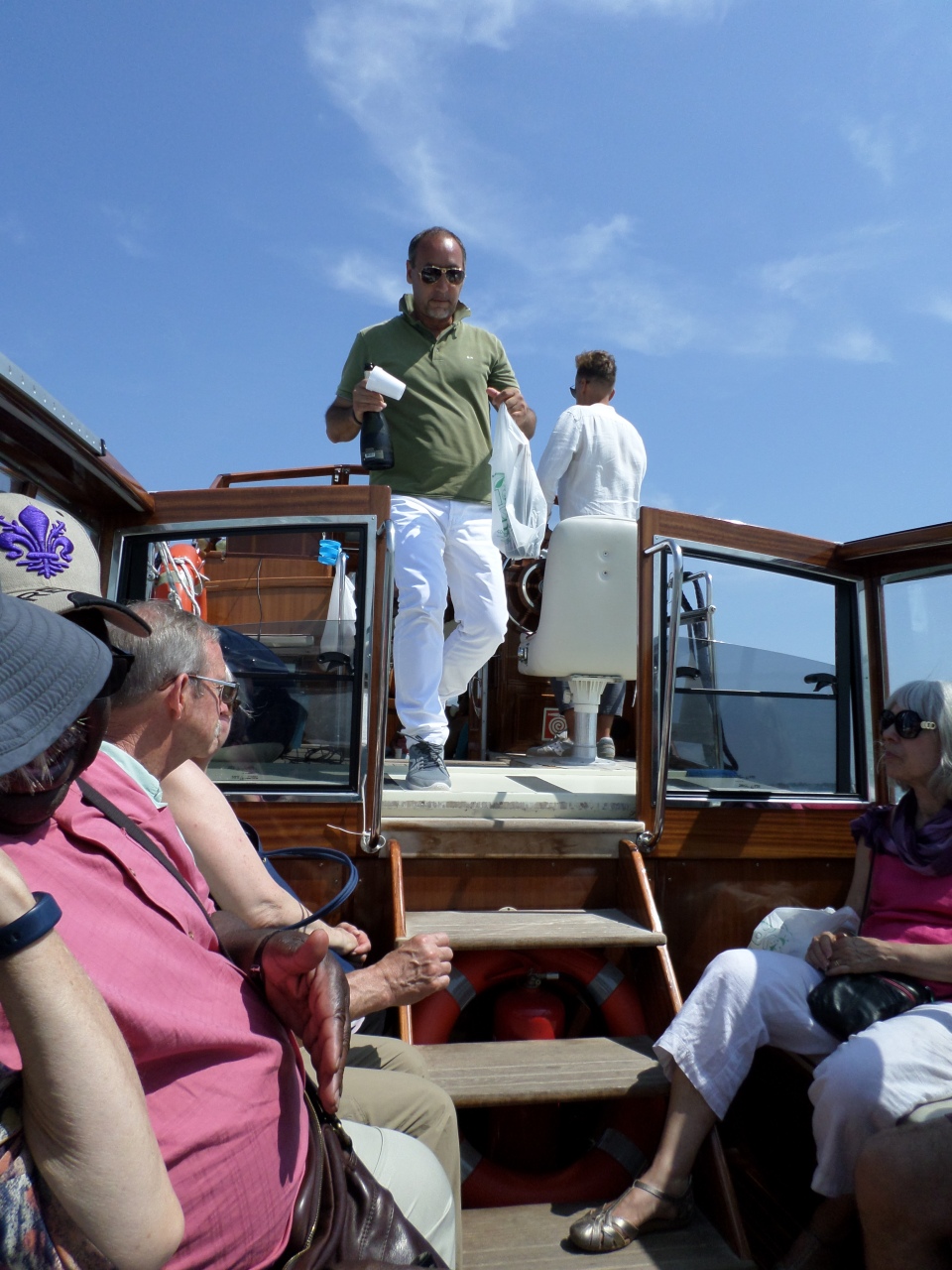
On Burano, nearly all the houses are painted in bright colours, making very colourful street scenes. The houses have to be repainted the same colour, in keeping with the preservation of the historic atmosphere.

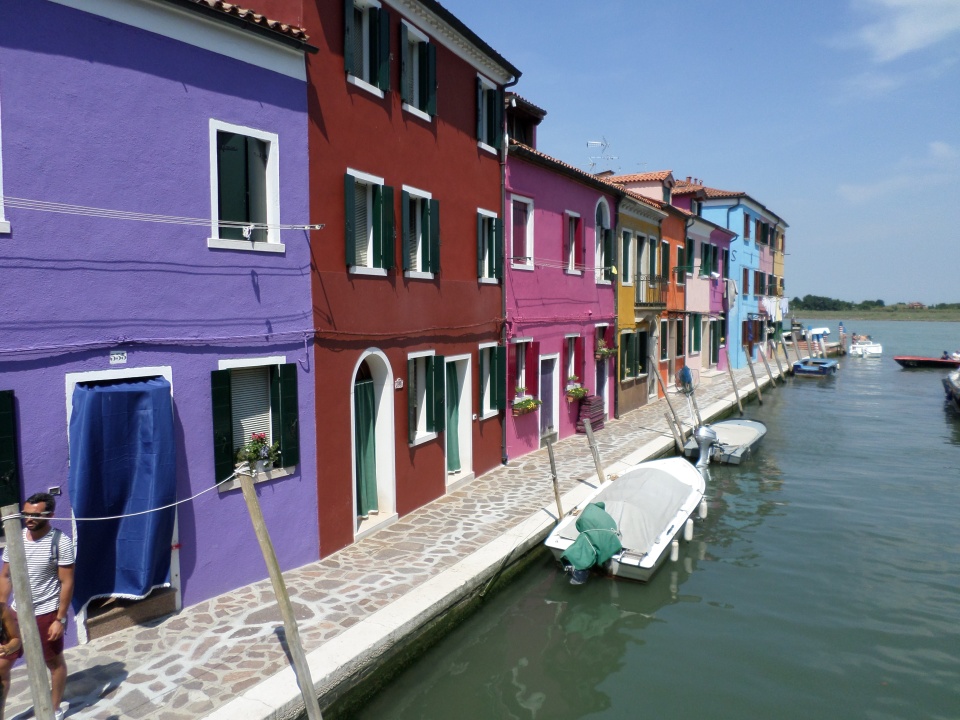
Burano is also noted for its lace and embroidery, and we were taken to a shop on the busy main street. Here lace making was explained, especially regarding its high price, and we were then enticed to buy. There was some lovely stuff, including Christmas themed table clothes and runners.
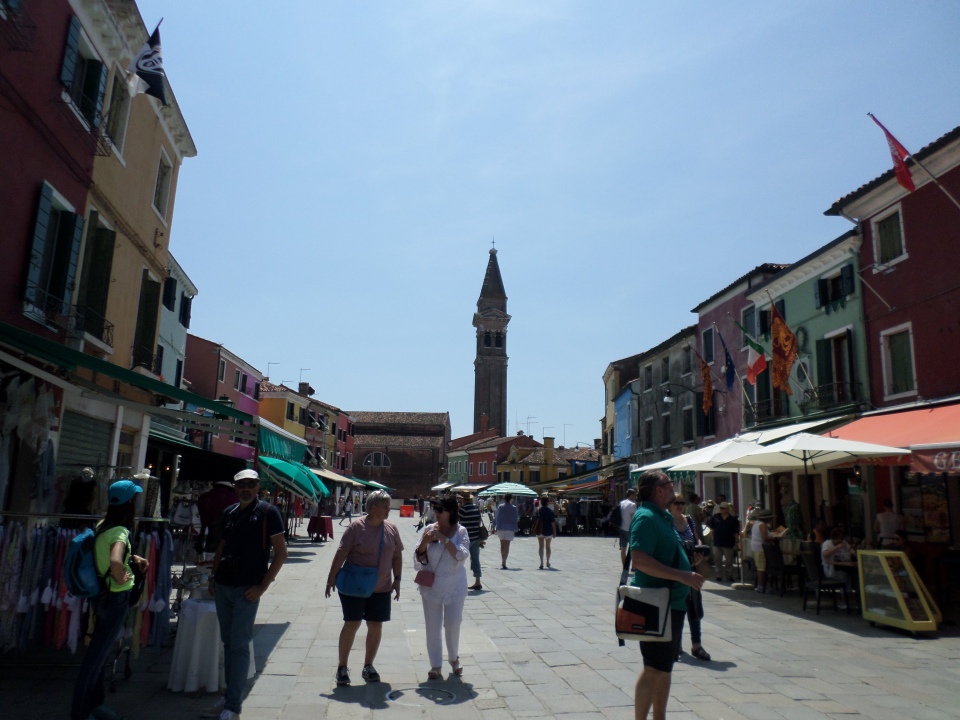
Most of the group joined the guide for lunch at a Burano restaurant. Burano is also a fishing port and has a good reputation for seafood. We had a typical seafood meal in a nautically themed room at the back of the restaurant. The entrees were bowls of tiny sweet shrimp, sardines in onion and snapper marinated and crushed in olive oil. All three were really delicious, but I think the snapper was the best. This was washed down with an apperol spritz. Then the prosecco was poured, served with mussels. These were really nice too – delicate and easy to eat (not tough and stringy as I usually find them). The main courses were seafood with a risotto or in a tomato sauce with penne. Both dishes were beautiful (and more prosecco found its way into my glass).
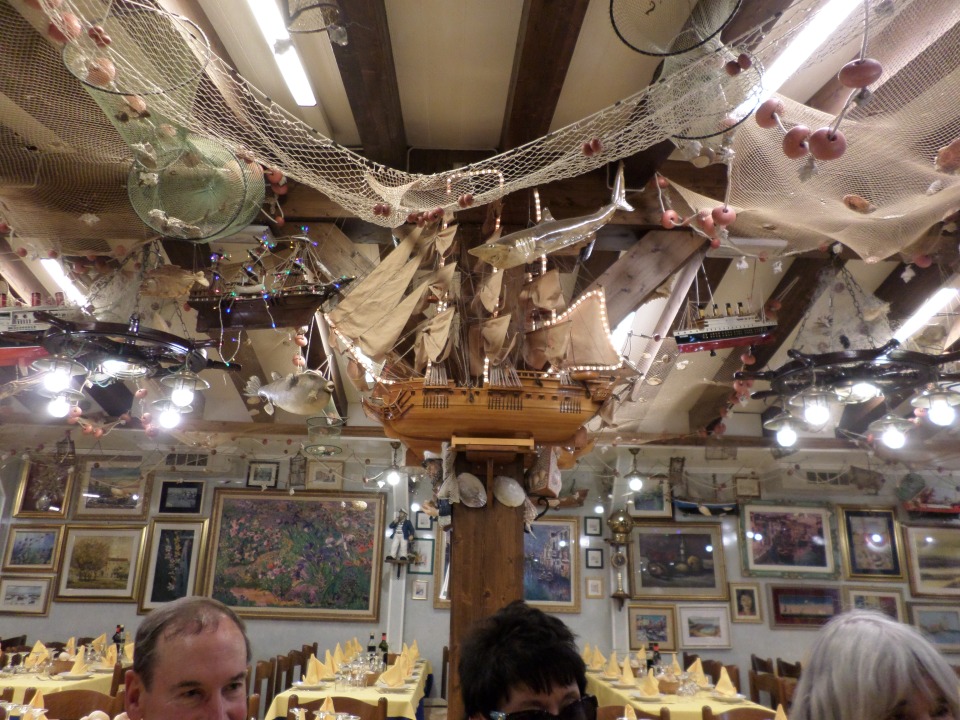
All too soon it was time to head back to the boat, and we were delivered to San Marco, but we had to walk back to the hotel. Once there, I had a little nap, for most of the rest of the afternoon.
That evening we went to the restaurant that we could see out of our room, Vino Vino. The waiter guided us through the building and out into a charming courtyard. The walls were hung with flowering jasmine and vines were twined along overhead wires. I had a rather nice aubergine casserole with tomato and cheese, not too large and no wine, after such an enormous lunch.
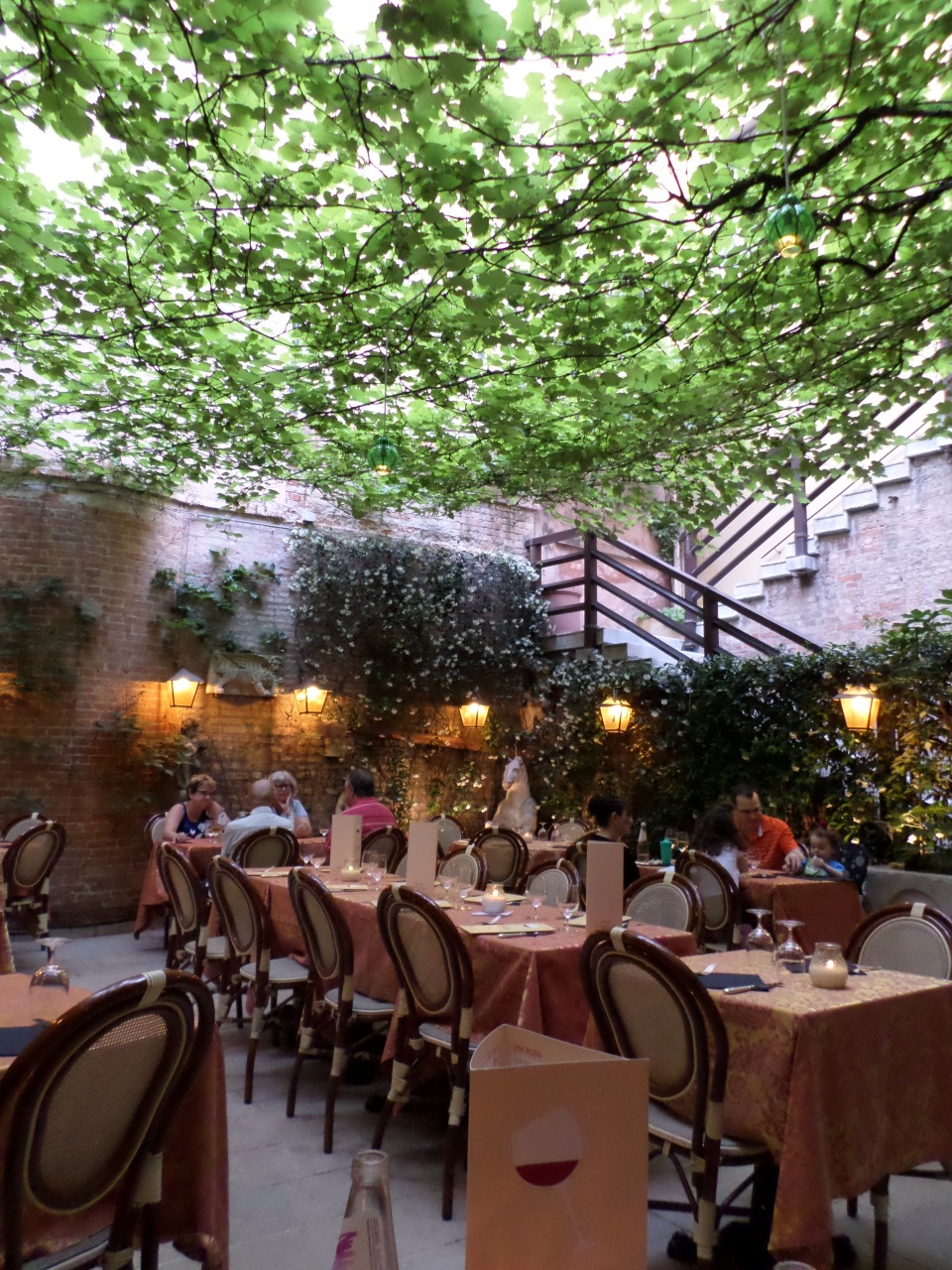
Venice 3
Friday: a slower start to the day as we did not have to meet up with our tour until 10 am. There were only 6 of us, in our own water taxi along with the guide, Christina, and the driver. We headed out into the lagoon and along the coast of the main island, to a green treed area that is the site of the Biennial art festival, this year the theme is architecture. We took a narrow canal along-side the gardens and went past the Australian Pavilion. Different nations have built galleries or exhibition spaces for their artists, who stay from one Biennial to the next, when the next theme starts. The Australian Pavilion is a black box.
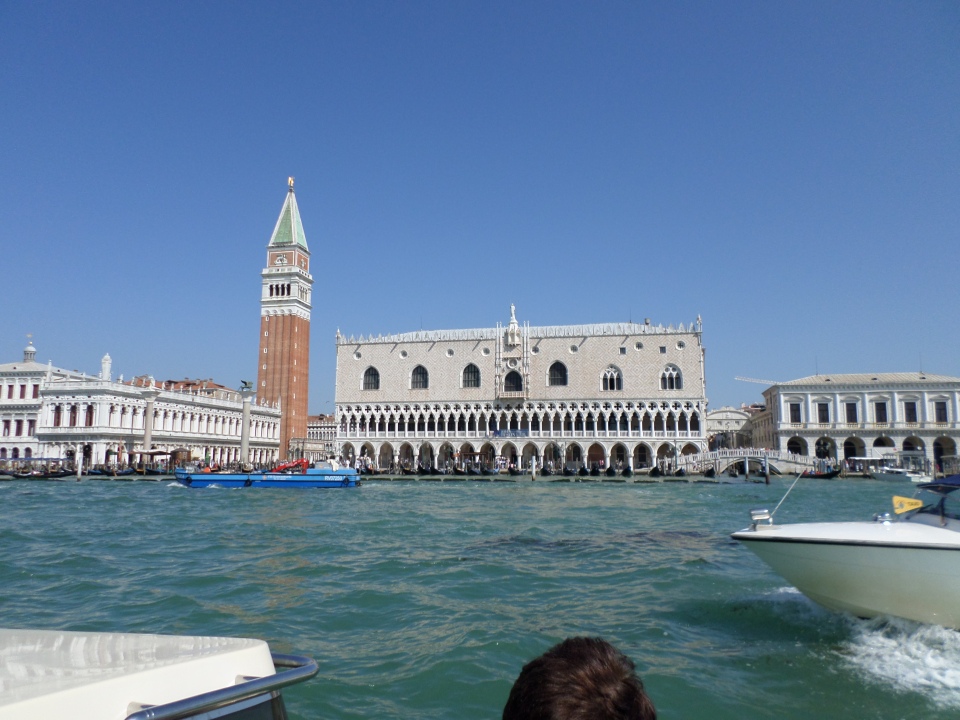

We proceeded into the Arsenal, where ships were built for centuries. They claim to have been the first place to use an assembly line, and to be the busiest shipyard up to World War 1. Now some of the space is used for the Biennial, and some still houses repair facilities for boats and ships,and there is a submarine pulled up in a dry dock. It was a well guarded facility, walled with a defended entry. Apparently, in earlier times workers were paid a pension so that they would not go and work elsewhere taking the secrets of Venetian shipbuilding with them. Thus they also claim the world’s first pension scheme.

As we proceeded further along, other points of interest were identified. We went past the Hospital, with its dock for the ambulance boats. Of course, ambulances would be boats! We were shown the Cemetery island, which Napoleon designated – the only good thing that Napoleon did for Venice, we were told; and Murano, where the glass factories were moved to in the 12th century.

A little later, we entered the Cannareggio district and followed a canal to the Campo de Gheto Novo. This was once the site of a foundry (getto) and was given to the Jews to live in, in the early 16th century: thus the derivation of ‘ghetto’, at least according to Italians. Here we disembarked and walked through the area. There is a small memorial to the 200 Jews who did not survive the Nazi concentration camps. Campo means small field and is applied to smaller open places, usually with a well. There were several synagogues facing the Campo, but they were not obvious. They looked like ordinary buildings, but had some Hebrew words identifying them, or a small star of David.
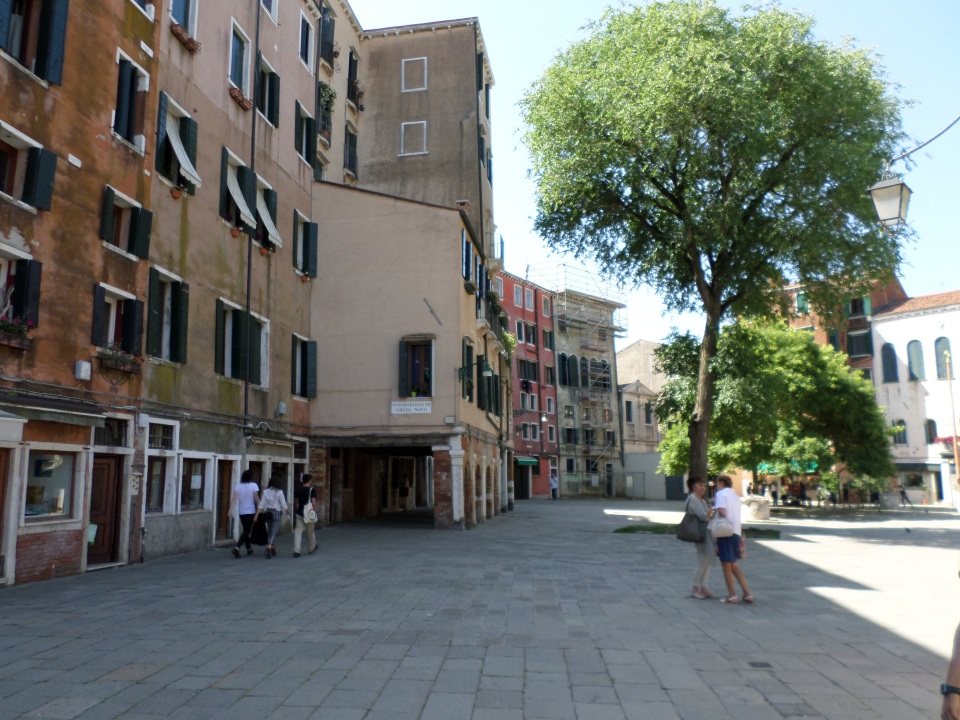

We stopped at a kosher bakery, to try some of their wares. I had a carroway flavoured crisp biscuit about 10 cm across.
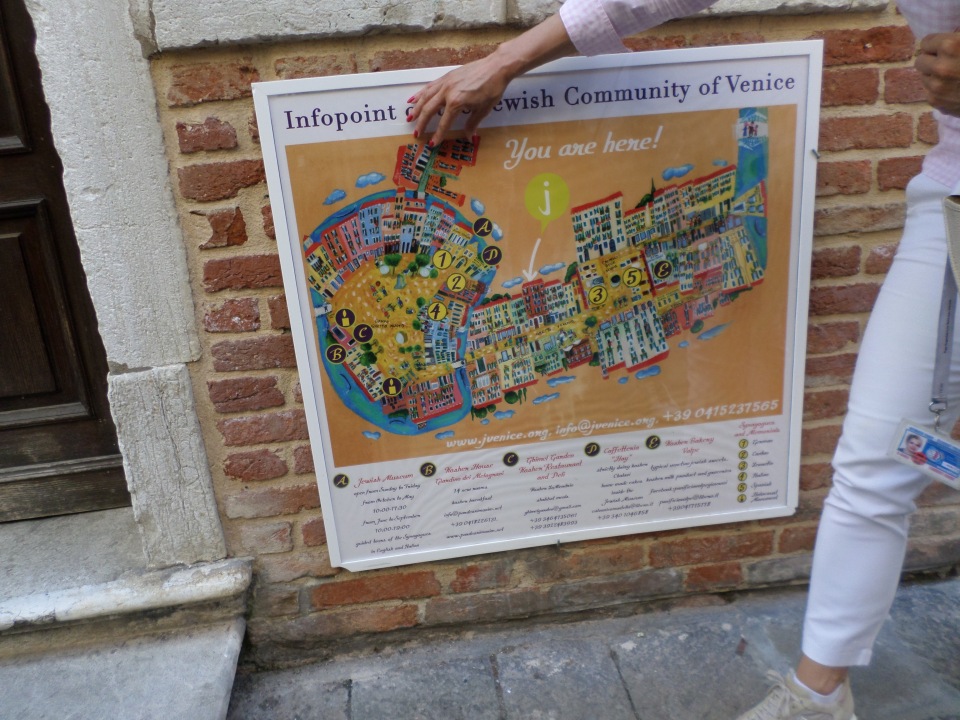
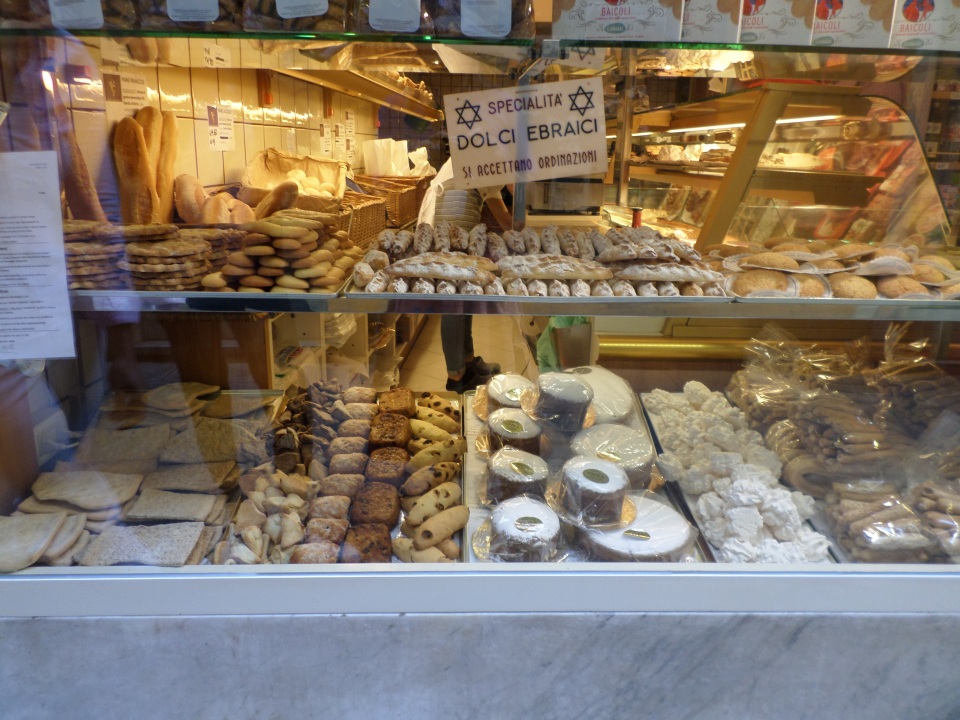
Walking on we came out on another canal, where our water taxi was awaiting us. From here we motored out into the Grand Canal. This was very busy withal kinds of water transport. Our guide pointed out one palace or fine building after another. We rounded a curve, and there was the Rialto Bridge, spanning the narrowest part of the Grand Canal.

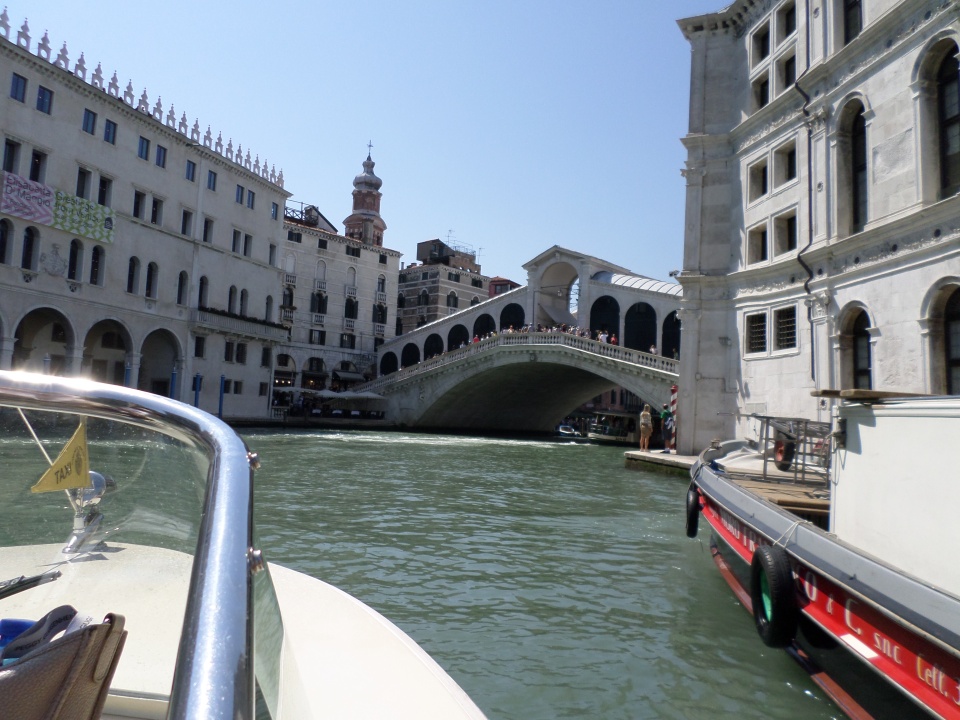
Continuing, we saw more palaces, then went under the Academia Bridge, currently under repair and scaffolded out of sight. We turned right here, and motored through the Dorsoduro sestieri (district) and out into the Giudecca Canal. Across the canal and down a bit we could see the large building that once housed a wheat mill and pasta factory, but is now the Hilton Hotel. It was also pointed out to us that the south facing shore of the island gets the sun all day and so is very hot, but that it also has many restaurants and bars and a lively night life.
Ducking back into the narrow canals, we were shown a gondola building workshop, where two gondola were under construction. They have over 400 parts, and 20 layers of black lacquer to finish them. Unusually for Venice, the buildings of the factory are of wood.
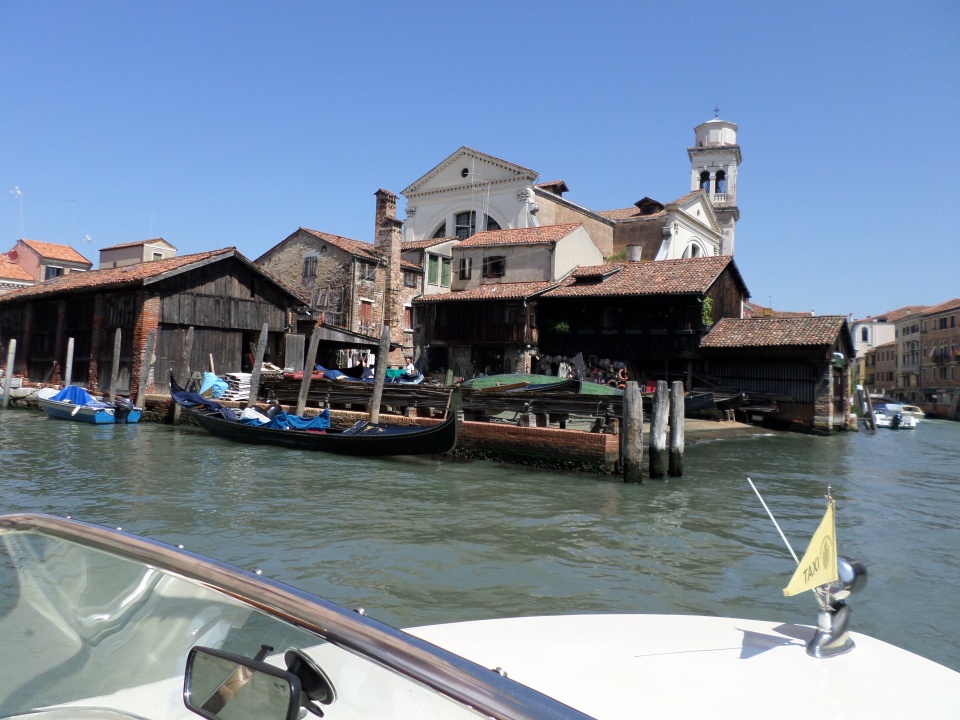
Continuing on we came back out onto the Grand Canal, and passed under the Academia bridge again. Passing more imposing palaces, constructed to show off the wealth of competing noble families, one used to be faced with gold leaf, others had brilliantly coloured frescoes (now nearly disappeared) and others creatively styled windows and balconies. Soon we were back at Piazza San Marco and farewelled Christina and our driver.
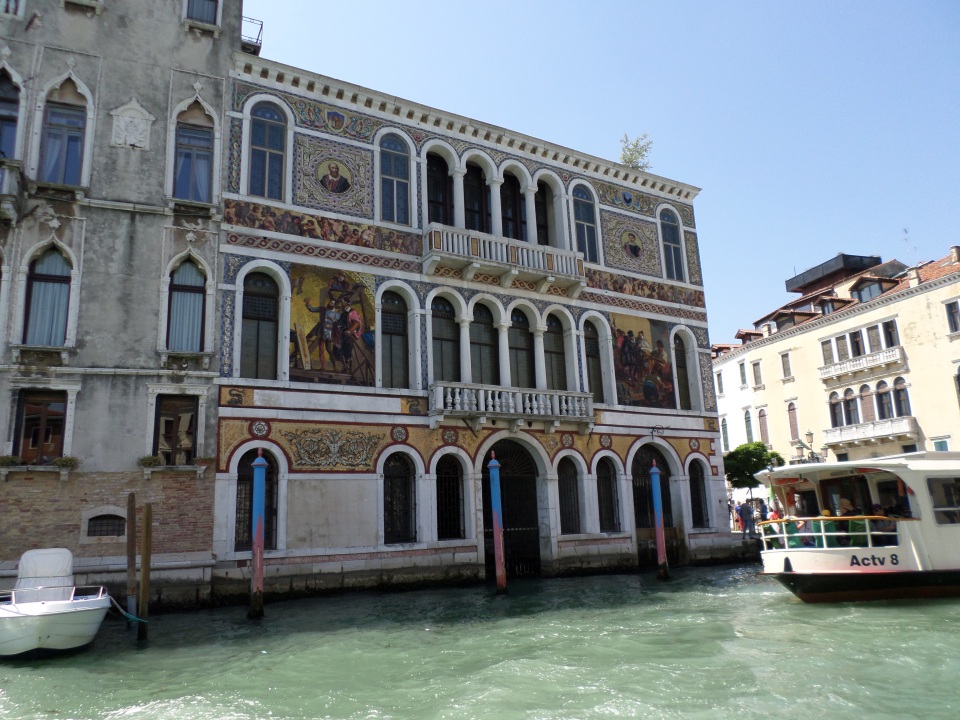
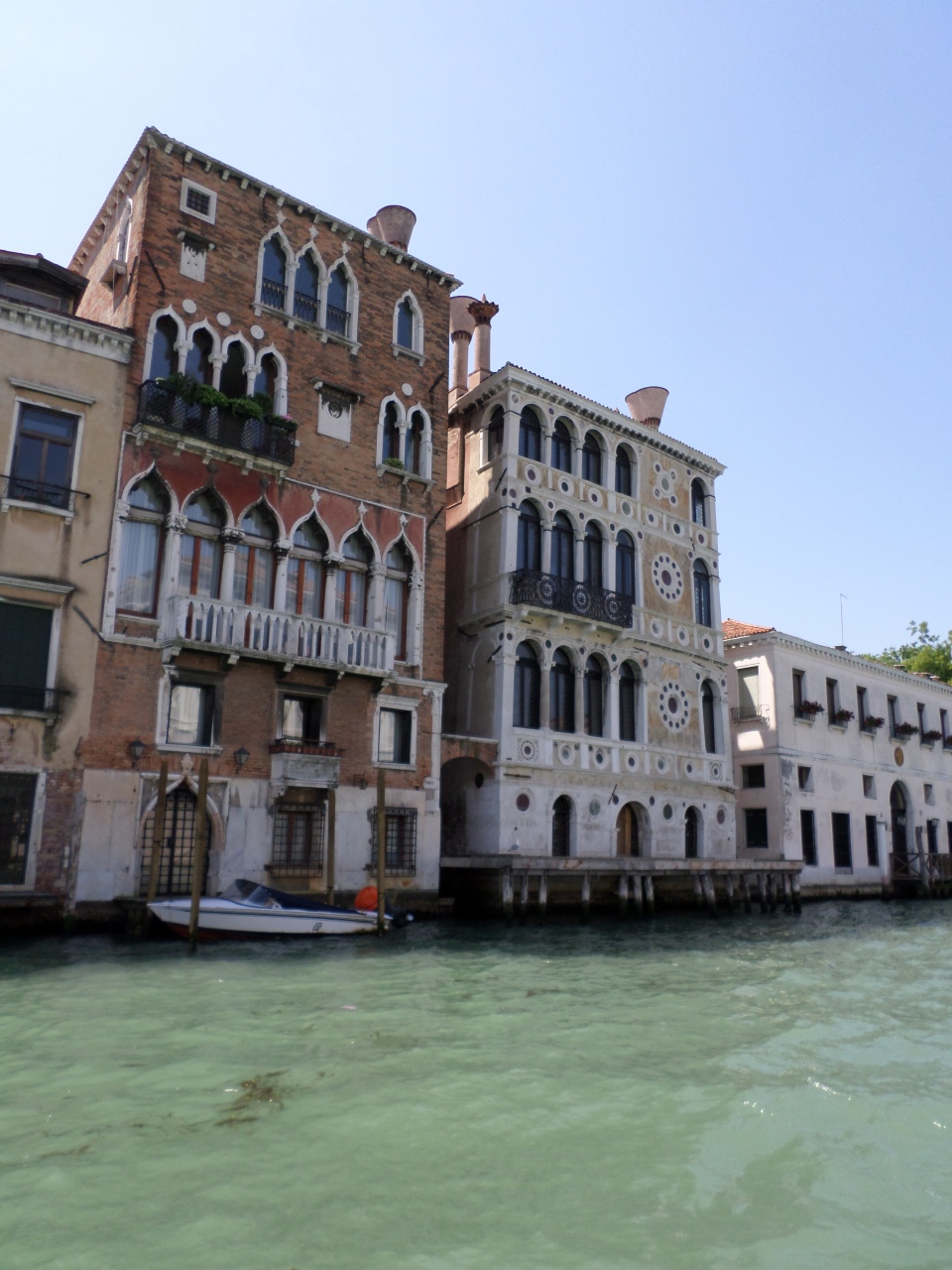
After some small tasks and a quick lunch we set out on foot to explore. We found our way to the Academia bridge or Ponte dell’Accademia. Crossing over we wandered about for some time, finding interesting plazas and buildings. There seemed to be more trees and gardens here,and we found one area with quite modern buildings. We stumbled across a Biennial event ‘Happenstance’ organised by some Scottish architects, but I am not sure exactly what it was! After getting lost (if we ever really knew where we were, exactly) we made our way to the Rialto Bridge and from there back to the hotel.
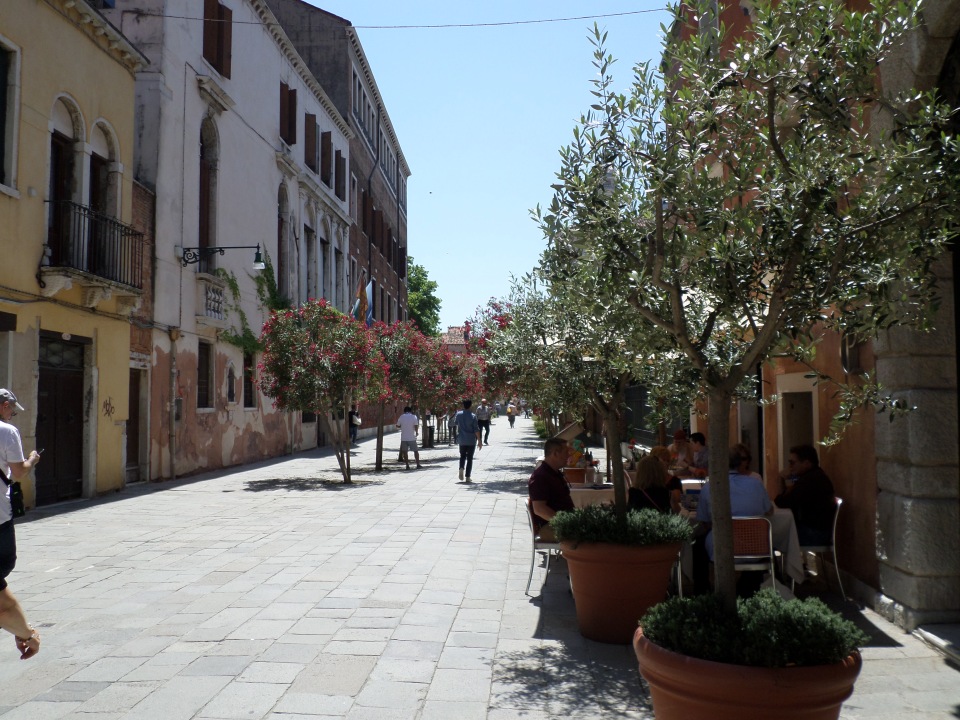
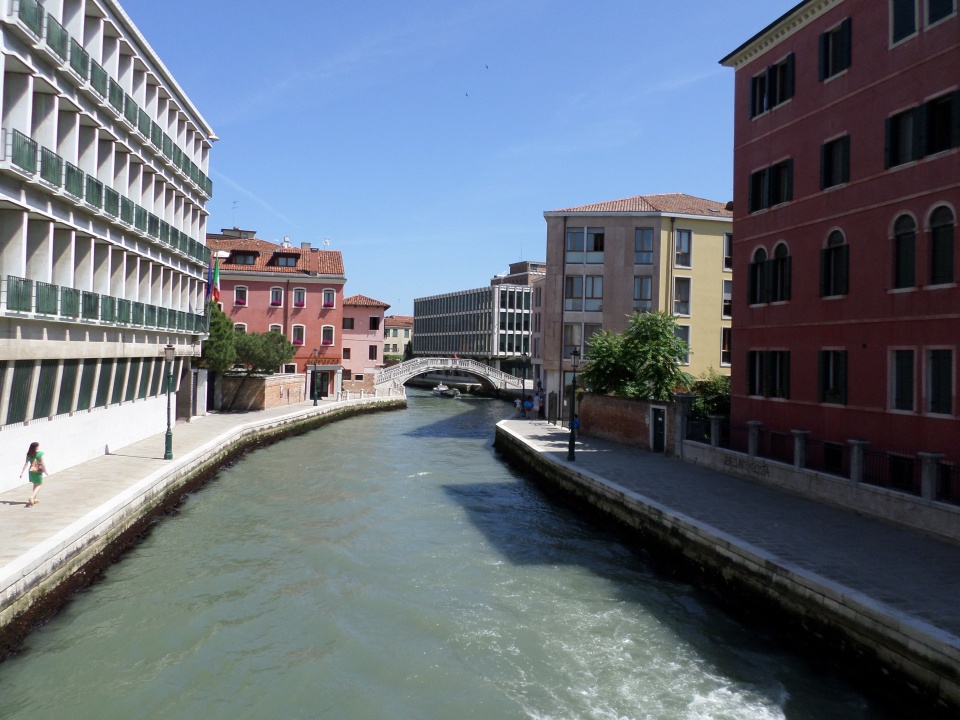
Later on, at 7 pm we joined in a visit to the Basilica San Marco, in a group of 12 people (there were four groups going through at different times). We were told a little about the history of Venice (again) and also about the flooding – tends to be associated with high tides and on-shore winds so is fairly predictable, and goes down with the tide as well. The front of the Basilica is very highly decorated, but the sides are not, fairly plain marble.
We entered the Vestibule from the north door and admired the mosaics there of the Old Testament. In former times, people studying in preparation for baptism and acceptance into the church were not allowed into the Church itself, and had to listen to services from the vestibule. The floor is patterned in mosaics of stone, while the roof and domes are mosaic in small glass tiles. The dome at the right shows the creation and Garden of Eden parts of Genesis.
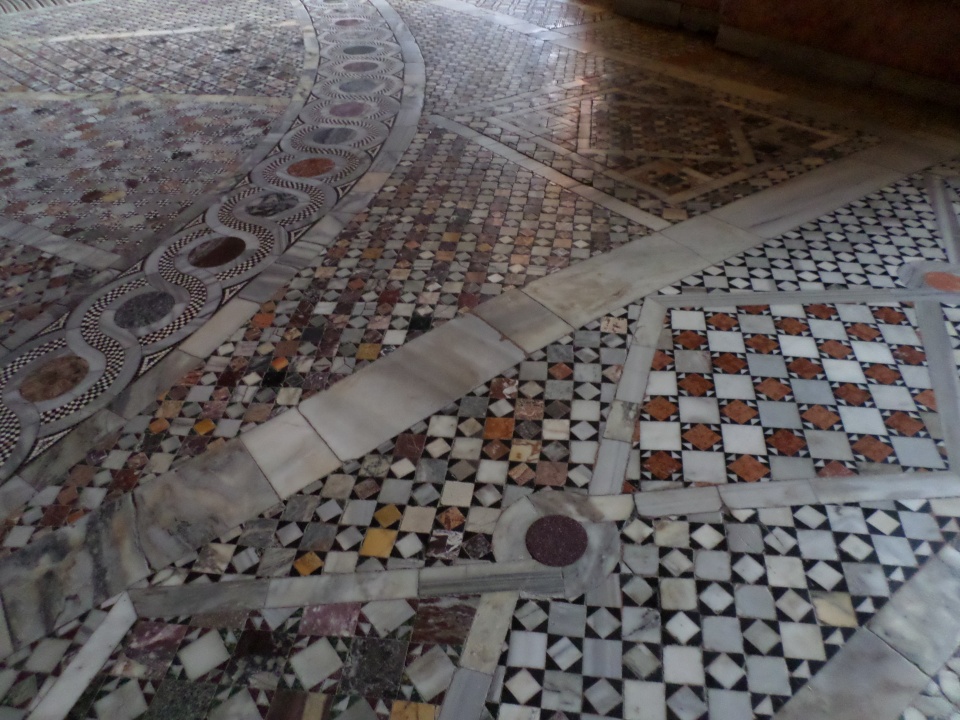
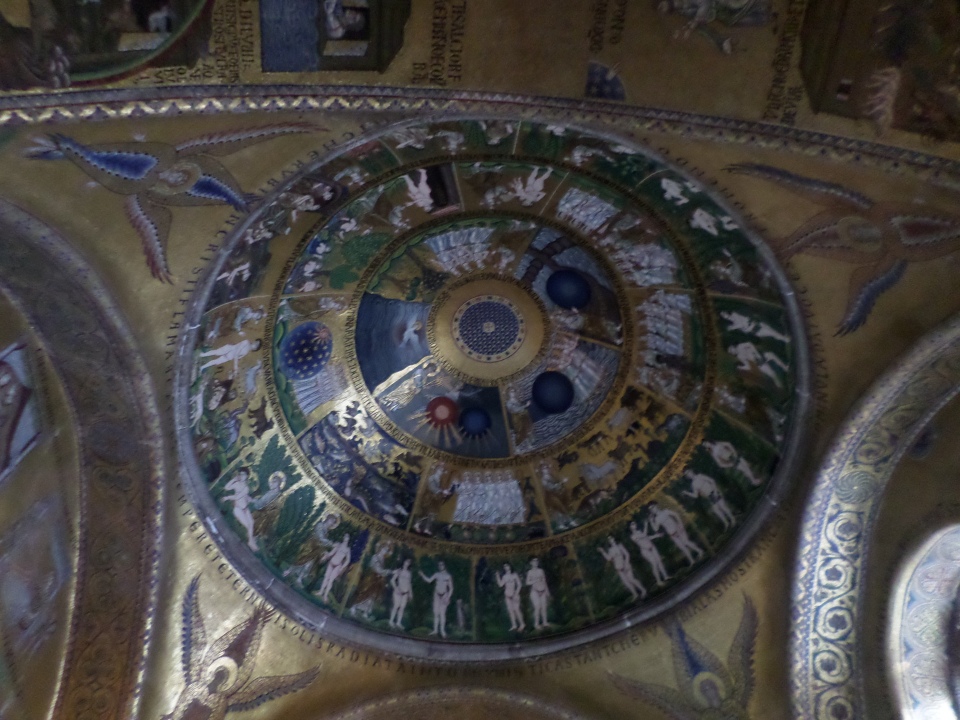
We entered the Basilica itself through the centre door and were shown the mosaics of various stories of Jesus’s life. We sat for a bit at the front of the nave as the lights were brought up in the Chancel, showing off the mosaics there, of the Passover week and Passion. Quite beautiful.

We were taken down into the crypt, where Mark’s tomb used to be, under the high altar. It was moved up some centuries ago as there were concerns about rising water levels and water damage. Our guide told us that he remembers that the crypt was closed for 20 years or so while renovation was carried out relatively recently.
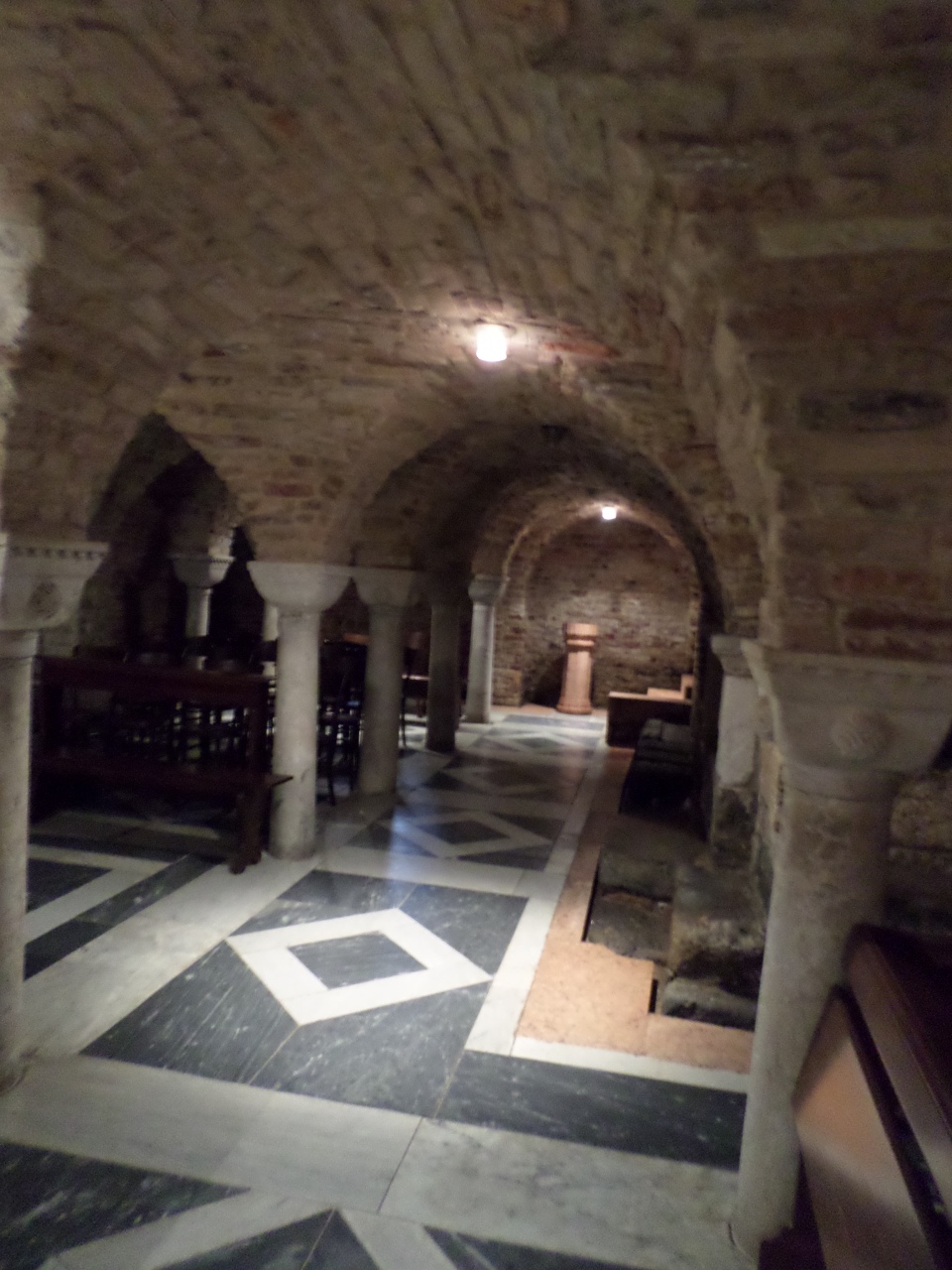
Back up in the main church again, we were taken into the Chancel, and then round the altar to admire the gold and jewel-encrusted altar piece, which was very shiny in the artificial light. It was a bit hard to photograph as we could not get far from it in the available space.
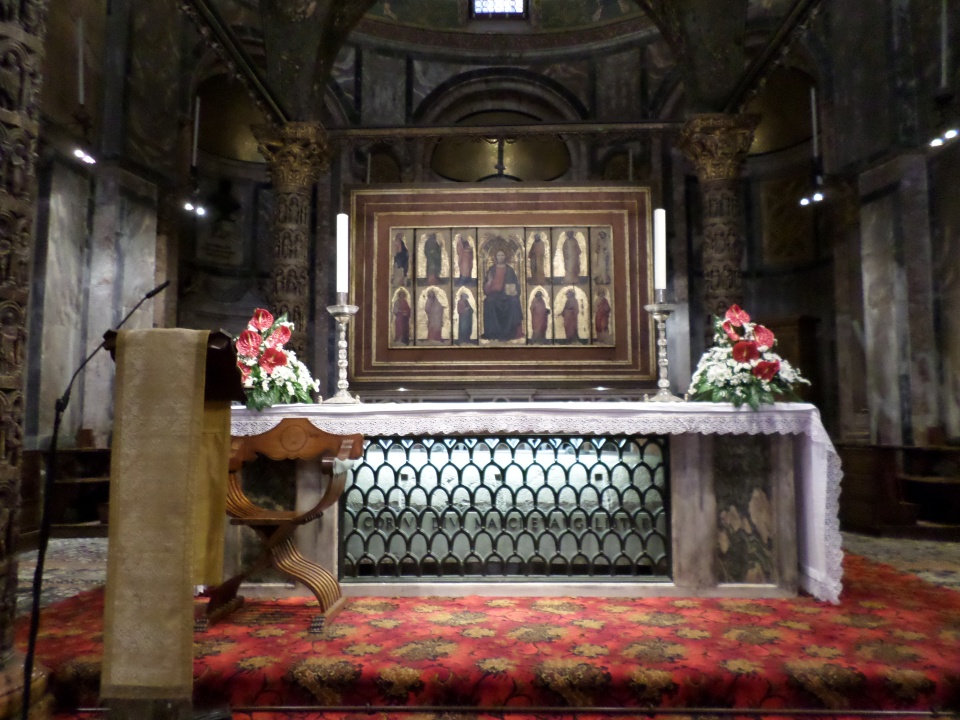
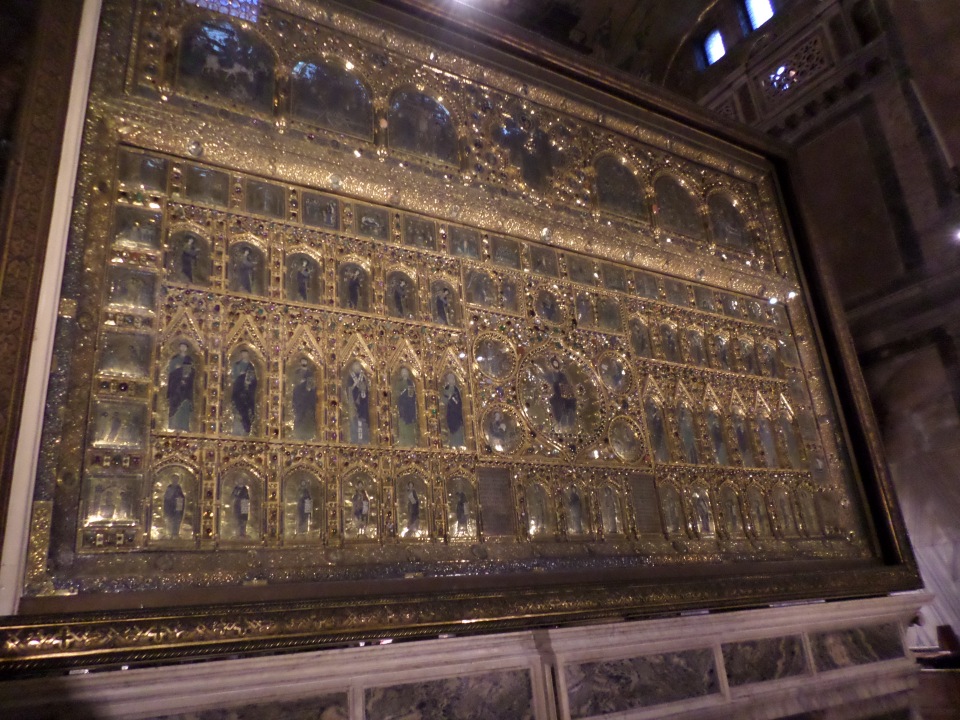
After this, we looked at a few more mosaics, but the altar piece was definitely the highlight of the visit. I managed to photograph the peacocks, the story goes that peacock flesh does not decay, and thus they are symbolic of eternal life.
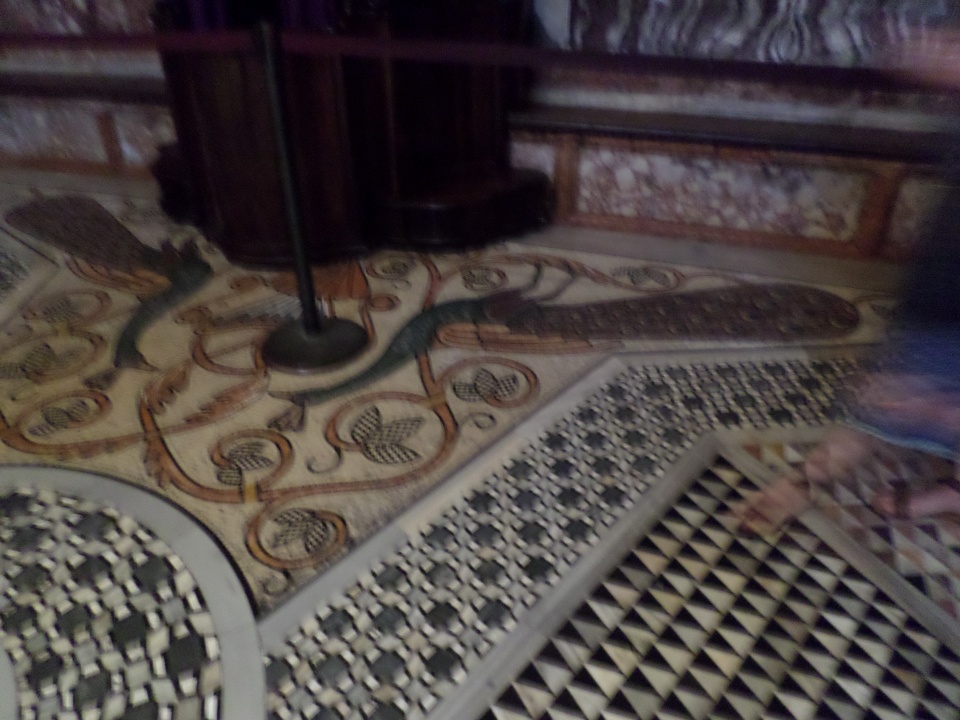
Out in the Piazza it was still light and the three-quarters moon was up above the Basilica, and there was water spreading out from the drainage holes in the paving. Mere puddles then, but looking like a minor flood when the moon is full in a few days.
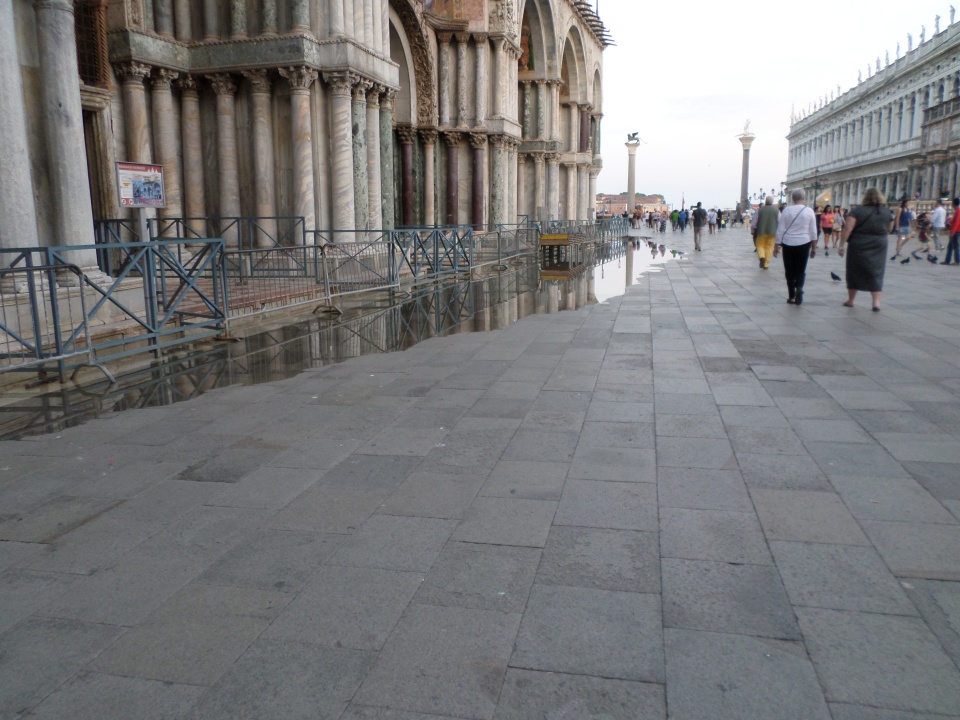
Venice 2
It is Thursday and our first full day in Venice. We started off with breakfast in the hotel – a good spread of Continental breakfast makings, although I stuck to fruit, granola and yogurt. Tea came as hot water and a tea bag, thank goodness. A croissant snuck in there somehow, as well.
We arrived a little early at the meeting place for our morning tour of the Doge’s palace, to find that not many other tourists were up yet. That soon changed as people flooded into Piazza San Marco during the day. We were in a group of 21 linked to our guide by audio headphones. Getting into the Doge’s Palace required a bag check and body scan. Once inside, the huge building turns out to have a large central courtyard. It is not just a Palace for the Doge, but also the seat of the ruling councils of old Venice, and where the courts met. The latter two were rather more important than the former. The north side of the courtyard facing the side of the Basilica San Marco is different, having a logia and staircase and view of the domes, but not a building like the other three sides. The east side upper floors are in early Renaissance style, while the west and south are medieval. When burnt down (as they have at various times) they were rebuilt as they were before.
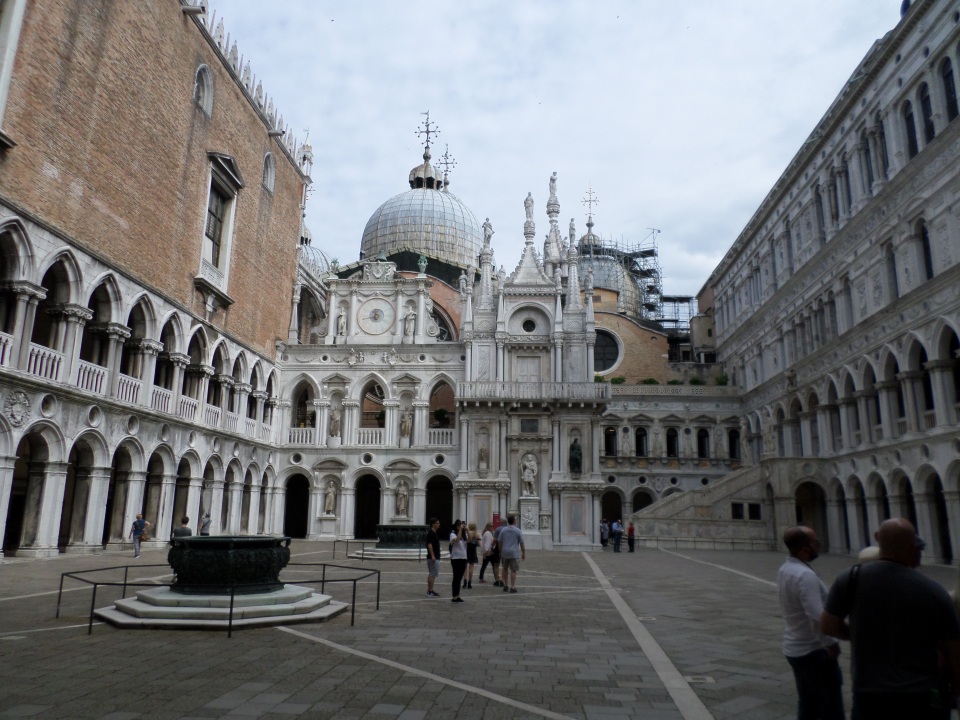
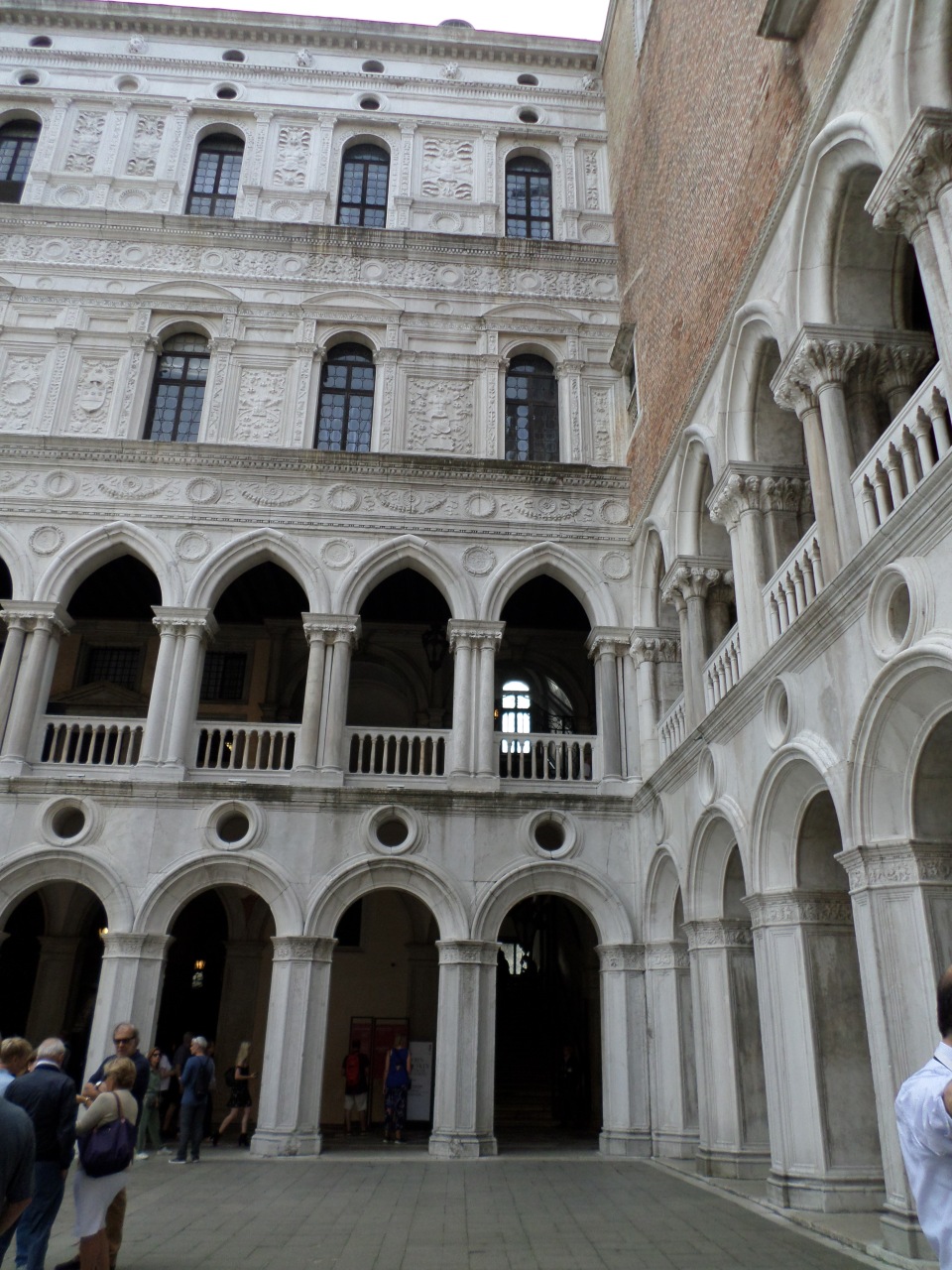
We were shown round the important rooms where ceremonial activities and ruling council meetings were held. The stairs we took to the upper floors were richly decorated, the walls in marble and the arched ceilings decorated with paintings and gilded carved frames. In the rooms, paintings on the walls with scenes from Venice’s history, or allegorical paintings with the Doge, and symbols of Venice like the lion; of Christianity, angels, doves and haloes; and of peace and prosperity, laurel wreaths and cornucopias. The decor was to impress themselves and any visiting ambassadors.
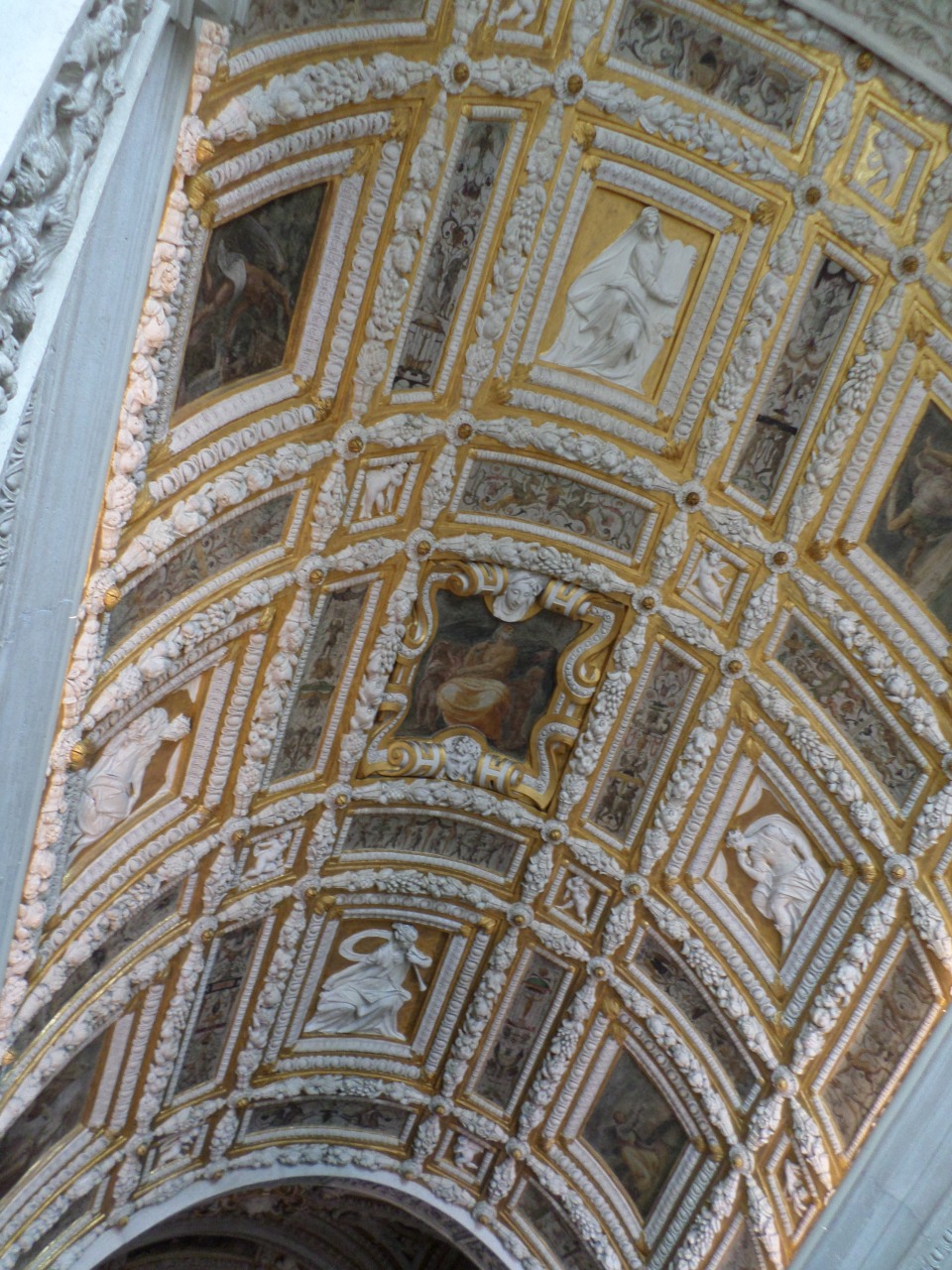
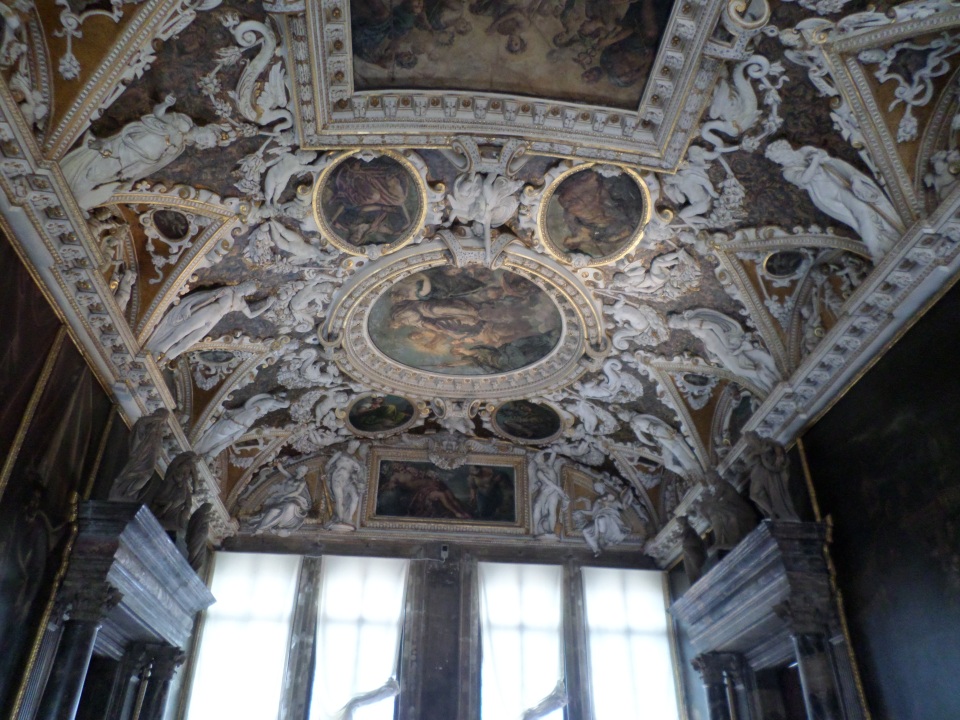
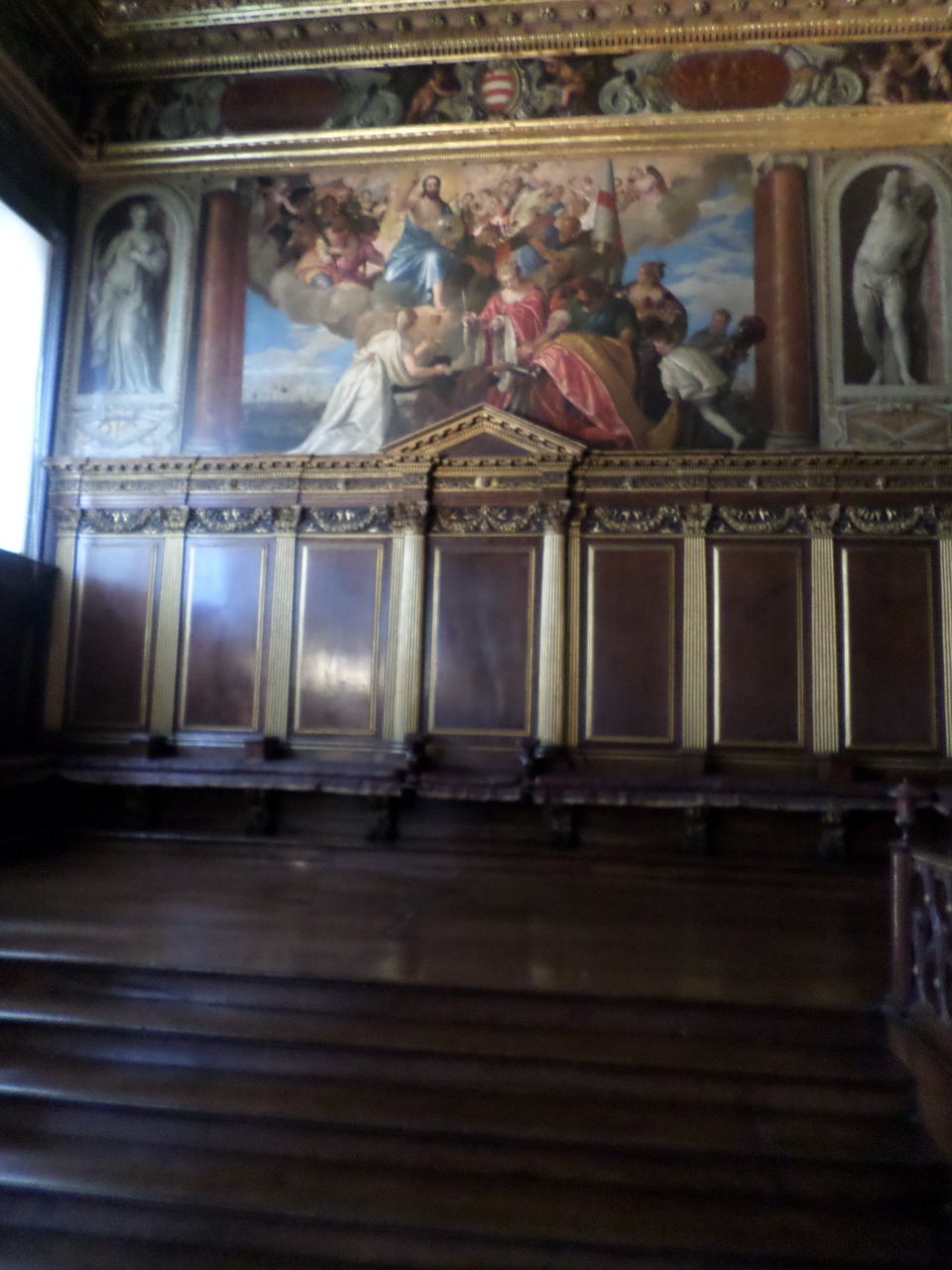
We were also given a long talk about the structure of the Republic of Venice and reminded that this lasted for 1100 years, longer that most other Republics. The Doge was more or less a figurehead with little real power, and though elected for life most candidates were already quite old. Any power they had was tempered by their panel of six advisors. On the other hand the Council of Ten (I think) members were elected for a month? Several months? Not for long! So that power and time were balanced out. There was also a Council of Nobles: these were the families of the elected representatives in the 11th Century who declared themselves noble. Thus the Republic was also an oligarchy to an extent.
The Grand Council (of Nobles) was huge, the number fluctuated and membership was by birth not election. Their meeting room was thus very large (53 by 25 metres), taking up most of the second floor of the south wing, and with no internal columns or supports; impressive for builders in the early middle ages. It was also decorated with scenes from Venice’s history – some fictional according to our guide. At the top of the walls were portraits of Doges, one blacked out because he tried to make himself King and was promptly beheaded in the courtyard outside!
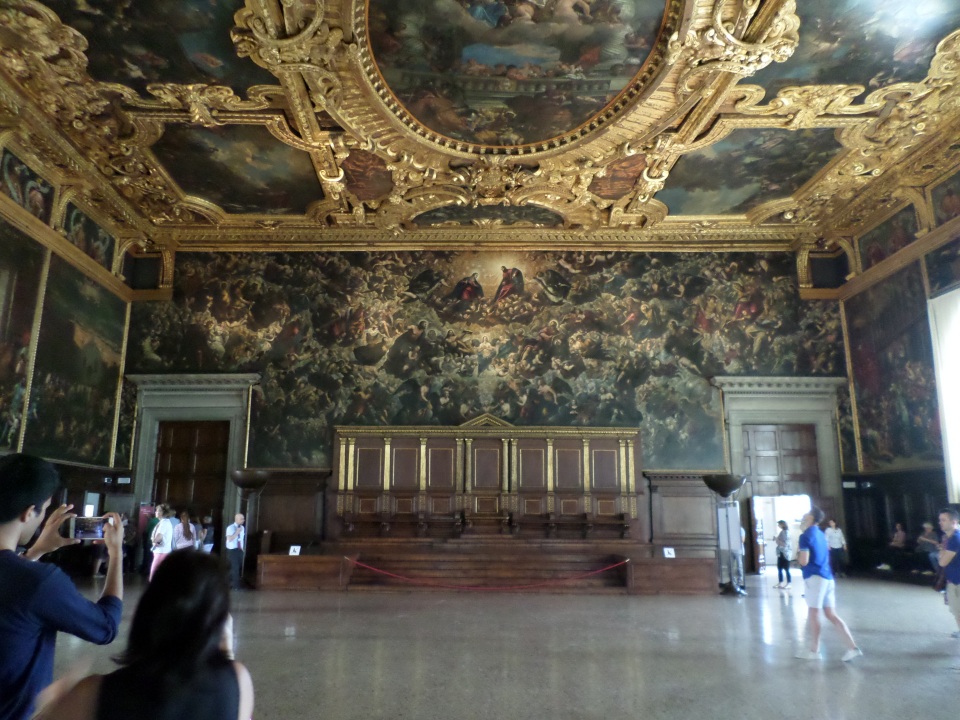
We were taken over the Bridge of Sighs, the enclosed bridge between the Doge’s Palace and the prison. This is unchanged despite not having been n use for some time. The prison was very secure, the cells are walled in stone and there are no outer walls – that is the guards’ corridors run right round the cells; the cell doors are low, so rushing a guard to get out is difficult; and the openings opposite windows are barred in interlaced metal bars. The Bridge of Sighs has two corridors, to go into the prison one has only glimpses of the canal to the north. On exiting there is a better view out to the lagoon.

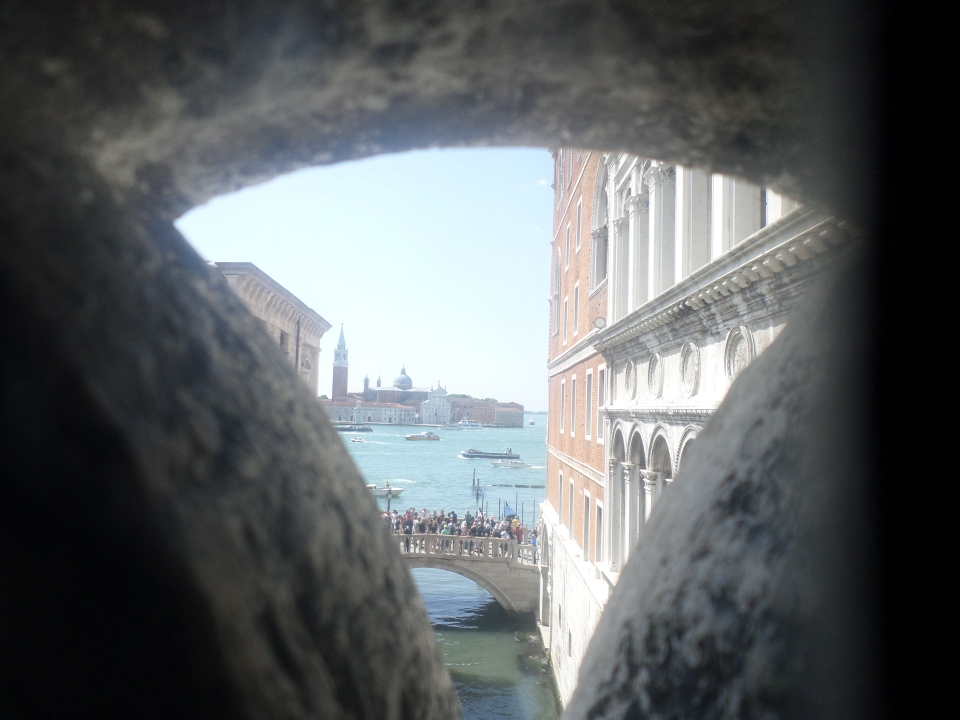
We moved though several other rooms. One once held the family genealogies of the noble families. However, when Napoleon took Venice in 1797, all the records were destroyed as the Republic of France did not recognise aristocracy!
After the tour ended, we were left near the shop, of course. We had several hours until the afternoon tour so headed back to our room to drop off purchases and then out for a sandwich lunch. We reconvened at the Giardini ex Riali to meet only 6 other people on our tour – The Basilica of San Marco and walking tour of Venice. We had a bearded guide with sense of humour, a saucy wink, and loud voice, we did not use audio link as there were so few of us. By then the day had got a bit hot, enough to prefer shade to sunlight, and humid.
We started by walking over to San Marco and finding some shade to stand in while getting an introduction to the building. The first church built here was to house the remains of Saint Mark, which had been ‘acquired’ in Alexandria by Venetian merchants around 800 AD. As time went on more elaborate structures were built – the current church dates from the 12th century? But it has been enhanced since as marble was ‘liberated’ from the sack of Constantinople. The four bronze horses on the facade are copies, the originals were also from Constantinople, but were taken off display in the 1970s. The copies went up in 1982.
Skipping the queue to go into the Basilica (wherein no photographs could be taken), we stopped in the vestibule to admire the mosaics on the domed ceiling – one dome had the story of creation and expulsion from Eden in concentric circles. Going up a flight of steps (which also took us above the common flood level) we entered the Basilica proper. The floor is mosaic in pieces of marble making complex patterns with some three-d effects, and also flowed in waves, as some parts of the – have sunk a bit over the centuries. The walls are marble and the roof lined with mosaics, the majority of which are 24 carat gold leaf set in glass. There are five domes and numerous arches so the mosaics cover a lot of surface.
We were taken into the Chancel and saw the rather ordinary alter piece (a couple of unimpressive paintings), but then were led around it, to see the back or alternative alter-piece as the whole thing can swivel. This is a breath-taking golden jewel encrusted portrayal of the Christ, disciples, angels and empty throne ready for Judgement day. It is amazing. The upper section was ‘acquired’ from Constantinople, and the lower section was enhanced as more and more riches accumulated in Venice.
We exited the Basilica by the north door and turned right to avoid Piazza San Marco and explore the smaller alley-ways to the east and north. We left the San Marco quarter and entered another,Castello, there are 6 districts in Venice. We walked narrow alleys and crossed numerous bridges.
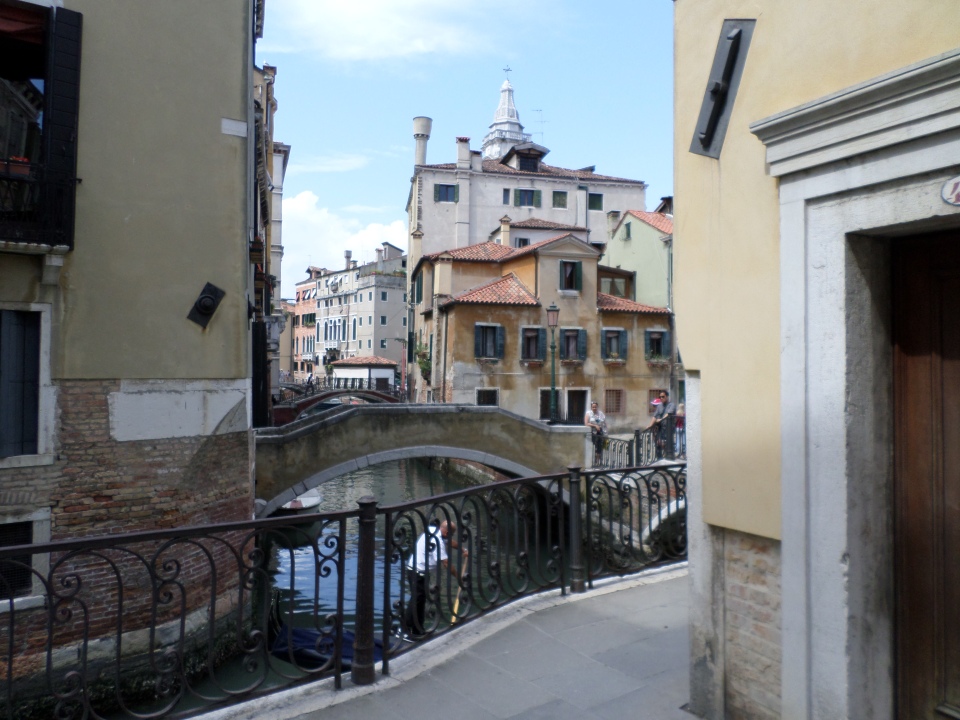
We entered a large piazza, where there are markets, usually. Then we headed down more alleys with interesting old buildings facing them, until we reached another Piazza. Here there is the largest Church in Venice, where many of the Doges and other dignitaries are buried, although it is built in unimposing brick.
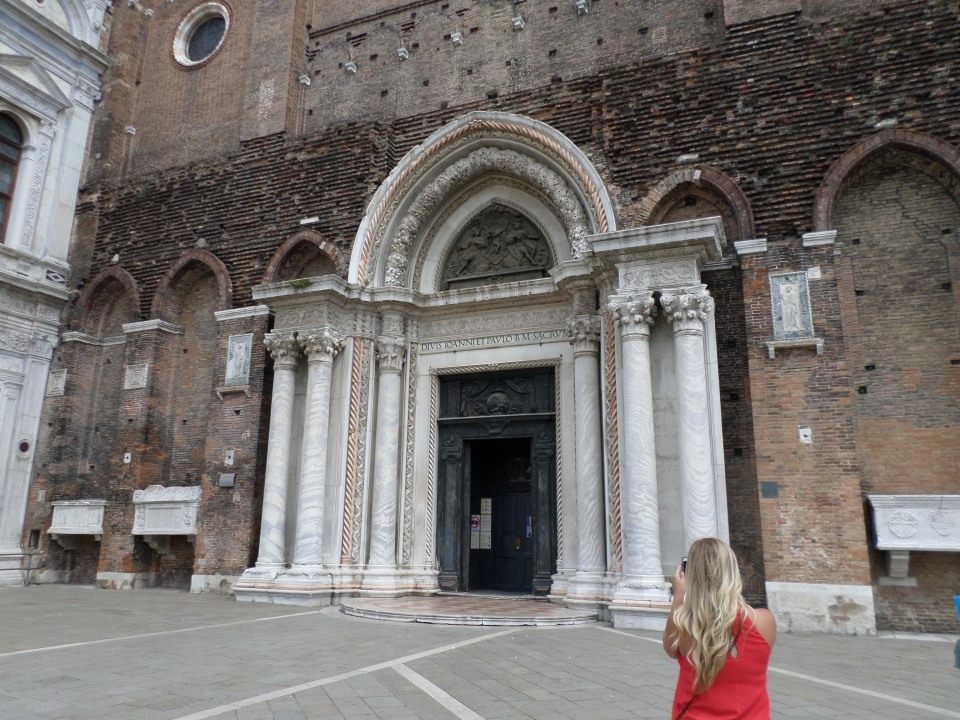
Next door is an interesting marble faced building, decorated with trompe l’oeil perspective pictures in marble of lions. This was an original Scholae headquarters, sort of a benevolent society, but it is now the front for the hospital.

This piazza also housed the marble pediment and bronze statue of a mounted mercenary general. He was well paid to remain loyal to Venice for over 20 years, and left his considerable fortune to the city, on condition that he was remembered by a statue, and so he is.

Further along our guide explained the water supply system of the old city (nowadays there is a pipe from the mainland). Originally, a conic hole was made and filled with sand. Rain water was directed into this, from flagstones with holes drilled through them, the sand filtering the water as it collected at the bottom of the cone, where it was drawn up through a well shaft. This pictured well was actually in the Piazza behind the Statue

Finally we got to the Rialto Bridge, across the Grand Canal. This is a heavy stone bridge, but it has remained upright for centuries, replacing earlier wooden structures. Here the guide left us with explanation on how to get back to piazza San Marco (essentially follow the yellow signs). We climbed the bridge and took photos!
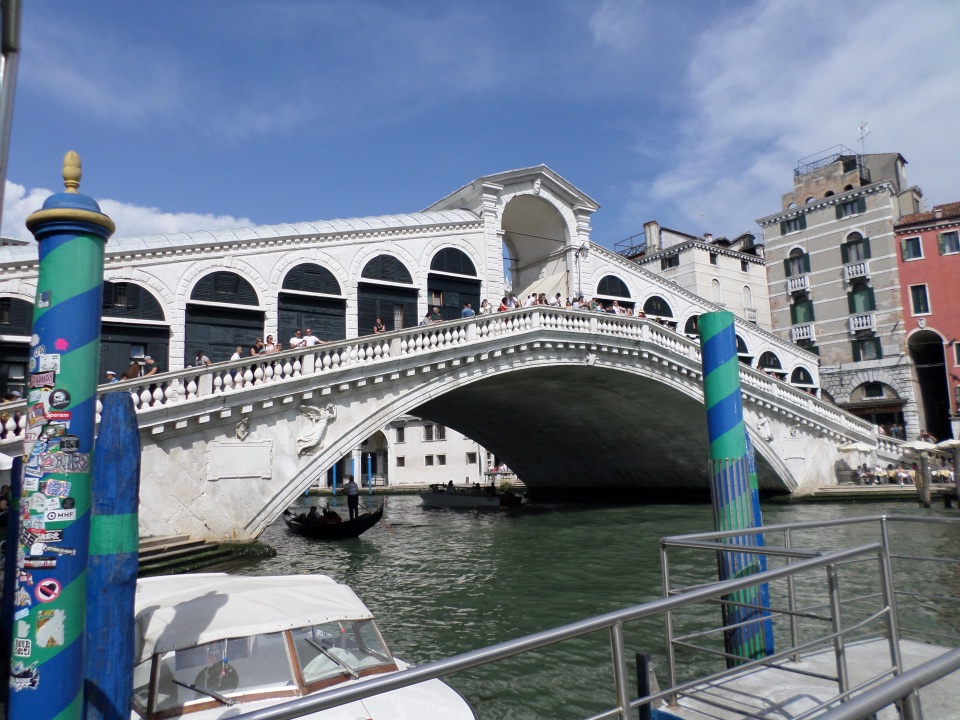
Heading back we were refreshed by a gelato, and admired the glass work on display in shop windows. We emerged into the north east corner of the Piazza, and made our way to the hotel for a rest before dinner. We had a lovely meal at Piccolo Martini.
Venice 1
This morning we left Vienna for Venice. The train to the airport was easy, especially being able to book in the luggage at the station rather than having to lug it about ourselves. We were somewhat early to the airport so I was able to catch up on writing. The flight was on time and we did not have to wait long for bags or for the public boat into Venice from the airport. Once we disembarked at St Marco’s it was a short walk over two bridges to the Hotel Kette, although we missed the turn off the main ‘street’ first time we passed it.
We checked in and unpacked somewhat, then set out to explore. Our first objective was to find where we were to meet our walking and boat tours over the next few days. This was near where we had alighted from the airport water-bus and easy to find (left at the Farmacia and right just after Jimmy Choo) outside the Giardini ex Riali. From there we walked along the water-front to the Doge’s Palace, admired the twin columns and gaped at the Basilica San Marco.
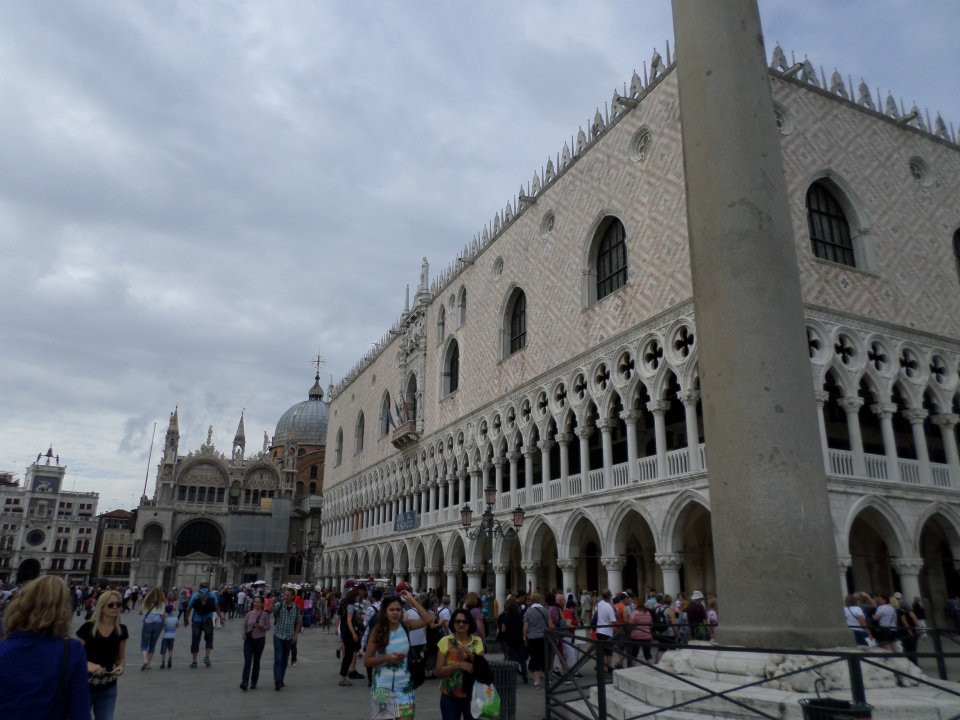
We sat at a table in the Cafe Florian for a light repast. Florian’s was established as a coffee house in 1720 and has operated continuously ever since, under the arches on the south side of Piazza San Marco, and spilling out into the square. We were entertained by a quartet (piano, double bass, violin and accordion) while we took in the sights and sounds of the late afternoon crowds. We sipped on a glass of prosecco and nibbled at some quiche. The quiche came under metal mesh plate covers on account of the seagulls (although there were also a lot of pigeons about). Luckily I was wearing my sun-hat, as a seagull landed on my head in a desperate attempt upon my quiche. Its weight pushed me forwards, thus covering most of the plate with the brim of my hat and Shirley waved the bird away! We had to replace the mesh covers over the plates between bites. The quiche was lovely and we sat absorbing the atmosphere for nearly an hour.
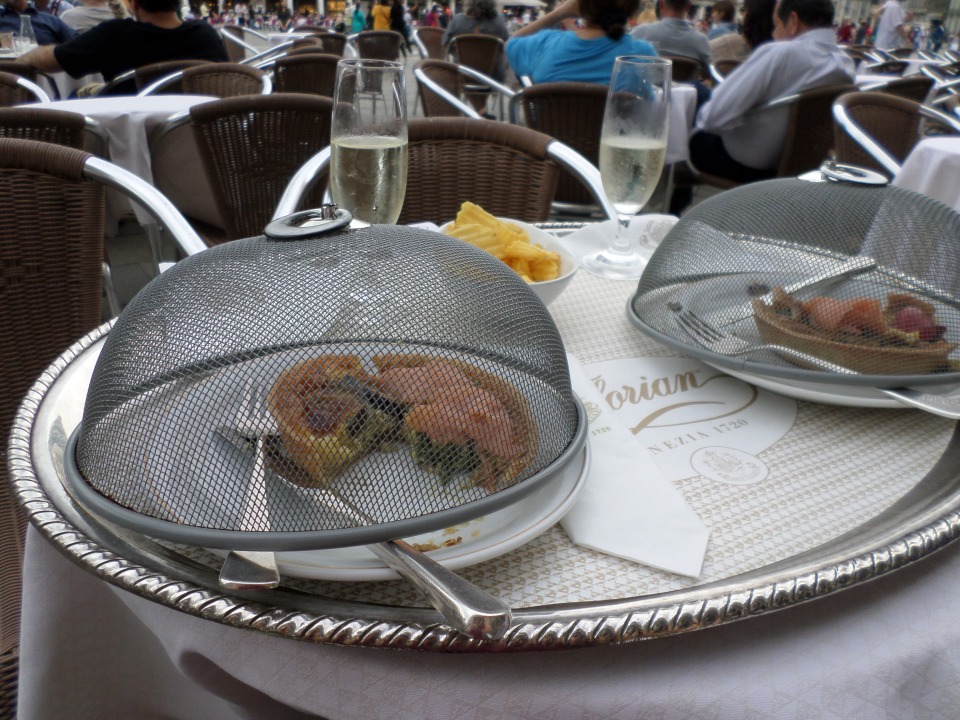
As the sun dropped into the west, its rays caught the gold mosaics in the facade of the Basilica lighting them up. Beautiful.
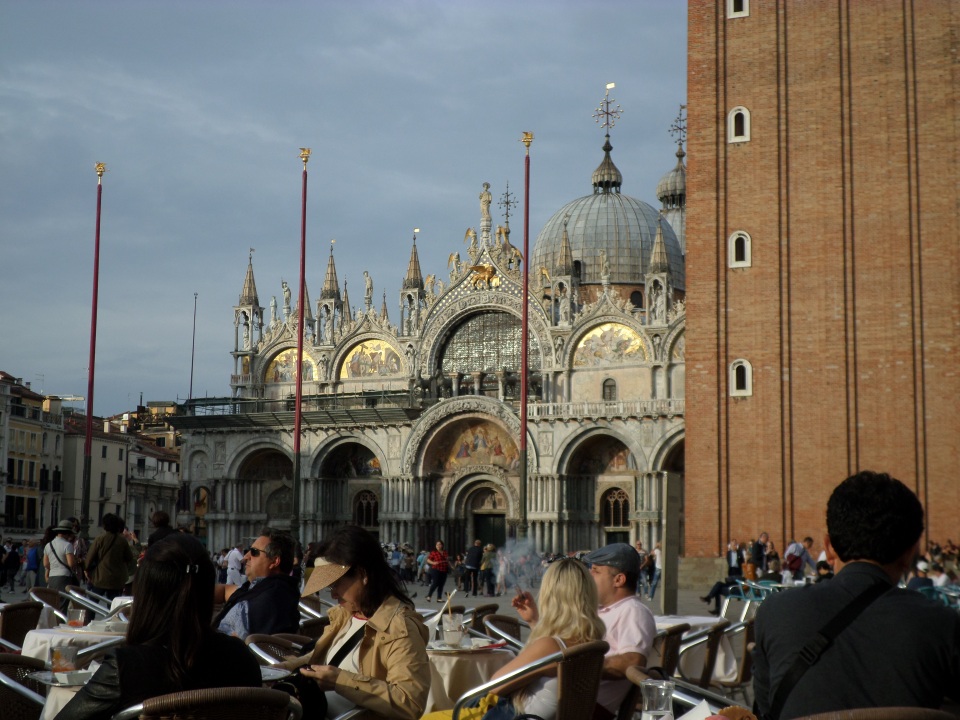
We moved on eventually, as Florians was trading on its history and reputation, and charging accordingly. We found a cafe in an alleyway nearby and got some rolls to eat in our room to fill us up.
Vienna 6
Tuesday at the Kunsthistorisches Museum and Stadt Park. The art history museum is in the Museum Quarter, across the ring road from the Hofburg. It was built in the early 20th century, and is itself a work of art! We arrived shortly after the 10 am opening, and were able to skip the queue at the ticket office and enter directly using our Vienna Passes – I really recommend getting a Vienna Pass!
We started with the Ancient Egypt, Greece and Rome area in the west wing. Our first stop was the Offering Chapel of Ka-ni-nisut, an ancient Egyptian. It had been dismantled by archaeologists and rebuilt in the museum. It contained relief pictures of Ka-ni-nisut and his family, and possibly servants (?) bringing offerings to the gods. The reliefs still had some paint on them, mostly red. The main rooms were packed with loot from Egypt, sarcophagi, grave goods, statues… The cutest was a pale blue/green hippopotamus about 15 cm tall, decorated with lotus flowers and a bird in flight. Apparently hippos are destructive and chaotic, so the defeat of a hippo in a hunt symbolised the restoration of order in the community
Moving on to the Greek collection, there was an assortment of statues and other relics. These included a coffin decorated with scenes of a battle between naked male Greek warriors and clothed, armed and mounted Amazons.
In the Roman area, again many bits and pieces of archaeological finds. The most interesting section was the collection amassed by one of the Hapsburg monarchs, of cut gems and cameos. With gems, the picture is cut into the surface while for cameos the background is cut away, leaving the picture in relief. The most impressive was the ‘Gemma Augustea’ a scene involving Emperor Augustus as Jupiter lording it over some defeated barbarians. It was about 20 cm across and cut from sardonyx.
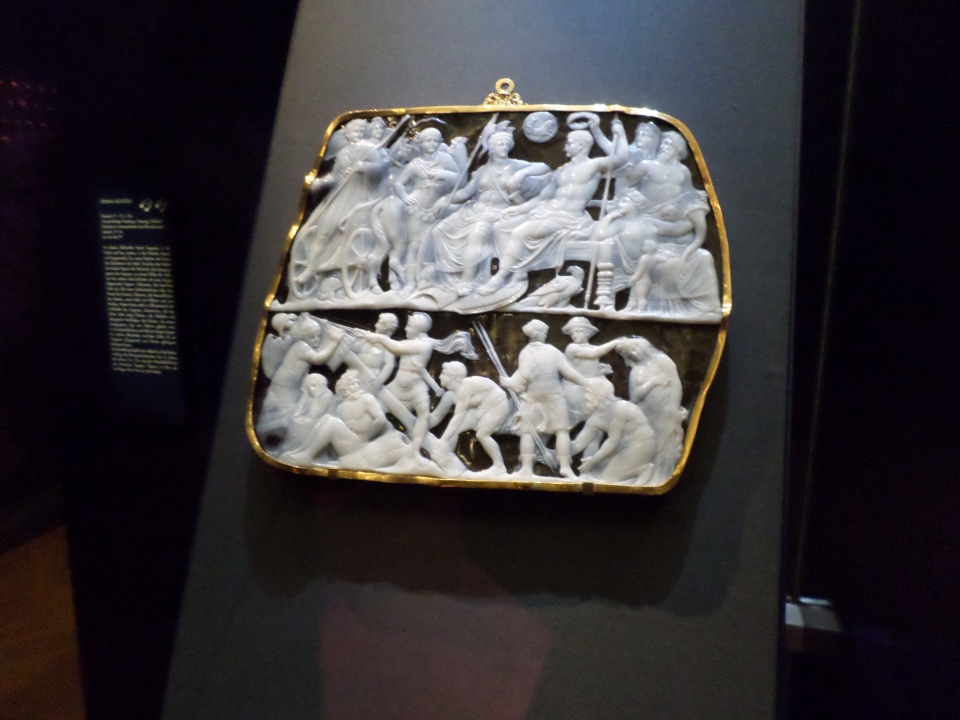
In the same collection, I also liked a lion and raven cameo, that had been set in gold and rubies at a later date. It was quite beautiful.
We then left that area and moved into the east wing and the Kunstkammer Wien, or cabinet of curiosities. This was a bit like the ‘silver collection’ that we had visited in the Hofburg, in that it consisted of lots of stuff (zeug) like tableware, games, vases… things! There was a huge table centre-piece in the form of three Greek ionic temples, along with two elephants and diverse other things… the purity of form of the ionic temples was much admired after the baroque and ‘playful rococco’ periods. There were many strange and wonderful items. I rather liked a Chinese influenced tea set (at least I think it was a tea set) in gold and porcelain. The item that was drawn to our attention as the pride of the collection was a salt holder or ‘salieri’ made by Bonvenuto Cellini in hand wrought gold (1543) as an allegorical portrayal of sea and earth’.
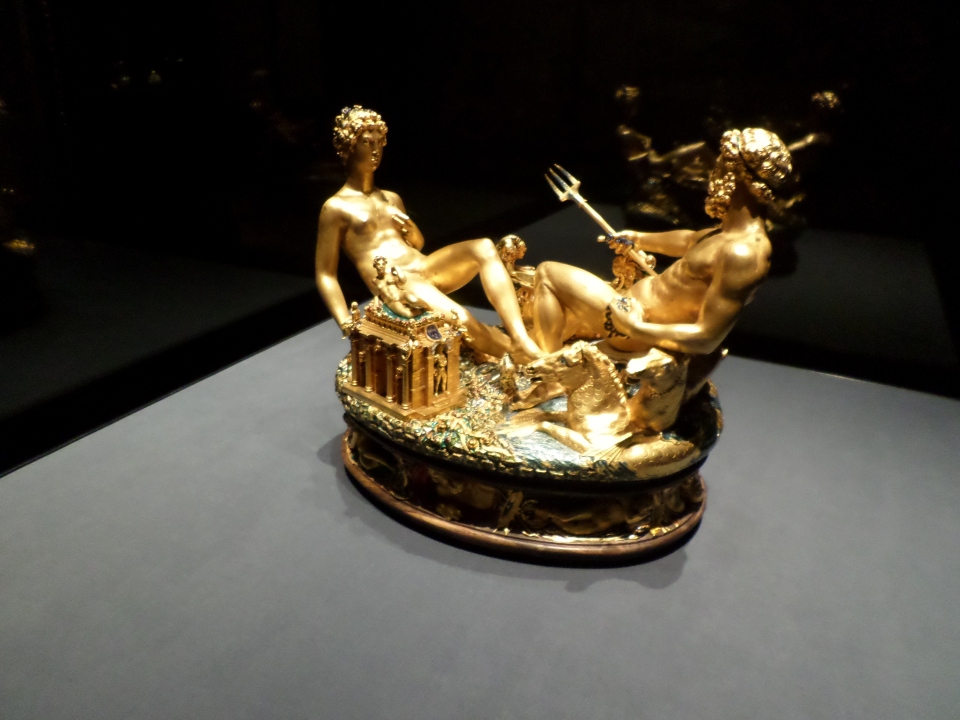
Back in the centre of the building, we mounted a scaffold set up just for this year to allow a closer look at the paintings that decorate the top of the main stairwell. These were done by a particular group of artists led by Gustav Klimt, and this year is the centenary of his death. Klimt did the paintings that adorn the south side of the stairwell, between the columns and arches. The semi-roundels above the arches were done by someone else. The figures that he painted represent some of the main artistic periods, including ‘ecclesiastica’ (Church and Christian related painting), Greek, Egyptian and Renaissance periods.
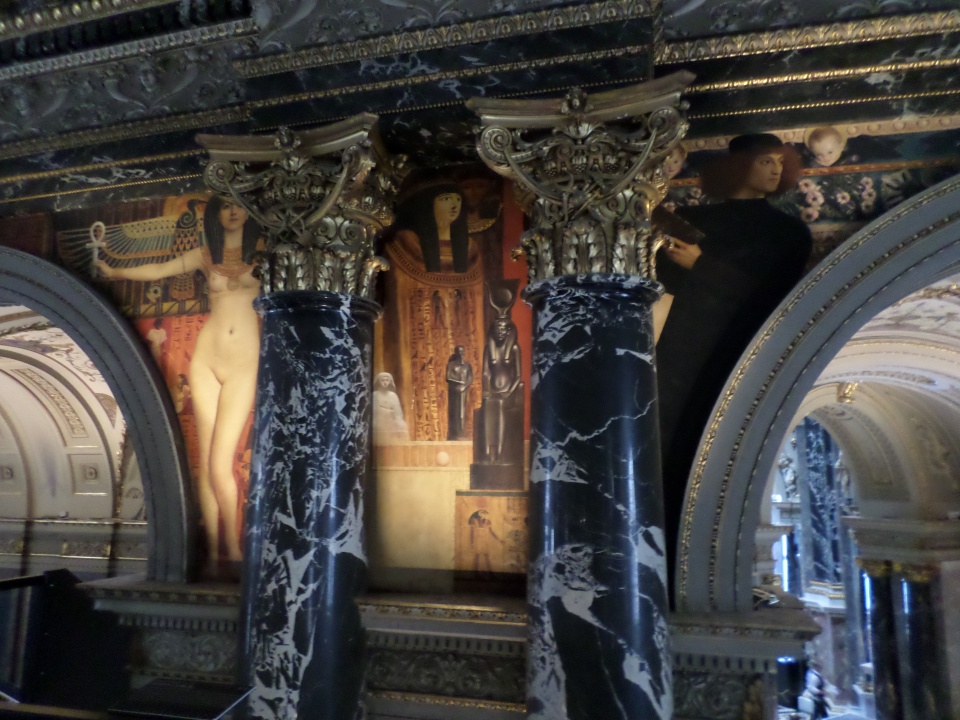
By now we had been walking the halls for two hours, so we took a break for tea and cake. I had a lovely Sisi-torte, and a herbal tea. The cake was four layers of chocolate cake separated by a layer of chocolate and almond paste. The top had a raspberry icing and a little picture of the Empress. It tasted as good as it looked. The tea room itself was above the foyer, and itself a sight to behold! Later, we were able to look down on the area from above and realised that there was a hole through to the foyer and up to the dome above.
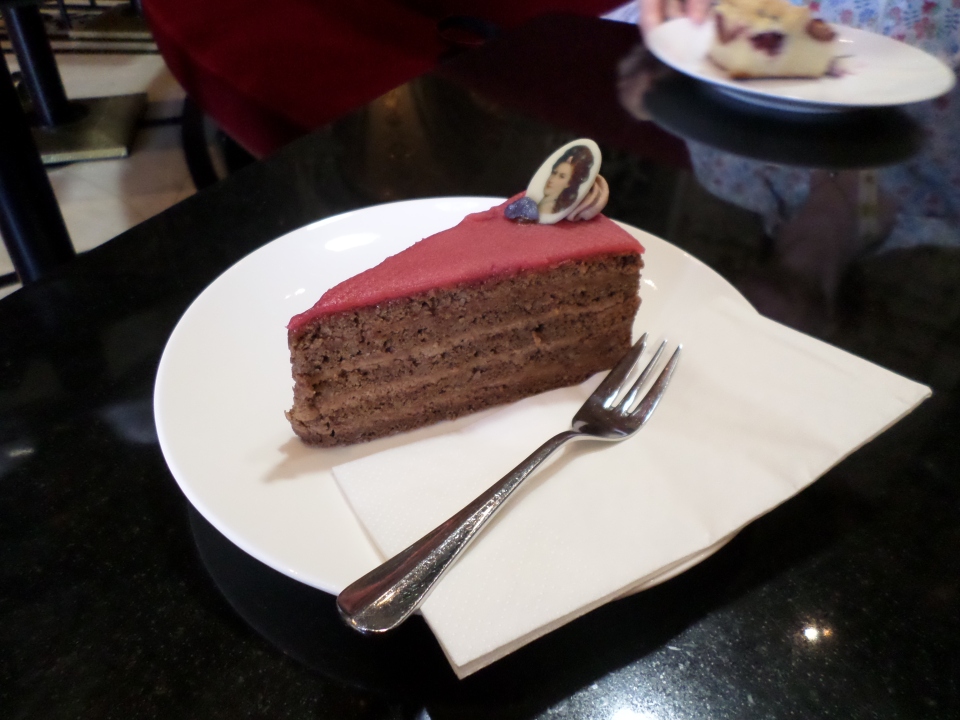
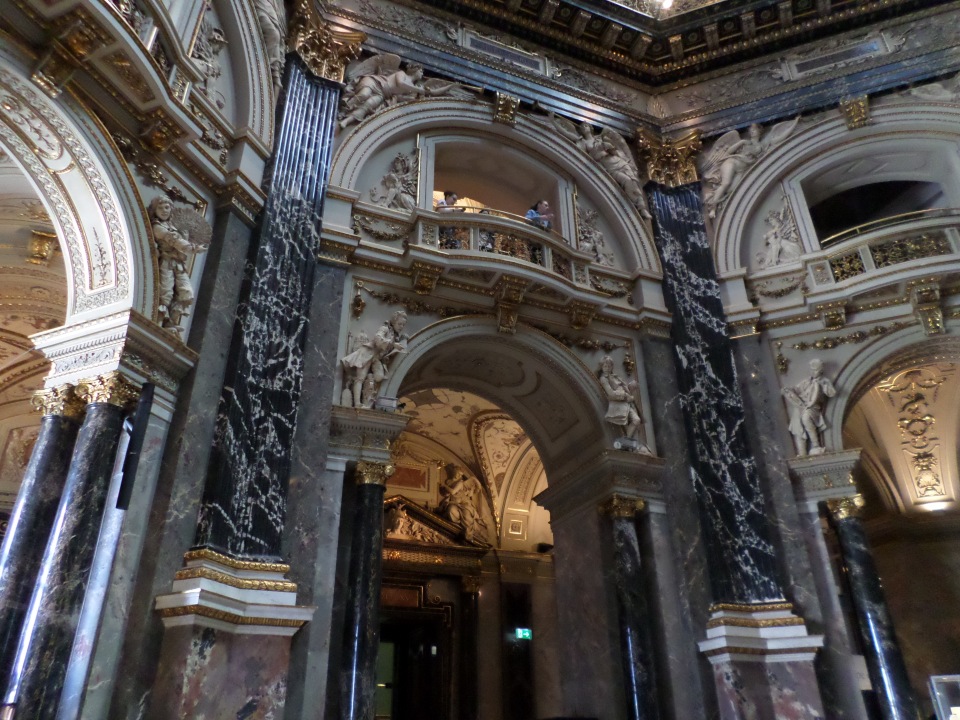
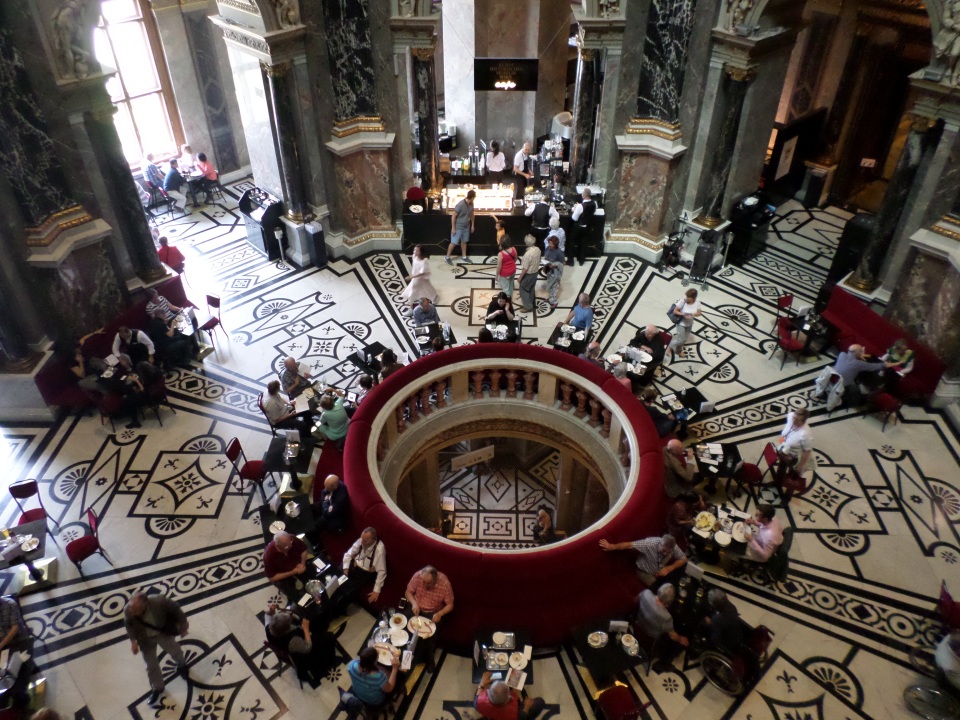
Now, we moved up a floor to the picture galleries. These were divided into Dutch, Flemish and German in the east wing (where we went first) and Italian, French and Spanish in the west wing. There were many, many paintings by well known artists and by the more obscure… it was quite overwhelming. Most impressive included a single panel altarpiece in an elaborate frame designed by the painter – Dürer’s Adoration of the Trinity, with a tiny self-portrait in the bottom-right corner, dated 1511. There were a number of paintings by Breugal, many of which I was aware of because Breugal painted the common people and so his paintings are a source for research on costume and customs of the late medieval period. His Tower of Babel (1563) was there. There were also several Rembrandt’s including three self-portraits.
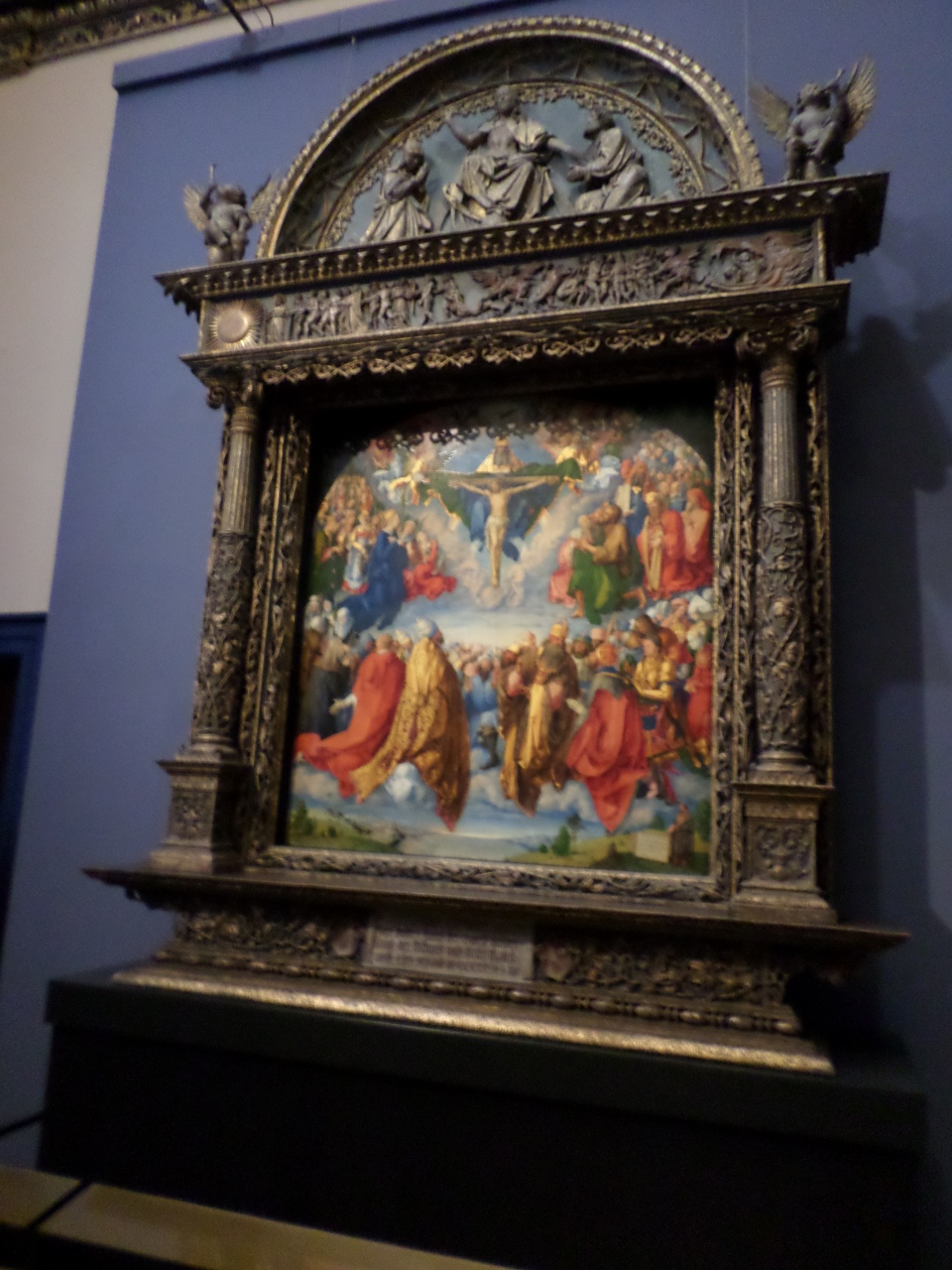
Moving on to the other wing, again there were a huge number of paintings. We found Raphael’s Madonna of the Meadow (1506), featuring Mary with Jesus and St John the Baptist as babies in an outdoor setting, which was innovative at the time. Also of note was Carravegio’s Madonna of the Rosary (1607) and a few Velaquez paintings.
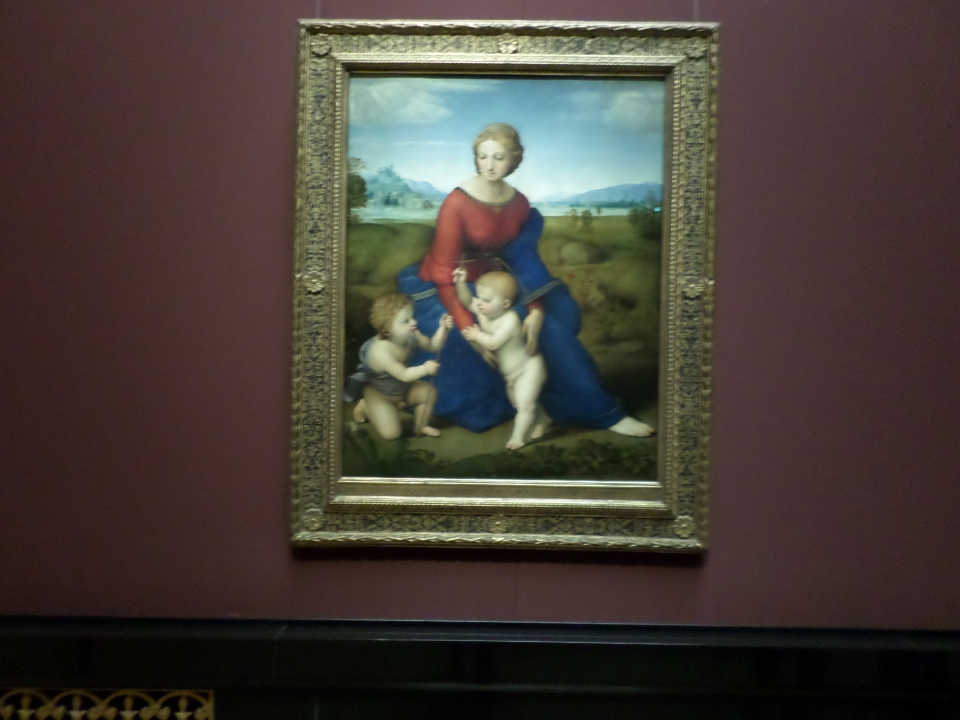
There were some paintings of Vienna, or nearby places. One was of Schloss Hof from the seventh terrace, probably of use to the restorers of the gardens. Another two were of Schönbrunn, front and back views. The one from the gardens was interesting in the lack of buildings shown on the opposite hill, now covered by suburbs. There was also a painting of Marie Antoinette, painted shortly after her marriage to Louis XV1of France, and sent to her mother, Marie Therese, Empress of Austria. The Imperial equivalent of a postcard saying ‘arrived safely, marriage went smoothly, having a great time.’
We finished up on the upper floor looking at the ‘cartoons’, or patterns for tapestries, concerning one of the Hapsburg’s military expedition to North Africa to halt the advance of the Arabs/Turks/Muslims across Tunisia. They won the battle, but lost the war. While we were there a Japanese couple appeared to have wedding photos taken! Or that is what it looked like!
It was all rather exhausting, although we had not walked many steps, we had been on our feet for hours. The building itself was impressive, built to house the Imperial collections opening in about 1900.
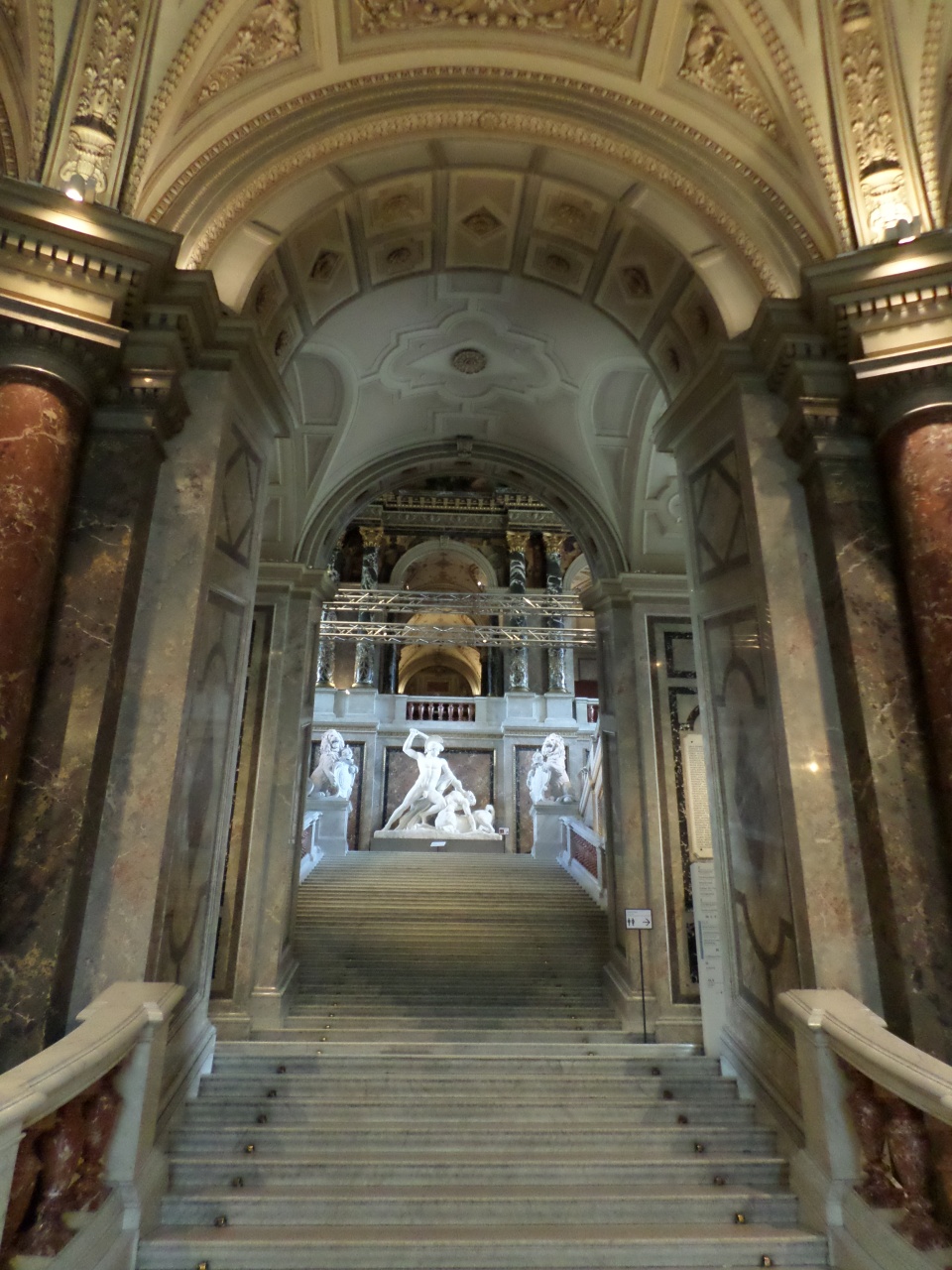
We retired to lunch at a recommended restaurant, Glacis Beisl. Their garden terrace surrounded by hydrangeas and rose bushes, and shaded by walnut trees and grape vines, was secluded and restful. A filling beef goulash and green salad in such lovely surroundings restored us!

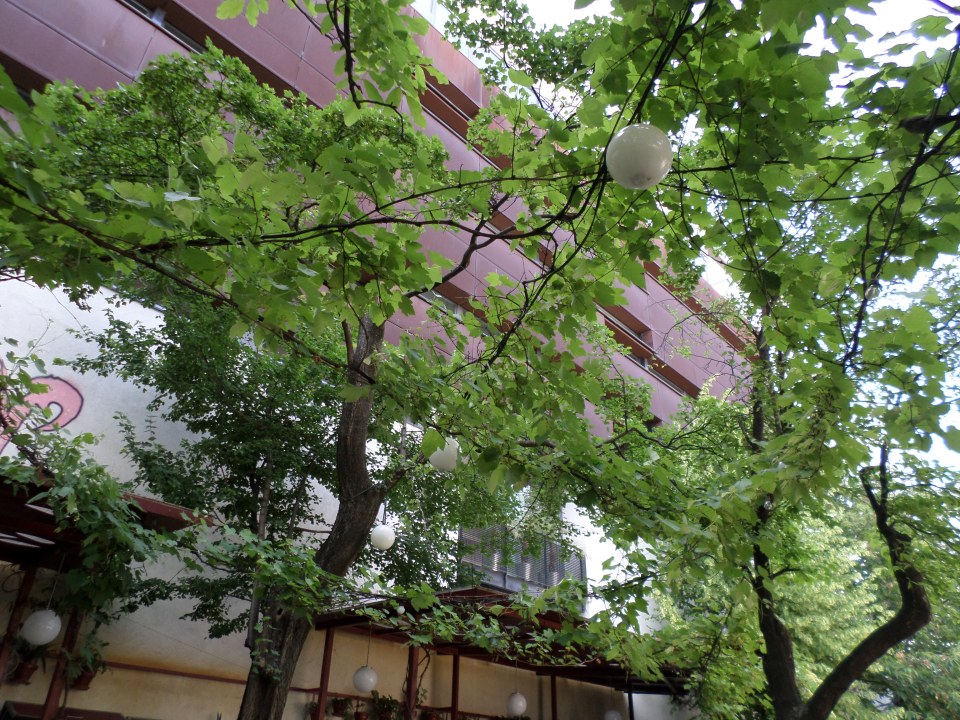
The Stadtpark has several statues or memorials to musicians in its grounds, so we set off to find them. We tracked down the gilded memorial to Johann Strauss, and thought it a little over-the-top. It was visited by a number of tour groups while we were relaxing on the grass nearby. Much cuter and ignored by all except a few children, was a fountain involving some penguins and which once had some rather nice mosaics, now poorly boarded over.
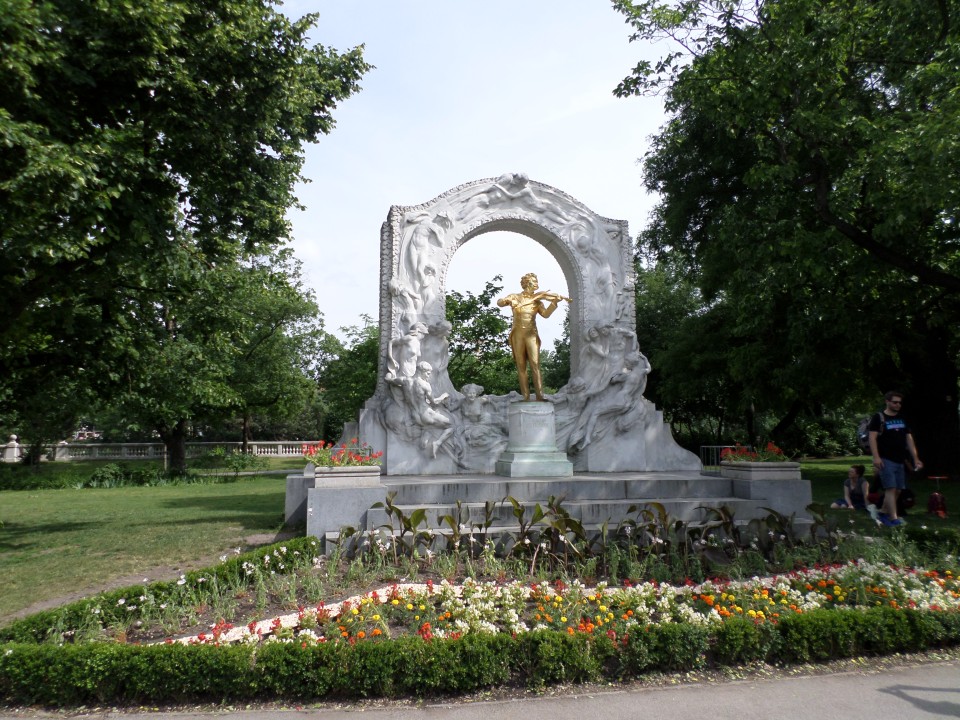
From the Stadtpark we walked in to Stephansdom, stopping briefly at a Christmas Shop to buy a souvenir. There were no wood-cuts as I had bought at the Christmas Markets in Germany a few years ago, but I found a suitable tree decoration to add to the collection. We also went into the Dom, briefly, less crowded than on our previous visit and the scissor-lift had gone, but a hanging sheet concealed the stained glass of the chancel.
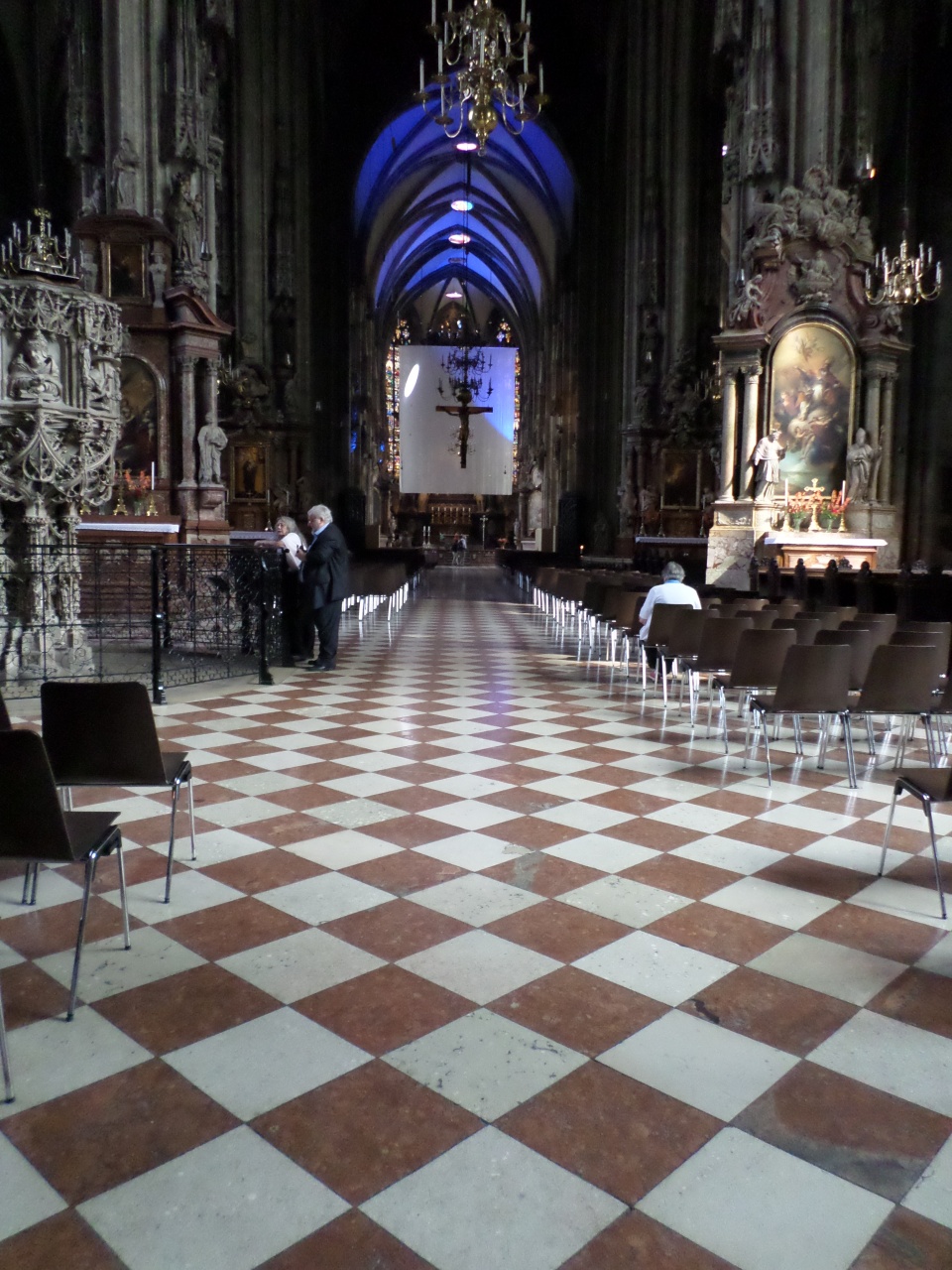
To end the day we went up to the top of the Sofitel, opposite our apartment. From the 18th floor there is a marvellous view. We sat and admired the scene out to the north east towards the Prater while drinking a glass of wine. On our way out I snuck into the restaurant side of the floor to photograph the skyline towards the city, with Stephansdom dominating the city, far more than it appears from the streets.
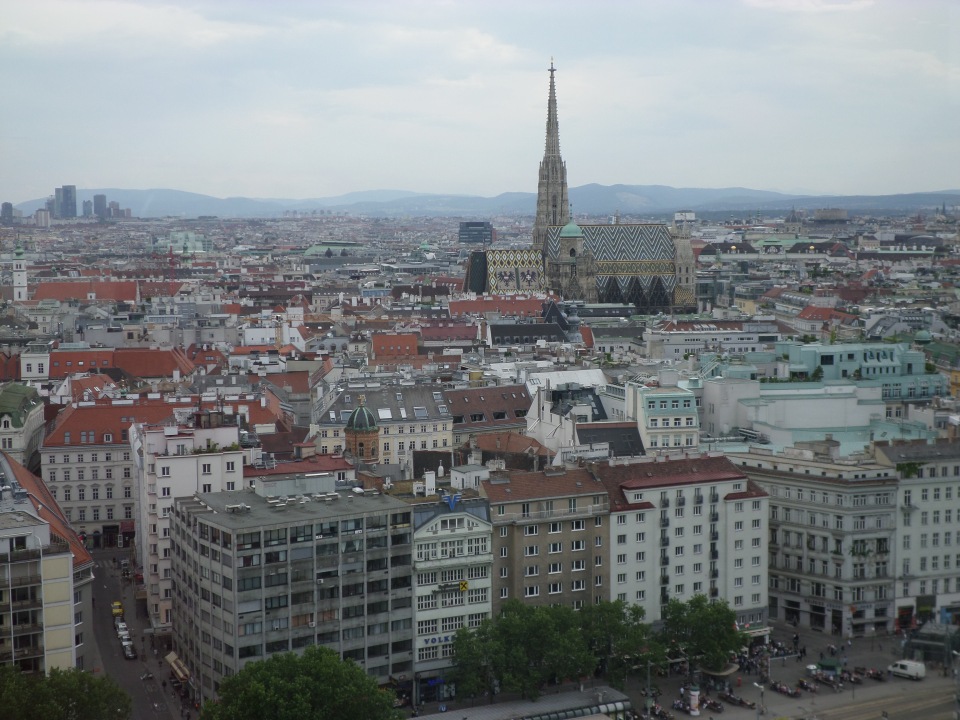
Vienna 5
On Monday, we went on an excursion to the Danube and Melk Abbey, along with 70 odd other tourists. Our joining instruction was to meet at the pink rabbit near the Opera. There is indeed a large pink (fibreglass??) rabbit near the Opera! In fact, we saw a queue getting on a bus across the side street from the rabbit, asked what tour the queue-ees were going on and found it was ours, so joined the queue. There were Vienna Sightseeing employees redirecting tourists from the Rabbit to the bus, as we observed after claiming seats on the upper storey of the bus. It was a double decker coach, and quite comfortable for me, as I am not very tall. Tall persons had little leg room and had to crouch in the aisle as there was not much head room either.
We drove for about 90 minutes to Dürnstein on the Danube, which was clearly also a stopping place for Danube River Cruises, there were four big river cruisers moored there. The village of Dürnstein is walled and overlooked by a ruined castle and a blue painted church, amid vineyards. Very picturesque.
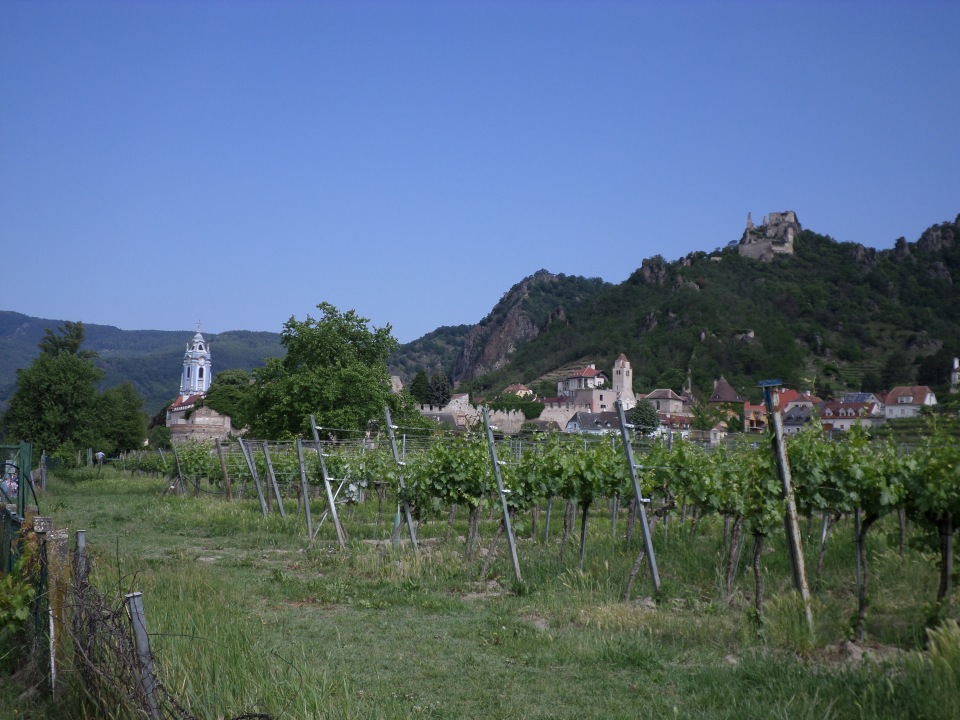
We drove on, along the Danube to Spitz, passing a couple of further villages. At Spitz we loaded onto a smaller day-excursion river boat and enjoyed a further 90 minute ride upstream to Melk. On the way there were more villages and castles. Each village had a tall pole with a pine tree atop it, bedecked in ribbons. Maybe they had something to do with May-day celebrations? The Danube is fairly narrow and swift flowing here, between tree-covered hills and lower slopes of vineyards and fields. As we approached Melk there was an interesting Schloss, but I did not catch its name.
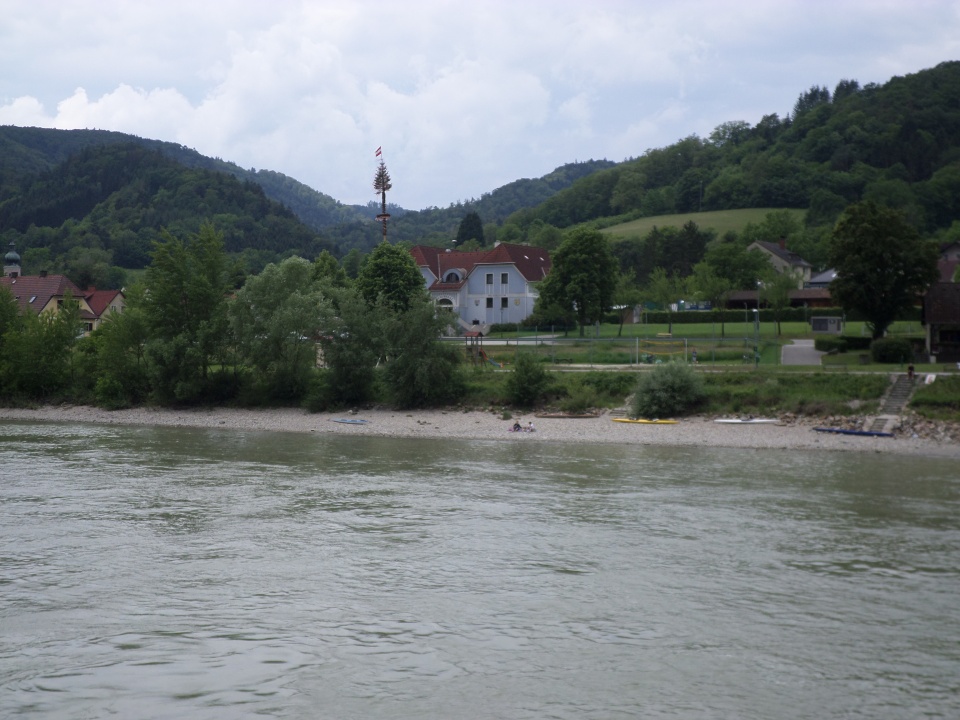

At Melk, our riverboat tied up in a side channel, and we disembarked to be bussed up to the Abbey, high upon a crag over-looking the river. It is huge. Founded by the Benedictine’s in the eleventh century, it was largely rebuilt in the baroque style from 1702 to 1738. The Benedictine rule is pray, work and read. Their attention to education led to the development of a high school within the Abbey, which is still in operation.
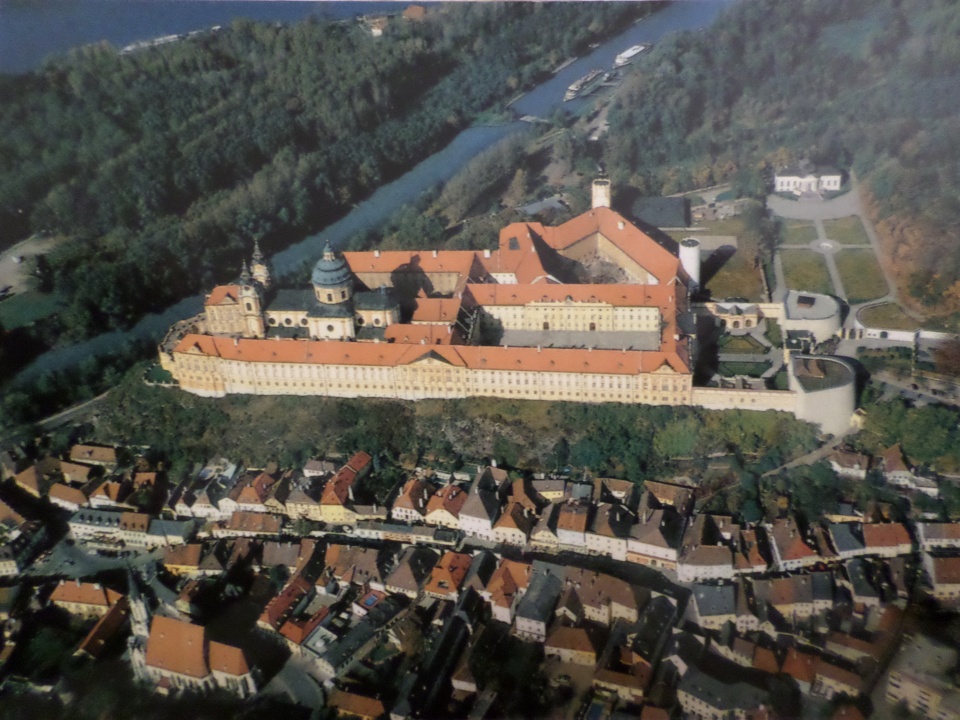
We lunched in the Abbey restaurant – which took our orders and served with remarkable efficiency. Our guided tour started soon after. We were led through the Abbey Museum, in the area that was once the guest rooms. These were approached via the ‘Imperial Staircase’ – so called because Marie Therese once stayed at the Abbey, and it is a rather grand staircase. The museum houses items from the history of the Abbey, reliquaries (one said to hold a piece of the true cross), vestments and paintings. At the very end of this wing is the Marble Hall, a large room lined with (fake) marble, and with a high ceiling that appears even taller due to the trompe l’oeil ceiling painting. The door frames are real marble due to the effect of humidity on the plaster of the fake stuff.
A curved walkway atop a bastion provides a great view of the town of Melk and the river, and links the guest wing to the study wing, and encloses the Abbey church. Balancing the Marble Hall is the Abbey Library, an amazing room housing the Abbeys older books. It, too has trompe l’oeil ceiling paintings The really old manuscripts, however, are kept on the floor below in climate controlled rooms.

From here we descended a cantilevered helical stair to the Church. Richly decorated with lots of gilt, it could be described as Baroque gone mad.
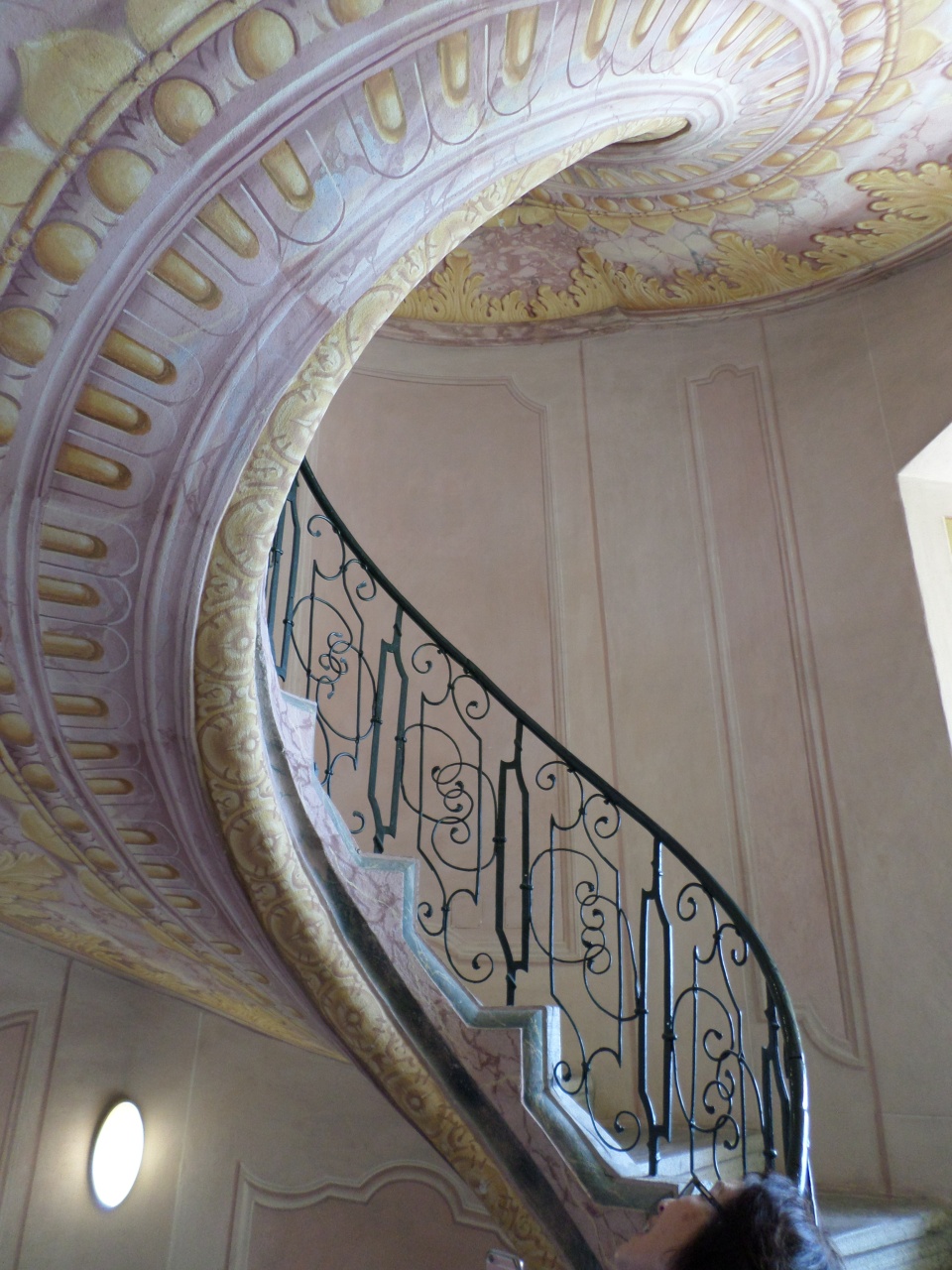
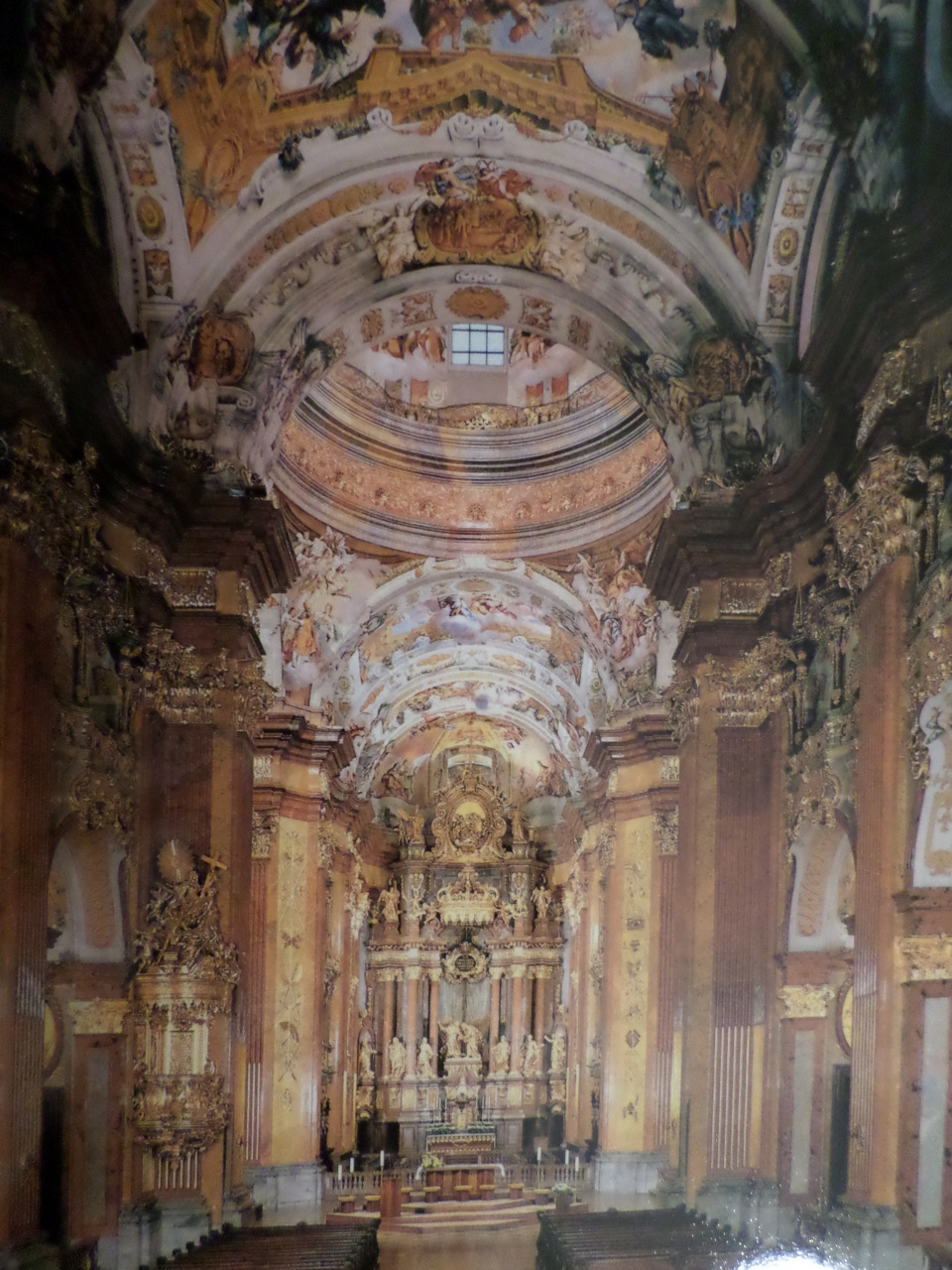
After this, the shop and then an ice-cream on the way back to the bus. It was a quiet trip back to Vienna, little commentary and classical music on the sound system, via the western motorway. This brought us into Vienna along the Vienna River, which appeared as little more than a stream-let in a storm-water drain, with a bike path alongside, and as we neared the city, the U-bahn. We passed Schönbrunn, and shortly after arrived back at the Opera.
Escaping the bus, we walked over to Karlsplatz and the Church, Karlskirche, with its 72 metre copper dome and decorated pillars. Built in 1716 to 1739, it was a thanks offering for delivery from the plague of 1713.
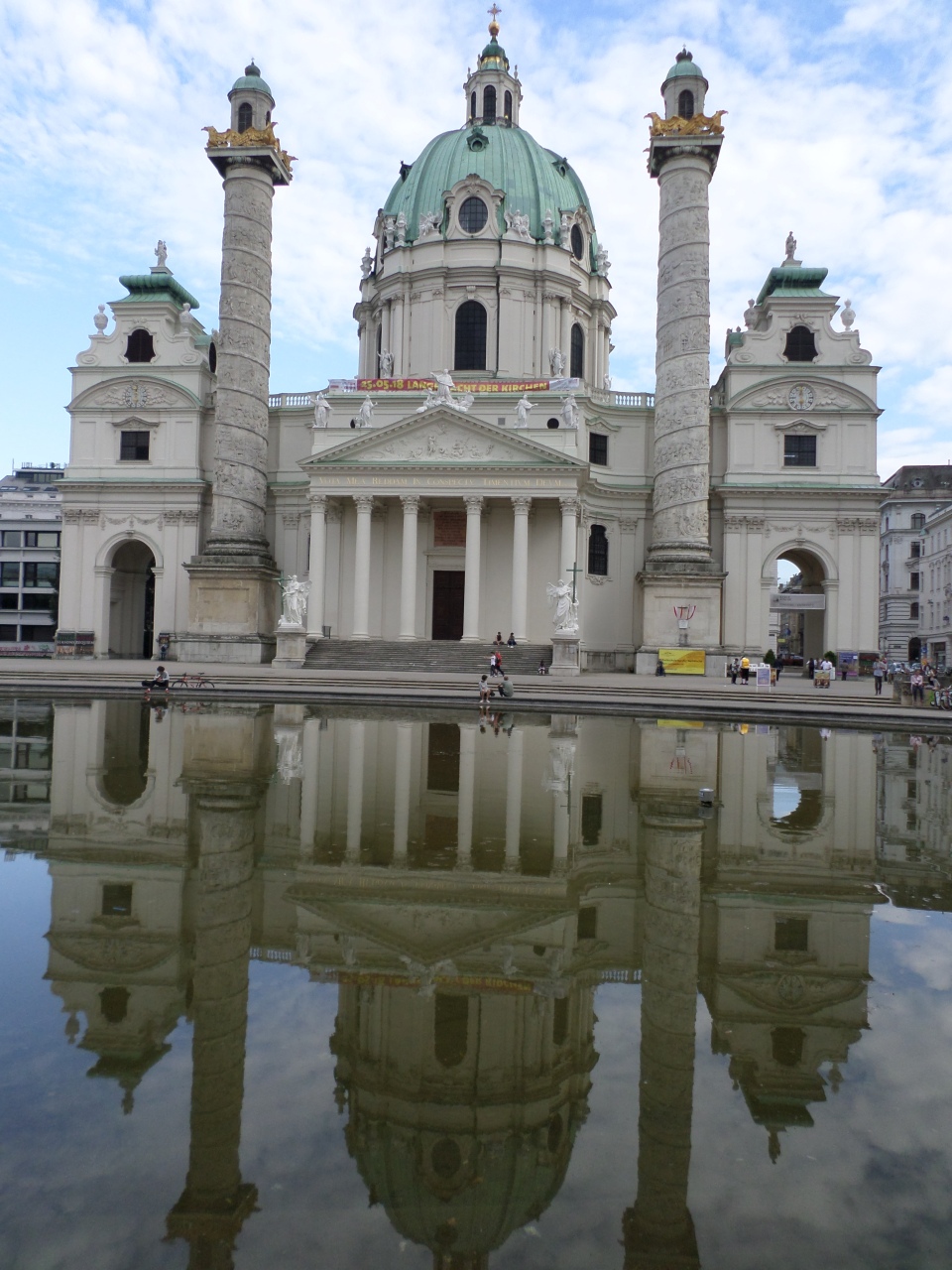
We ate at a nearby restaurant boasting Viennese cuisine. I had a grilled chicken breast with vegetables (lots of vegetables!) and parsley potatoes. Then it was home to our apartment and to bed.
Vienna 4
Today we took one of the hop-on-hop-off buses to Carnuntum and Schloss Hof. It turned out to be a proper coach (rather than the double decker buses on the other routes) and so was quite comfortable. It took about 45 minutes to get to Carnuntum. This is now a town sitting along a ridge above the Danube, south-east of Vienna. Under the north-eastern edge of the town is an old Roman city, and further west, under the present day town, are several Roman forts (according to the model of the area in the tourist access point). Archaeologists are in the process of excavating the old city, progressing along a couple of streets systematically. They have then used Roman building techniques, in a form of experimental archaeology, to reconstruct the buildings as they might have been at the time, using what clues they gained from the finds made during the dig to identify the buildings and give them character. So far there have been two middle-class tradesmen’s homes rebuilt, at least, the ground floor level, because the archaeologists are not convinced about how any upper floor may have looked.
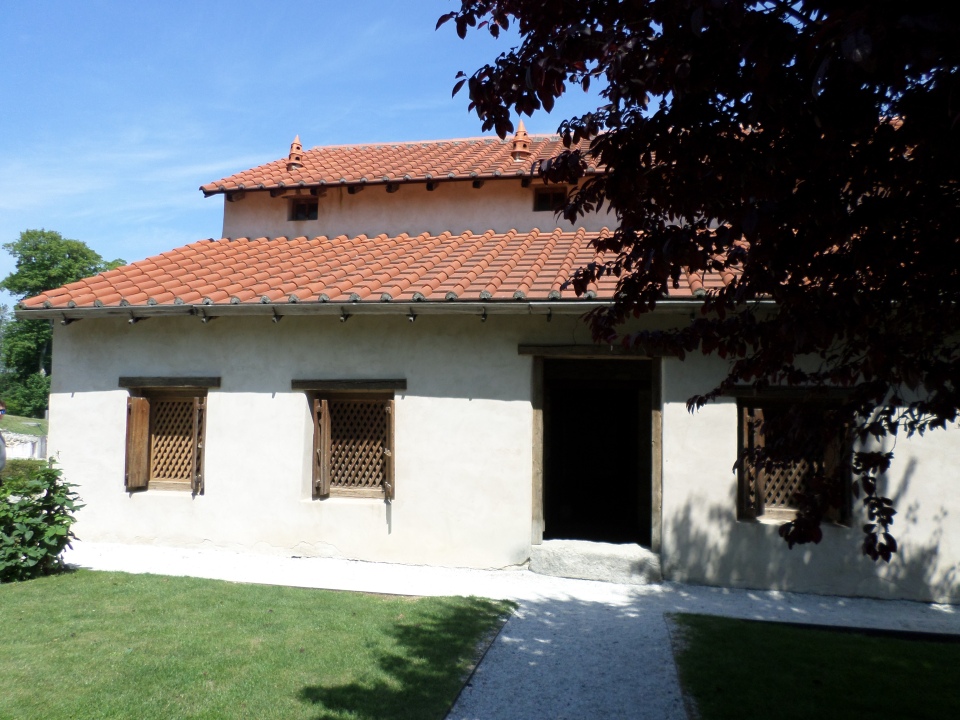
Lower down the slope is a large villa urbana, of a richer family and a reconstructed Roman bath house. It was fascinating to explore the buildings, which as well as being restored had been decorated and furnished as far as possible according to what is known of how the Romans in this sort of area would have lived in the second and third century AD. This included the sorts of vegetables that would have been stored in the kitchens – and these were real veggies, not plastic ones!! There was a woman in Roman dress in the Villa Urbana, explaining the layout and food likely to be served. This Villa had a large main hall with a semi-circular apse at the far end, currently laid out with several tables as if for a feast.
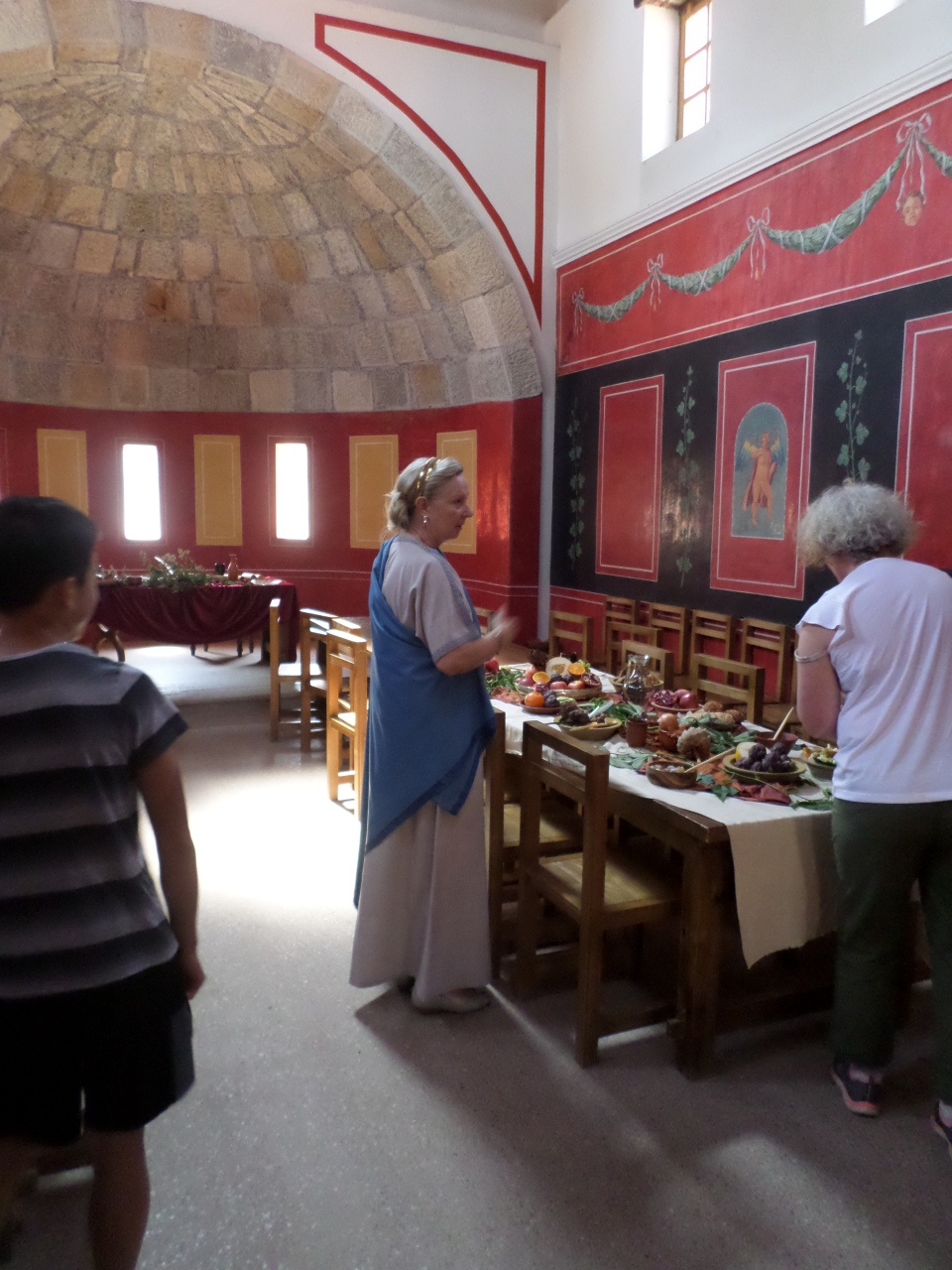
The Bath-house was huge, and the hypocaust was working, so was quite warm as well. Warming the rooms did not require a roaring fire: judging by the smoke from the chimney, the fire was quite modest. From an enclosed stove the smoke and heat moved under the floors then up inside the walls in pipes that led to the chimneys. The rooms were tastefully decorated and furnished, one could see that the locals could have relaxed there happily!
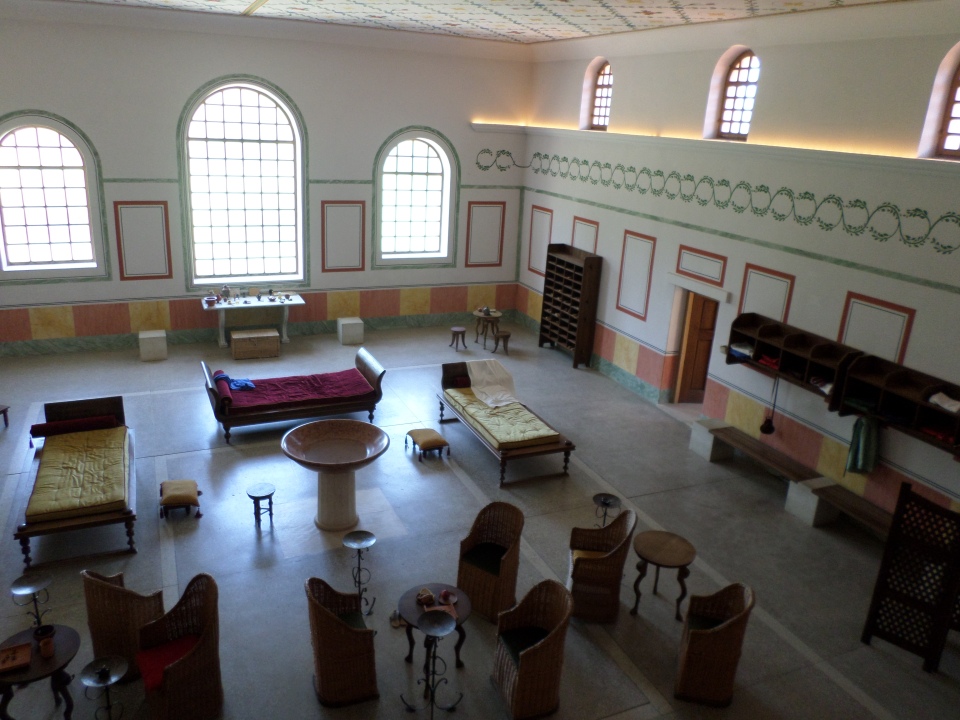
We had time for a salad at the ‘forum culinarium’ (Cafe) unfortunately in a modern looking building! The bus returned on its next circuit so we hopped aboard to go to Schloss Hof. This was a further 25 minutes away to the east, and required crossing the Danube.

Schloss Hof was the summer residence of Prince Eugene of Savoy. He had made his fortune as a military commander against the Turks, when they attempted to advance into Austria’s area of influence in the late 17th century and in the war of the Spanish succession (early 18th). He had the Belvedere built, near Vienna, and had Schloss Hof built as well. It was clearly a working estate, for there are many outbuildings for growing produce and for raising animals. The Schloss itself is an imposing Palace, but is not ‘restored’ in terms of decor or furnishings. We had only 50 minutes to explore so we concentrated on the gardens. These spread over seven terraces, from the entrance buildings at the top, the Palace on terrace two, and descending down the hillside to terrace seven, which is currently being re-planted. Each terrace is faced by a retaining wall and fountains and waterfalls are a central feature of the main axis of the gardens. The slope is roughly south facing, and the Danube flows somewhere in the distance, and beyond it, we could see Bratislavia, a city across the border in Slovakia.
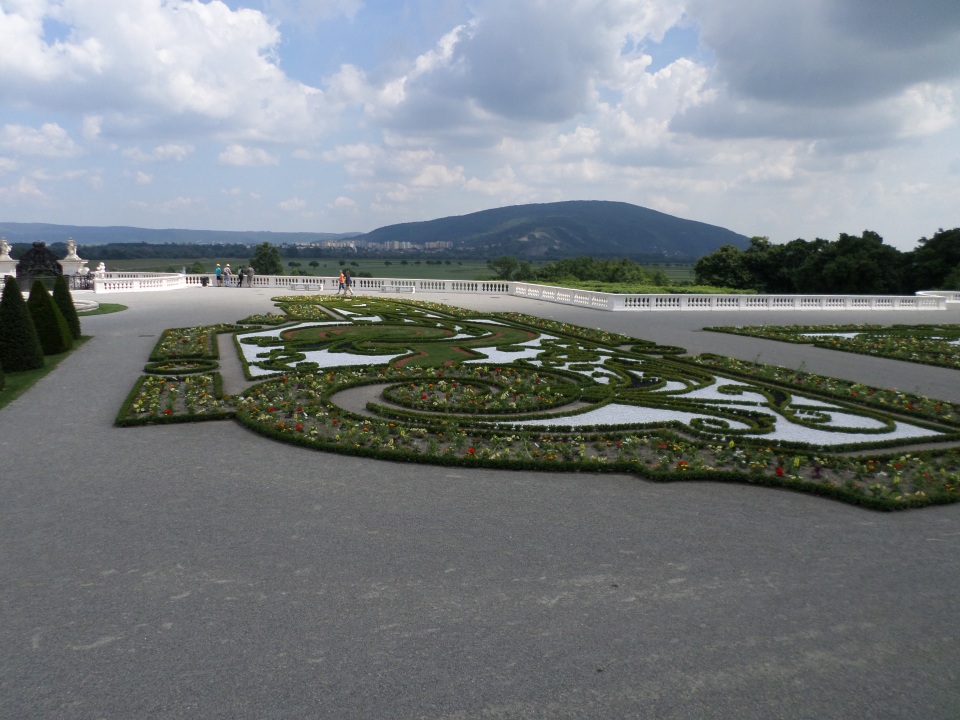
It has clearly been a major restoration effort to get the place back into something approaching its former glory! Much of the stonework in the terraces walls and fountains had to be replaced, and the fountain workings restored. It looks great, now. The re-planting has taken well, and the final terrace will complete that part of the restoration.
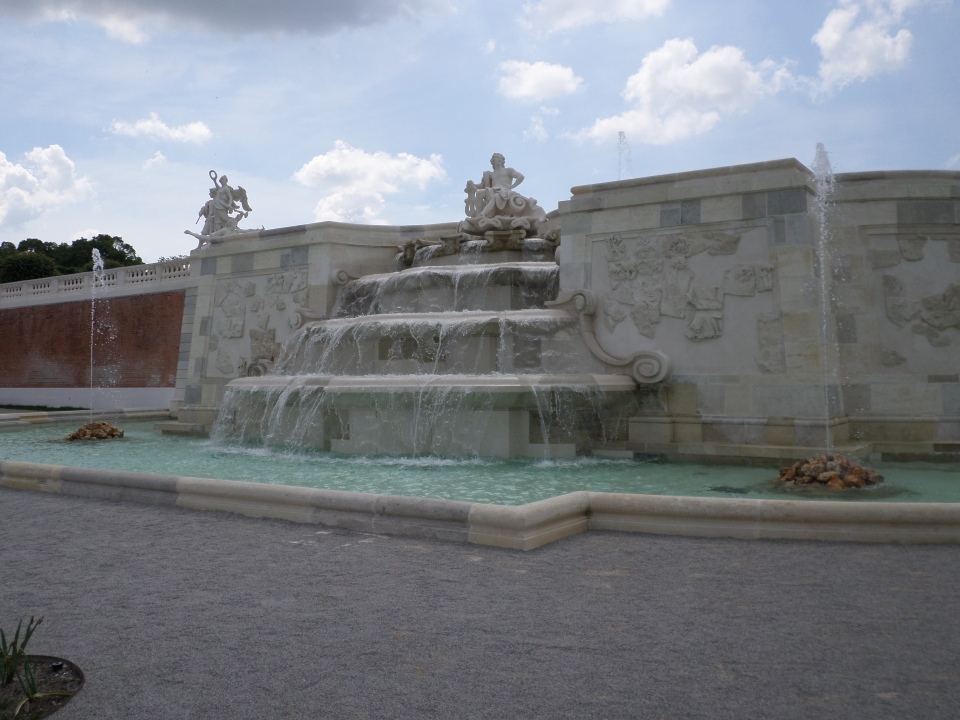
As we did not go inside, except to walk through the centre of the building into the gardens, I do not know what is happening inside the Palace. Currently it is hosting an exhibition on food – what we eat, why and how it is grown. Schloss Hof seems a good place to have this, as the visitors (if they have longer than us!) can also tour the estate farm next to the Schloss, with its green houses and veggie gardens, and examples of rare breeds of sheep, goats and cows more common in earlier centuries. It would be easy to spend a whole day here!
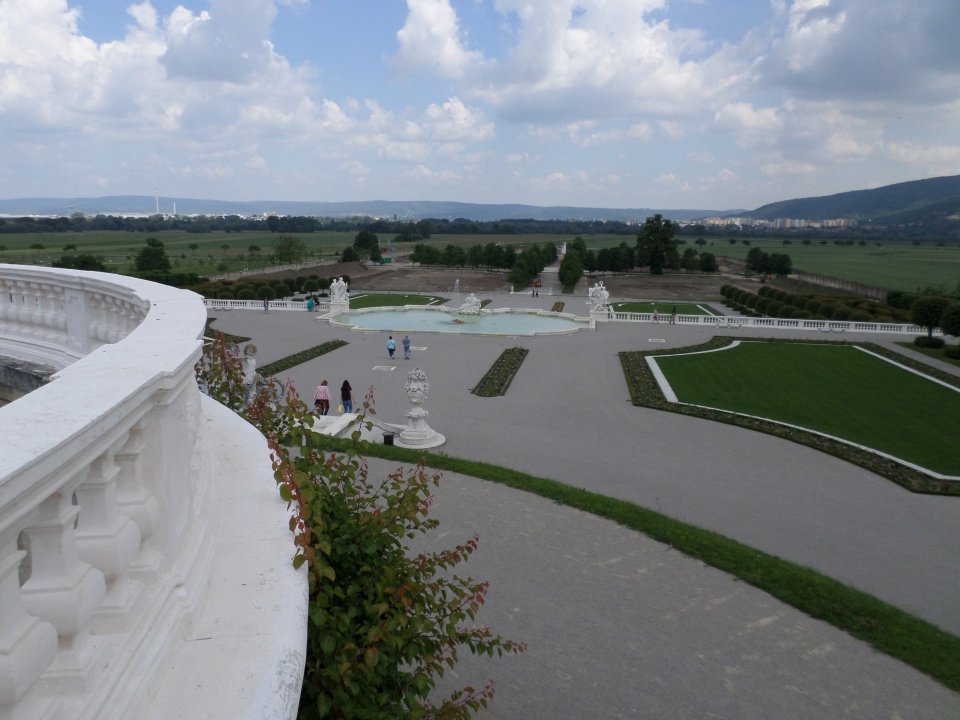
On the way to and from Schloss Hof, the bus stopped at (but we did not go into) Schloss Niederweiden. This is a much smaller Schloss, which also housed part of the “Why do we eat what we do” exhibition.
Back to Vienna, we took ourselves back to the Hofburg area, where there is an area that has been excavated and left pen to show different periods of building, there are some Roman walls, and parts of other building periods as well.
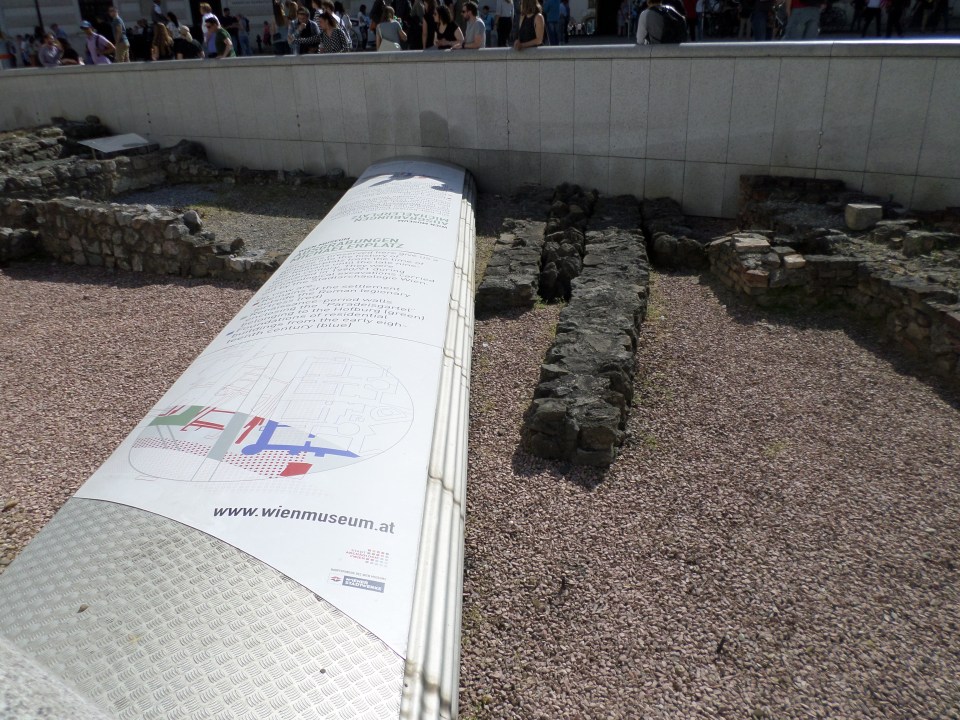
We went into the Church of St Michael (Michaelerkirche) which is plain inside and out, except for some decoration near the altar.
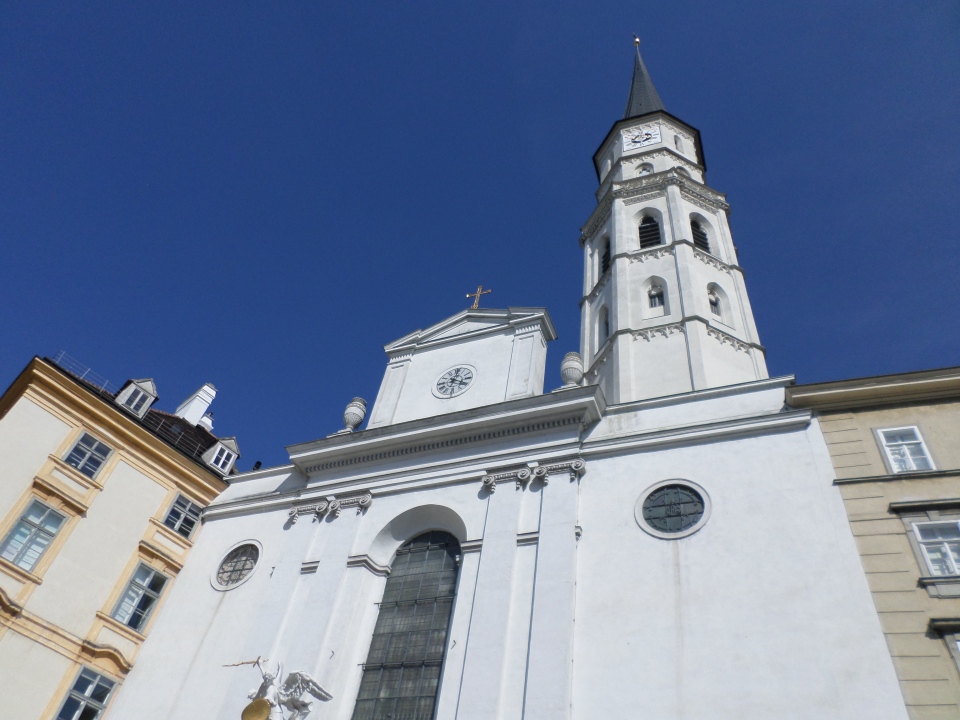
We walked up the Kohlmarkt to a Cafe for a cool drink and cake (a Schokolade Bombe for me). From there we walked along the Graben (“an exclusive and pulsing shopping street in the heart of Vienna”), and admired the large monumental three sided gilded baroque Plague Column (1693). Just back a bit and up a side street we could see (and photograph) Peterskirche. Walking a bit further, we got to the U-bahn and decided that was enough for the day, and headed back to the apartment.
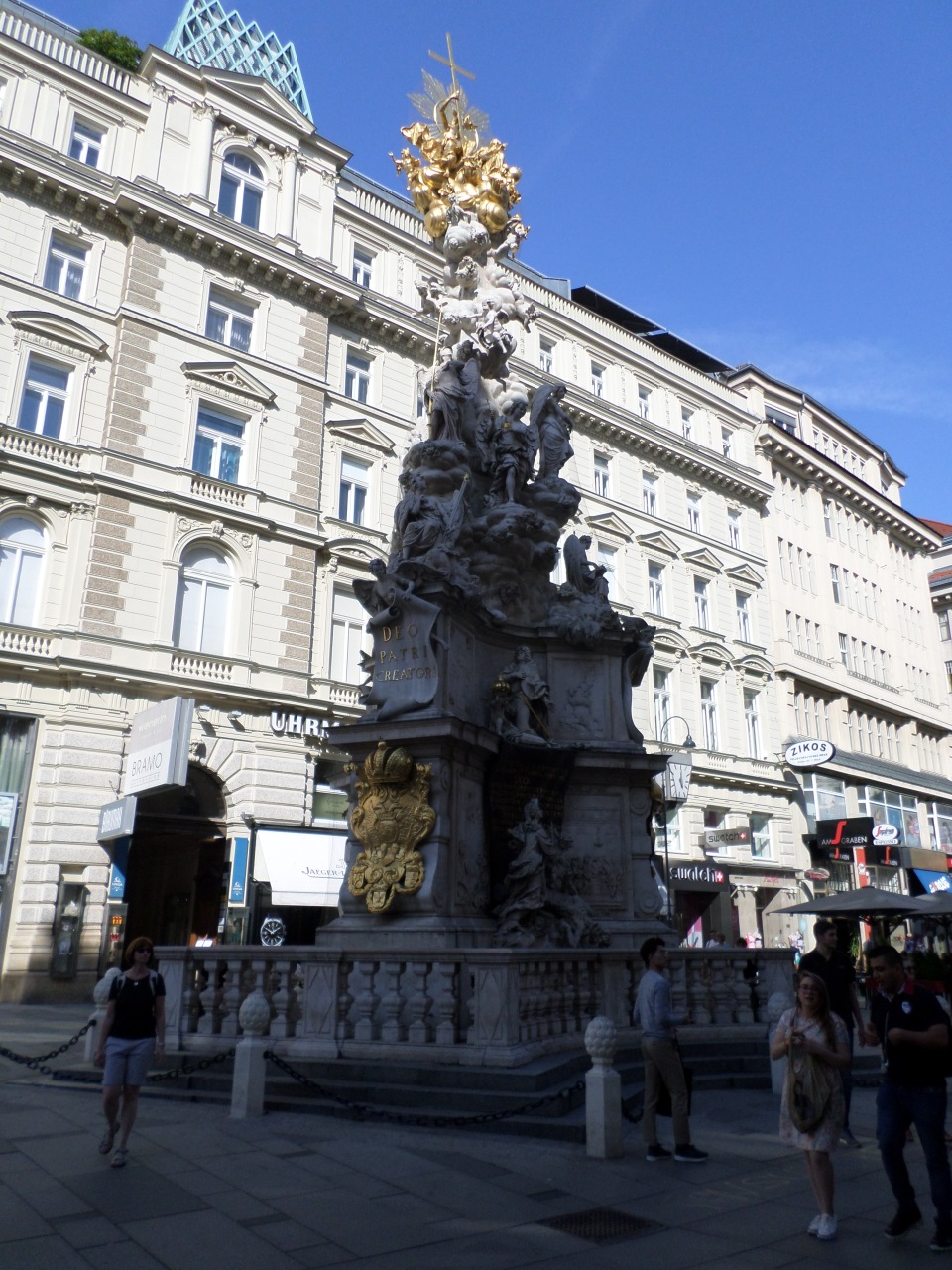
Vienna 3
Saturday in Vienna. We started the day wandering round the streets getting to the Hofburg Palace. On the way we found the sombre memorial to the 65,000 Viennese Jews who were murdered during WWII.
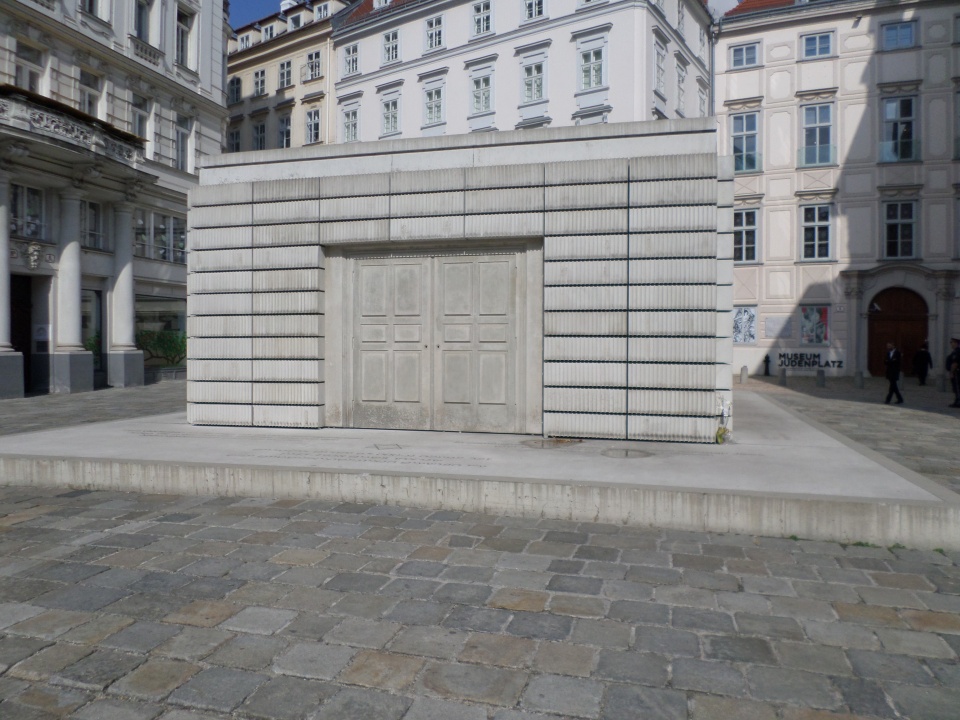
A bit later in the morning we attended a performance by the Spanish Riding School. The Lippizans are beautiful, graceful and very well trained. The performance started with some younger stallions who demonstrated the basics, followed by the older stallions who added half passes, piaffes and flying changes. There was a solo by a rare bay Lippizan, the majority are white or grey. Then the airs above the ground were demonstrated. Here, the stallions were asked to do a levade (a balanced lifting of the front legs off the ground) and the capriole (a leap and kick). The programme finished with a School Quadrille, eight horses and riders performing a well-choreographed display. I really enjoyed the performance! No photography was allowed, but I have the program.

We had some lunch at a cafe in one of the Hofburg Palace courtyards, then went to see the Hofburg Imperial Apartments. We were directed in to see the Imperial Silver Collection first. This is a display of the tableware associated with the court. So there were sets of cutlery, glasses, plates, bowls and serving dishes (both silver and ceramic) and things to decorate the table: epergnes, sweetmeat holders and candle sticks. There was even a set of fine English china that was too delicate to actually use. It had won a prize at the Great Exhibition (in Vienna) and was given to the Emperor as a gift by Queen Victoria.
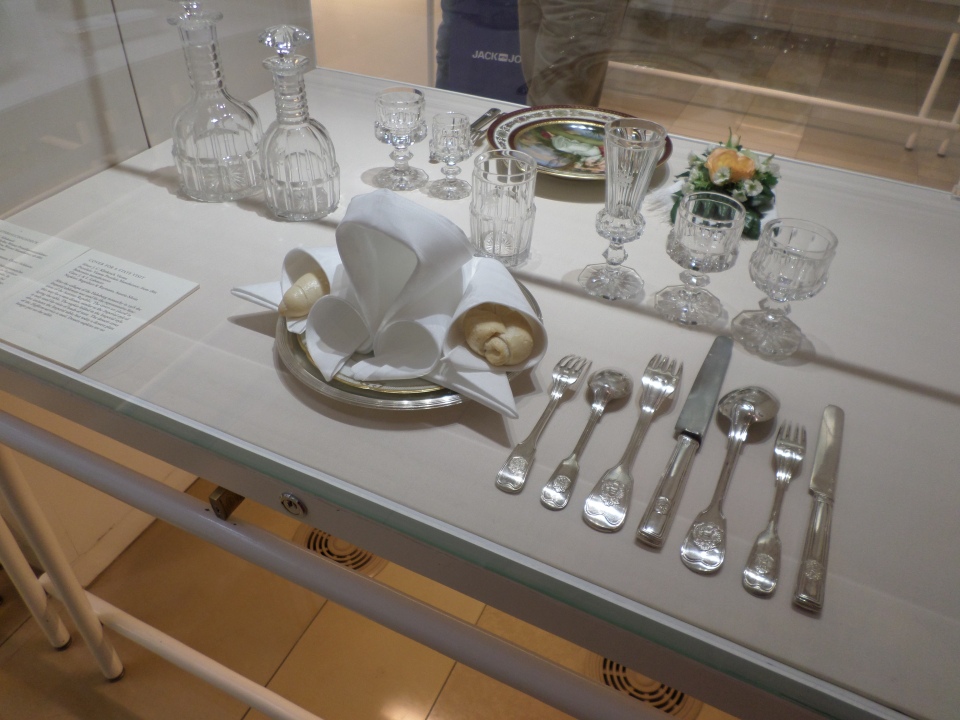

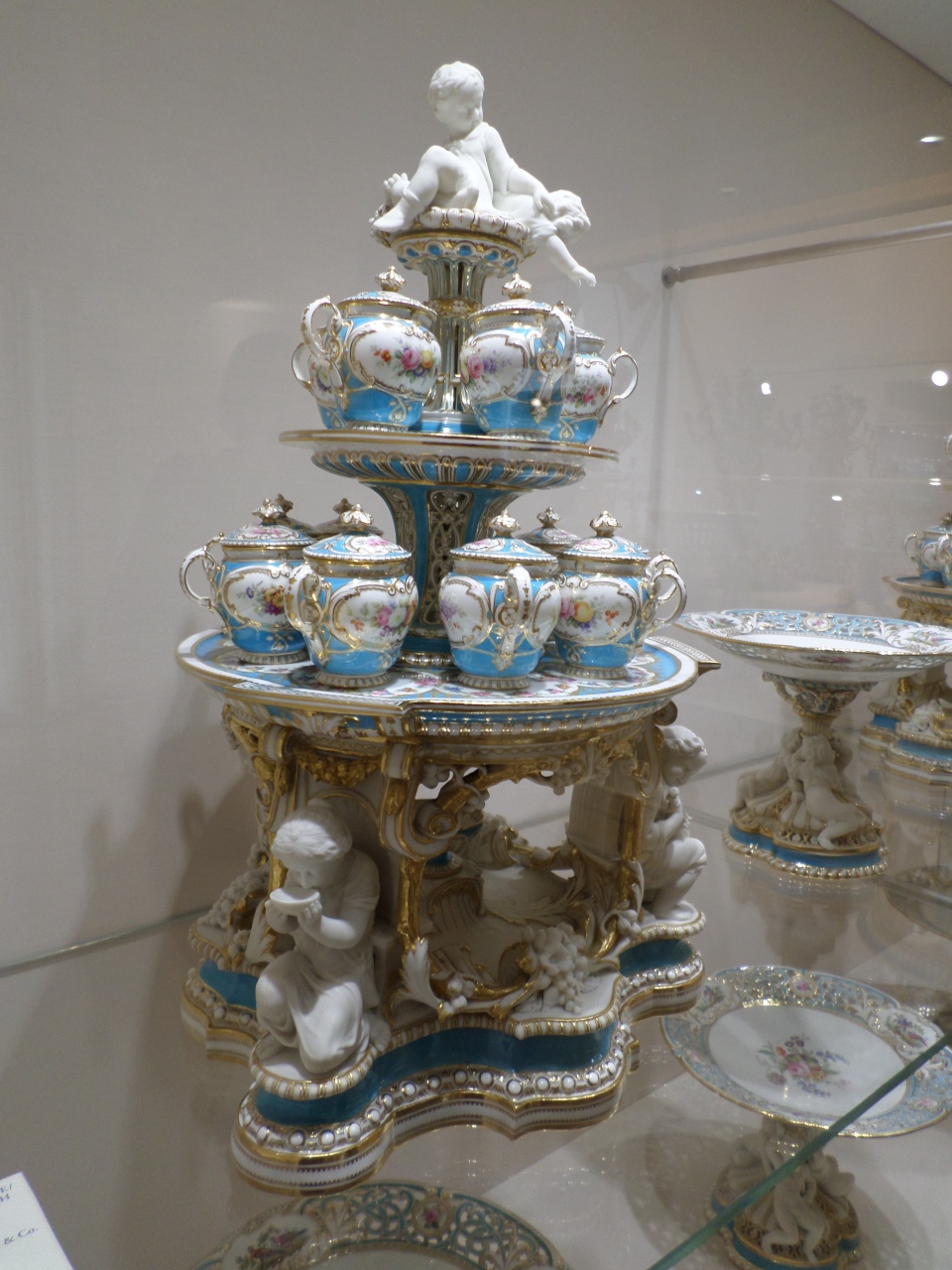
The tour then directed us through the Sisi Museum. This was an over-informative set of rooms dedicated to perpetuating the admiration of Empress Elizabeth (known as Sisi), wife of Emperor Franz Joseph. She was 15 of possibly 16 when she married, and was not used to the strictures of formal Court life. She had a breakdown and was packed off to Madeira to recover. The commentary (we had an audio guide) notes that she returned two years later a changed woman, more self-assured and determined to lead her own life. I just wonder what happened in Madeira! Perhaps it just gave her time to grow up away from observation. It appears that she avoided Court appearances and spent a lot of time away from Vienna, as she got older. She was also reported to be obsessed with keeping her looks and figure. She was assassinated in 1898, by an Italian anarchist.
Finally, we were able to get to the Imperial Apartments, which were arranged much like those in Schönbrunn. In Sisi’s apartments here, however, there was some exercise equipment and an actual bathroom. Franz Josef had a collapsible bath brought into his bedroom, while Sisi had a fitted galvanised copper tub with taps! The apartments are still as left by Franz Josef, because Karl (his successor) used a different suite during his short reign.
After this we walked through the Hofburg, passing the impressive curved facade of another part of the complex, and round to a park where we found a memorial to Mozart.
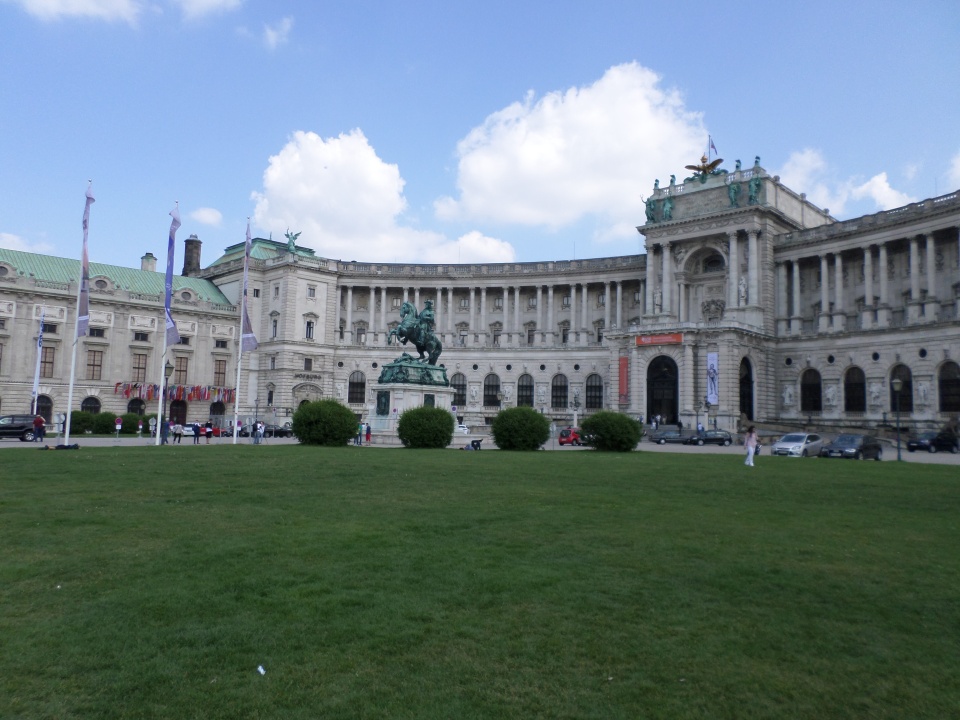

From here we walked across the park to the Albertina, another wing of the Hofburg Palace now an exhibition and event space and art gallery. We were there to see a collection of Impressionist paintings donated to the state by a wealthy collector. There were some good examples by most of the ‘great names’ of Impressionism, Monet, Degas, Renoir etc. There were some later works as well, including some Picassos.
We emerged near the Opera, and found a cafe to sit and consider our next moves, over a cuppa and some sacher torte (very Viennese).
Because of tram rail works, we had not yet seen the facades of the town hall (the Rathaus) and Parliament buildings. The Rathaus is a neo-gothic design, and work was going on clearing up after an event in the forecourt. Opposite the Rathaus we found the State Theatre, also an impressive building. Walking through another park, we were impressed by the seating provided in the parks in Vienna.
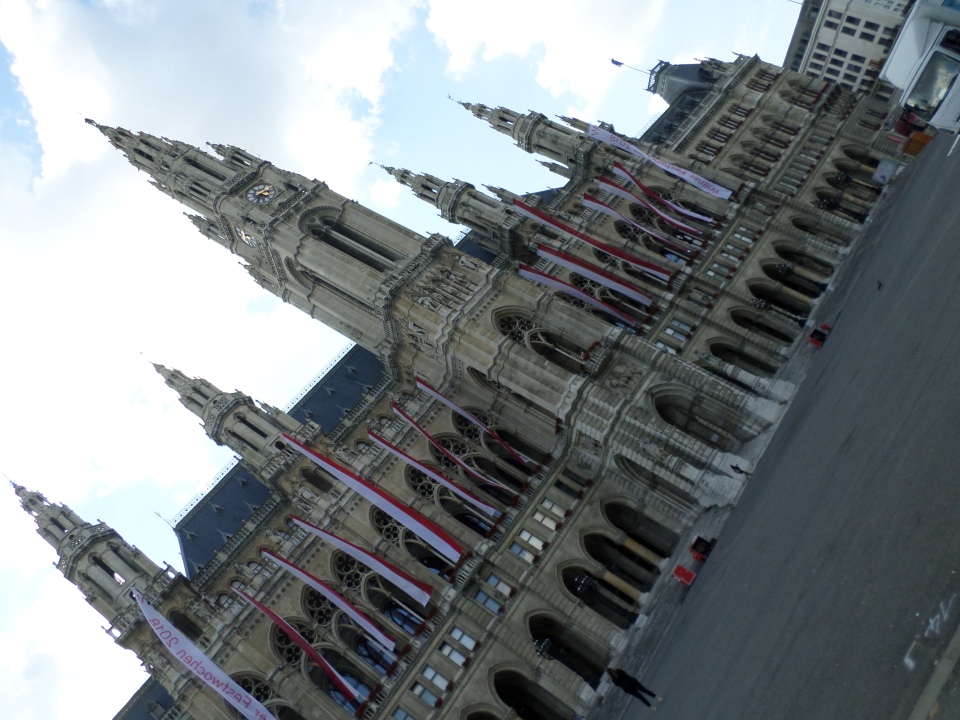
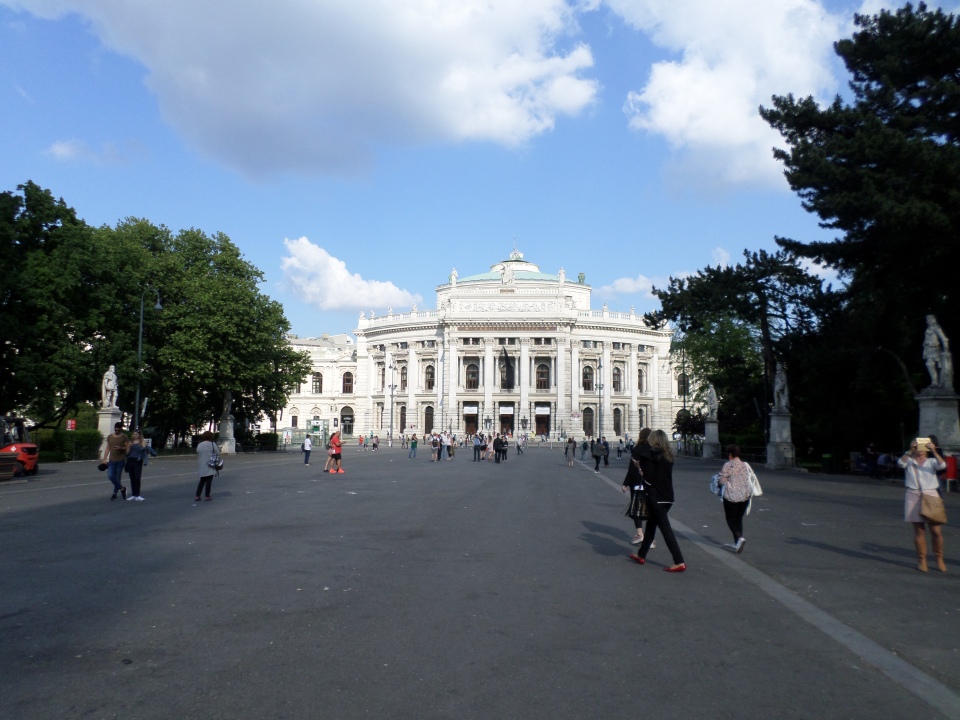

The Parliament building was hidden behind construction equipment and containers piled up probably as the program of works offices. I was just able to take a snap through a gap. The facade is a copy of the Parthenon, right down to the sculpture. The statue of Athena is the centre piece of a fountain, which we were able to see through a viewing window in the publicity office, where an enthusiastic and very kind worker convinced us that we should go on a Democracy Tour! It is scheduled for Tuesday.
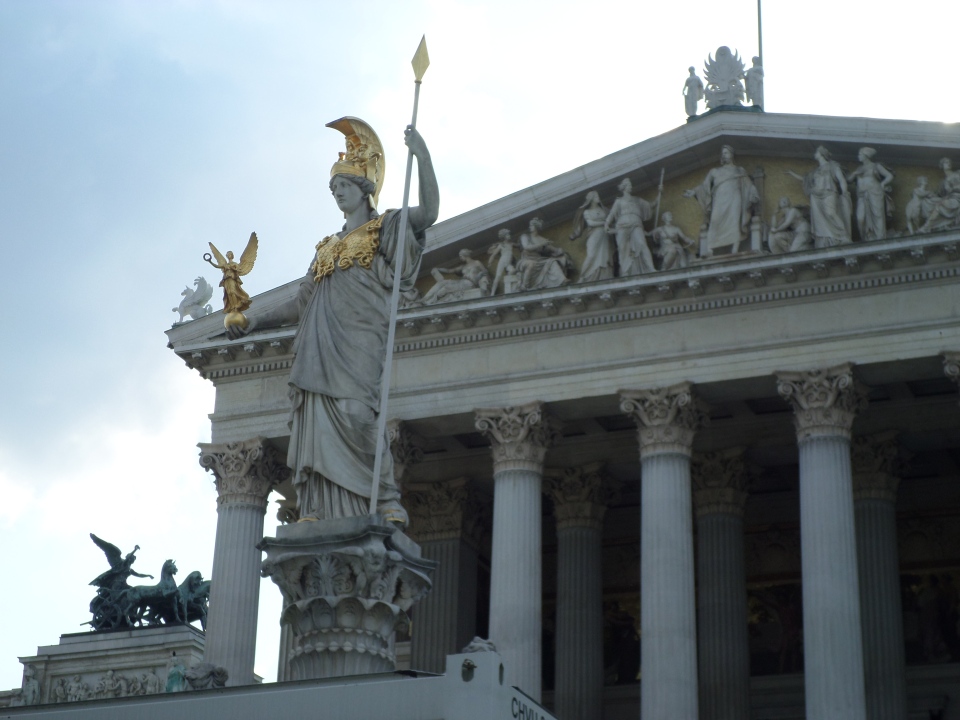
Next stop was the House of Music. We were interested in the classical period of the eighteenth to nineteenth centuries. There were sections of that floor that explained the life and music of some of the great Viennese composers of the period, including Hayden, Mozart, Beethoven, Shubert and Strauss.
By now it was after 7 pm, so we made our way back to the main walking street and found a nice cafe for dinner – steak and chips for me, which included a grilled tomato and a token bit of lettuce leaf. There do not seem to be options for plain cooked vegetables (other than potatoes)! Back to the apartment with just over 13,000 steps for the day.